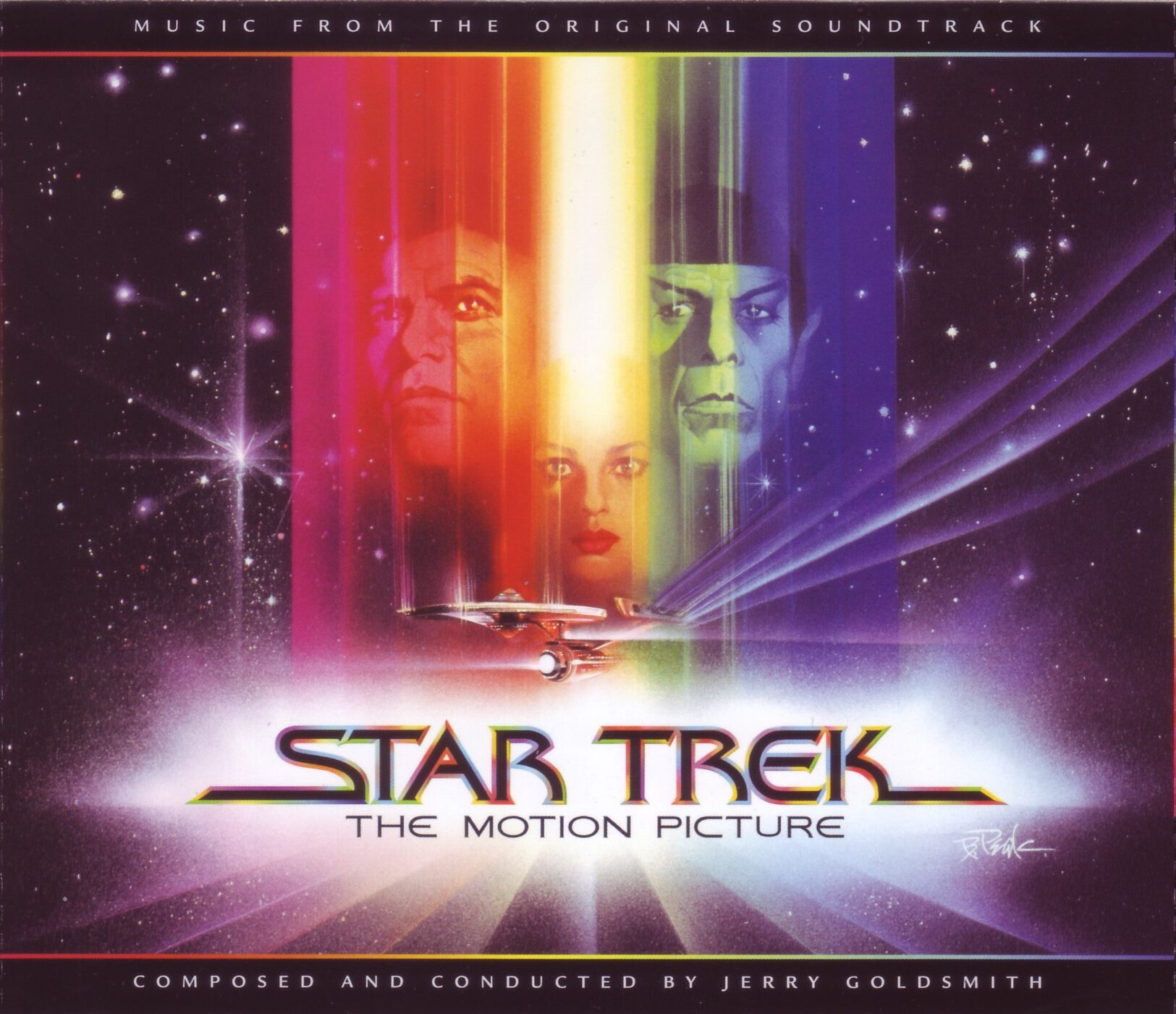
Star Trek: The Motion Picture (Newly Expanded Edition)
The moment that it became crystal clear that all of the Star Trek movies soundtracks would be getting a remastered reissue that included every note of music heard in the movie, one question seemed to be dominating the conversation: “when do we get Star Trek: The Motion Picture?” As various soundtrack boutique labels marched through the Kirk-era Trek film scores, beginning with Star Trek II, that insistent chorus only got louder, usually taking on a disbelieving “Seriously, you’re releasing the soundtrack from [insert Star Trek movie title here] before you do The Motion Picture?”
The answer came only after the rest of the Kirk-era movies’ scores (and the music from the TNG-era movie Star Trek: First Contact had been reissued, and the results were grander than anything fans could’ve asked for, as La-La Land rolled out a lavishly packaged 3-CD extravaganza containing the cues that many fans have been waiting for since 1979.
In the larger context of Goldsmith’s music – whether for film in general or for genre movies in particular – Star Trek: The Motion Picture represents a return to the experimental Goldsmith. After experimenting with synthesizers in the soundtracks of movies such as The Illustrated Man and Logan’s Run, Goldsmith grew disillusioned with what he felt was a limited palette of colors from the new instrument. Trek saw the composer do an abrupt about-face, to the point that some of his later work in the ’80s would be all synth (such as the rejected Alien Nation score), a surprising development for a composer who was famous for making best use of his orchestral resources.
Key to Goldsmith embracing electronics alongside the orchestra once more was the Blaster Beam, a 16-foot machined aluminum slab with strings running its entire length, like a giant guitar fretboard. Struck with an metal artillery shell casing and driven through an amplifier, the Beam lent Trek its most striking sound, a gut-rattling, unearthly reverberation somewhere between an electric guitar and the end of the world. The Beam was built and played by Craig Huxley, nee Hundley, a new age music enthusiast whose previous life as a child actor had included two guest starring roles on the original Star Trek. Also bringing things full circle – out of necessity – were Goldsmith’s two orchestrators, Alexander Courage and Fred Steiner, both of whom had worked extensively on the original TV series.
As pointed out in the extensive liner notes by “The Music of Star Trek” author Jeff Bond, Goldsmith originally had very little actual film to work with, composing material with an absolute lack of any effects sequences. In a way this was freeing, but also frustrating: all the esteemed composer had to work with were timings from the film’s editors. Then, once the effects were completed, there was an incredible time crunch to finish the movie – and its music – in time for the set-in-stone December 1979 premiere. Goldsmith had to rely on Courage and Steiner to “ghost write” sequences in the style Goldsmith had already established. This material included Goldsmith-style renditions of the original Star Trek TV theme arranged by its original composer, Alexander Courage, oft-requested but never released on any of the prior CD releases of Trek‘s soundtrack. The previously released editions (this is the third) leaned almost entirely on material that Goldsmith had originated, so this set marks the first release for nearly half of the movie’s soundtrack.
And it keeps getting better. The second disc features rejected music for the first 1/3 of the over-two-hour movie – the bulk of it originating from the early sessions where Goldsmith had no visuals to work with. In these early pieces, the Enterprise theme is not fully formed, and the drydock sequence features delicate, almost-fairy-like music that runs completely counter to the power and majesty of the music that would finally grace that pivotal scene. Filling out disc two is a remastered version of the original 1979 soundtrack LP release, much of which draws from “takes” that were not used in the movie itself.
The third disc features alternates, out-takes and raw studio tapes, including the first-ever recording of the theme that Goldsmith composed in the wake of director Robert Wise’s complaint that his film had no discernable main theme. That the resulting piece of music went on to represent Star Trek in future film installments and as the main theme of Star Trek: The Next Generation is significant; despite its fleeting appearances in this movie’s score, Alexander Courage’s ’60s-flavored television theme had been supplanted, and the entire franchise had new theme music.
Trek was released in 1979, and, like Star Wars before it, was undeniably a disco-era movie. The producers of this soundtrack gleefully embrace that with two slices of ’70s-style ephemera that were released at the same time as the movie itself: Bob James’ disco-fied jazz-with-synthesizers cover of Goldsmith’s main theme, and the gloriously cheesy train wreck that is teen crooner Shaun Cassidy’s earnestly-performed “A Star Beyond Time,” featuring schmaltzy love song lyrics laid over the love theme for Lt. Ilia (a character whose storyline in the movie didn’t really merit a love theme, but Paramount brass had decreed that the movie would have a love theme in the vein of “Princess Leia’s Theme” from Star Wars). Cassidy’s contribution to the Star Trek music archives is endearingly over-the-top – it’s so bad I almost find myself liking it.
Fans have been clamoring for the complete, unshortened score to this entire movie practically since the movie was in theaters, and while the original 1979 soundtrack was nothing to sneeze at – actually, it’s  one of the best-judged assemblies of highlights from a movie score ever to see release, even in its abridged original form – this new set leaves the fans nothing to ask for. (I’d say it leaves them nothing to complain about, but hey, we’re talking Star Trek fans here.) There’s an embarrassment of riches of new material, all of which demonstrates the staggering pressures and considerable talent brought to bear on the music for Star Trek’s first big-screen outing. Somehow, the pressure cooker and the incredible instincts of Jerry Goldsmith and his cohorts resulted in a soundtrack that’s arguably better than the movie it comes from, and a soundtrack that still towers over the landscape of film music today. There’s never been anything quite like it since.
one of the best-judged assemblies of highlights from a movie score ever to see release, even in its abridged original form – this new set leaves the fans nothing to ask for. (I’d say it leaves them nothing to complain about, but hey, we’re talking Star Trek fans here.) There’s an embarrassment of riches of new material, all of which demonstrates the staggering pressures and considerable talent brought to bear on the music for Star Trek’s first big-screen outing. Somehow, the pressure cooker and the incredible instincts of Jerry Goldsmith and his cohorts resulted in a soundtrack that’s arguably better than the movie it comes from, and a soundtrack that still towers over the landscape of film music today. There’s never been anything quite like it since.
Disc One
The Film Score- Overture (1:43)
- Main Title / Klingon Battle (7:01)
- Total Logic (3:54)
- Floating Office (1:08)
- The Enterprise (6:02)
- Malfunction (1:30)
- Goodbye Klingon / Goodbye Epsilon Nine / Pre-Launch (2:10)
- Leaving Drydock (3:32)
- TV Theme / Warp Point Eight (0:50)
- No Goodbyes (0:53)
- Spock’s Arrival (2:03)
- TV Theme / Warp Point Nine (1:49)
- Meet V’Ger (3:06)
- The Cloud (5:05)
- V’Ger Flyover (5:01)
- The Force Field (5:07)
- Micro Exam (1:13)
- Games/Spock Walk (9:51)
- System Inoperative (2:03)
- Hidden Information (3:58)
- Inner Workings (4:04)
Disc Two
- V’Ger Speaks (4:04)
- The Meld/A Good Start (5:37)
- End Title (3:16)
The Unused Early Score
- The Enterprise early version (6:05)
- Leaving Drydock early version (2:39)
- No Goodbyes early version (0:55)
- Spock’s Arrival early version (2:00)
- Micro Exam early version (1:15)
- Games early version (3:49)
- Inner Workings early version (4:43)
The 1979 Soundtrack Album
- Main Title / Klingon Battle (6:50)
- Leaving Drydock (3:29)
- The Cloud (5:00)
- The Enterprise (5:59)
- Ilia’s Theme (3:00)
- Vejur Flyover (4:56)
- The Meld (3:15)
- Spock Walk (4:17)
- End Title (3:16)
Disc Three
Alternates- Overture long version (2:50)
- Main Title alternate take (1:44)
- Total Logic alternate take (3:49)
- Malfunction early take (1:28)
- Goodbye Klingon alternate take (0:35)
- No Goodbyes alternate take (0:53)
- Spock’s Arrival alternate take (2:01)
- The Force Field alternate take (5:04)
- Micro Exam alternate take (1:14)
- Games early synthesizer version (3:48)
- Games alternate take (3:48)
- Inner Workings alternate take (4:05)
- V’Ger Speaks alternate take (4:03)
- The Meld film version (3:16)
- A Good Start discrete (2:27)
- Main Title album take (1:44)
Additional Music
- Main Title first raw takes (7:21)
- The Force Field / The Cloud excerpts (2:33)
- Beams and Synthesizer for V’Ger 4:04)
- Beams and Synthesizer for Ilia 0:59)
- Synthesizer for Main Theme 1:44)
- Main Theme From Star Trek: The Motion Picture performed by Bob James (5:24)
- A Star Beyond Time performed by Shaun Cassidy (2:43)
- Ilia’s Theme alternate (3:33)
- Theme From Star Trek: The Motion Picture concert edit (3:25)
Released by: La-La Land Records
Release date: 2012
Disc one total running time: 72:06
Disc two total running time: 74:31
Disc three total running time: 74:37

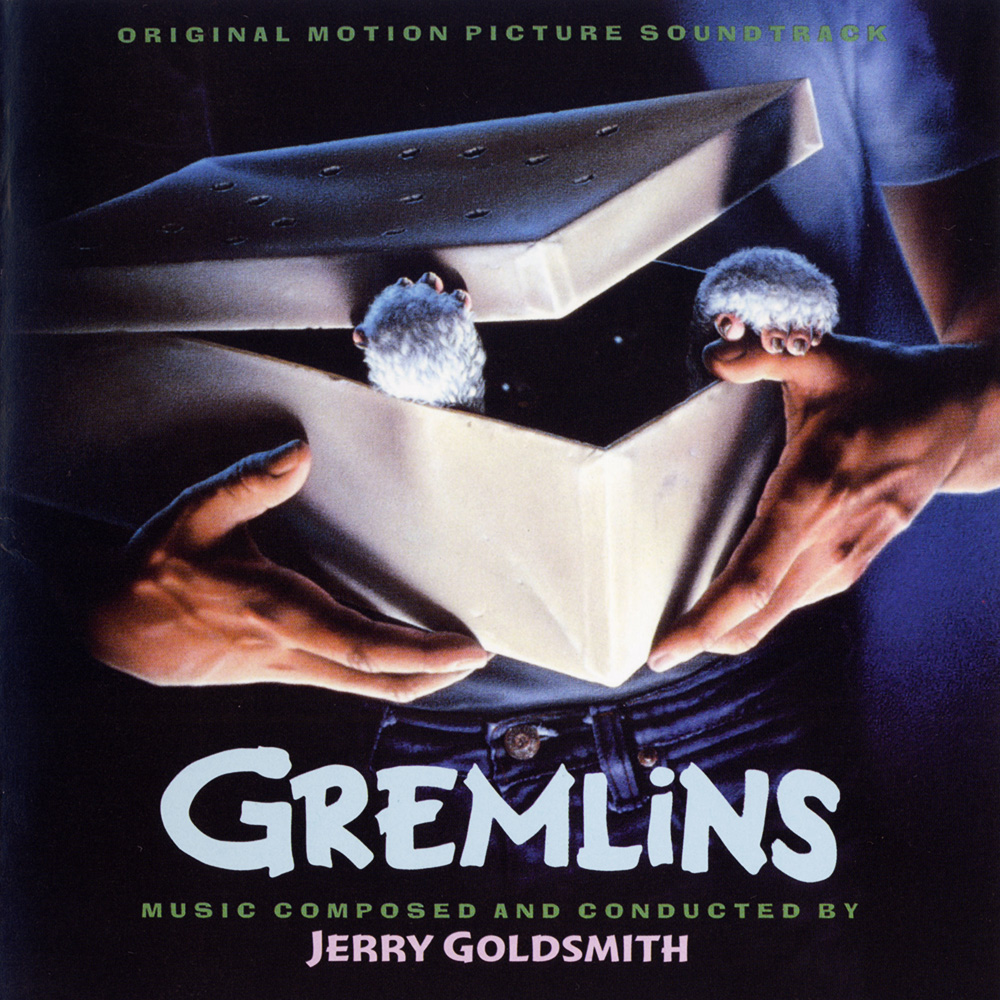
Gremlins – music by Jerry Goldsmith
 Horror and comedy are two film genres that many have tried to mix, but few have managed to meld successfully. Part of the problem is that horror films tend to fall into one of two categories: so overbaked as to be almost unintentionally funny, or so repulsive as to strip even the slightest opportunity for humor out of the proceedings. If you try to add “widespread popular appeal” to the mix, you’re begging for trouble, because that all but violates the Prime Directive of making a horror flick. One of the very few movies to have landed right in the middle of that improbable Venn diagram was 1984’s Gremlins, directed by Joe Dante and produced by Steven Spielberg. Gremlins manages to be funny – and even endearingly sweet – and scary all at the same time. And as for popular appeal, the last time my son and I ventured through the toy aisle, we spotted freshly-minted, newly-produced Gremlins figures on the store shelves. Not bad for a movie that’s nearly 30 years old, even if I did have to explain that the movie that they’re from is too rich for his blood since he’s only 4 years old.
Horror and comedy are two film genres that many have tried to mix, but few have managed to meld successfully. Part of the problem is that horror films tend to fall into one of two categories: so overbaked as to be almost unintentionally funny, or so repulsive as to strip even the slightest opportunity for humor out of the proceedings. If you try to add “widespread popular appeal” to the mix, you’re begging for trouble, because that all but violates the Prime Directive of making a horror flick. One of the very few movies to have landed right in the middle of that improbable Venn diagram was 1984’s Gremlins, directed by Joe Dante and produced by Steven Spielberg. Gremlins manages to be funny – and even endearingly sweet – and scary all at the same time. And as for popular appeal, the last time my son and I ventured through the toy aisle, we spotted freshly-minted, newly-produced Gremlins figures on the store shelves. Not bad for a movie that’s nearly 30 years old, even if I did have to explain that the movie that they’re from is too rich for his blood since he’s only 4 years old.
Helping to sweeten the movie’s cute moments and lend bite to the scarier scenes was an outstanding Jerry Goldsmith score. Always experimenting with unconventional instrumentation and electronics, Goldsmith was firmly into a phase of adding off-the-shelf synthesizers to the usual orchestral palette. Early samplers were also in play here, adding strange howling-cat noises and an almost-funny “Gremlin chorus” to numerous scenes where appropriate. Film Score Monthly’s 2-disc set corrects one of the longest-standing gaps in commercially-available film music by presenting the full score, alongside the remastered-for-CD “mini-album” released in 1984 which was previously the only way to hear any of the movie’s score. (As it turns out, even the barely-adequate mini-album has its charms, of which more in a moment.)
Goldsmith’s music for Gizmo, the adorable Mogwai who was the movie’s most marketable image, reinforces the adorable part,
Of course, once Gizmo’s kids have their fateful post-midnight snack, Goldsmith gets into more, well, Goldsmithian material. The first strains of the “Gremlins Rag” – heard in full in the movie’s end 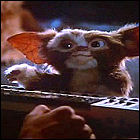 credits – are heard in an off-kilter, almost toy-piano style as Billy’s mother gets her first look at the grotesquely mutated pods. Once these hatch, all hell breaks loose and Goldsmith upends his entire toybox on us, frequently using the unearthly cat-howl sample mentioned earlier. That occurs through several vignettes early in the Gremlins’ spree of mischief, but once that becomes an all-out reign of terror that threatens to raze the entire town to the ground, the music officially goes balls-to-the-wall. “Too Many Gremlins” would be an epic orchestral music cue for any horror movie, but it helps to sell the Gremlins as a serious threat here (don’t forget, the movie was made in 1984, and its effects were limited to the state of the art of puppetry and animatronics in 1984 – the music had a lot of work to do in making the Gremlins a credible hazard). (That being said, I’m glad that Gremlins has been neither remade nor – shudder – CGI “enhanced” in the years since it was made.)
credits – are heard in an off-kilter, almost toy-piano style as Billy’s mother gets her first look at the grotesquely mutated pods. Once these hatch, all hell breaks loose and Goldsmith upends his entire toybox on us, frequently using the unearthly cat-howl sample mentioned earlier. That occurs through several vignettes early in the Gremlins’ spree of mischief, but once that becomes an all-out reign of terror that threatens to raze the entire town to the ground, the music officially goes balls-to-the-wall. “Too Many Gremlins” would be an epic orchestral music cue for any horror movie, but it helps to sell the Gremlins as a serious threat here (don’t forget, the movie was made in 1984, and its effects were limited to the state of the art of puppetry and animatronics in 1984 – the music had a lot of work to do in making the Gremlins a credible hazard). (That being said, I’m glad that Gremlins has been neither remade nor – shudder – CGI “enhanced” in the years since it was made.)
The second disc will either be a jolt of harmless ’80s nostalgia, or a collection-completer. It’s hard to trawl through theLogBook.com’s music reviews without picking up on me being a Peter Gabriel fan, and the inclusion of “Out Out” may just be that song’s first official appearance on CD, and it’s a notoriously hard-to-find piece from Gabriel’s early career, not having appeared on any of his albums to date, right in the middle of the four-year gap between Security and So. For that alone, this is one “contractually obligated re-release of the original album” (a bugbear of these classic soundtrack remasters) I’ll let them skate by with.
 It’s amazing that so much of one of Jerry Goldsmith’s most memorable scores had to wait this long for an official release, but the sound quality and the abundance of previously unreleased material make Gremlins worth the wait.
It’s amazing that so much of one of Jerry Goldsmith’s most memorable scores had to wait this long for an official release, but the sound quality and the abundance of previously unreleased material make Gremlins worth the wait.
Disc One: The Film Score
- Fanfare in C / The Shop / The Little One (4:30)
- Late for Work (1:46)
- Mrs. Deagle / That Dog (2:22)
- The Gift (1:45)
- First Aid (2:17)
- Spilt Water (3:02)
- A New One (1:10)
- The Lab / Old Times (2:35)
- The Injection (2:56)
- Snack Time / The Wrong Time (1:49)
- The Box (1:24)
- First Aid (1:39)
- Disconnected / Hurry Home (1:03)
- Kitchen Fight (4:06)
- Dirty Linen (0:43)
- The Pool (1:07)
- The Plow / Special Delivery (1:16)
- High Flyer (2:22)
- Too Many Gremlins (2:06)
- No Santa Claus (3:27)
- After Theatre (1:39)
- Theatre Escape / Stripe Is Loose / Toy Dept. / No Gizmo (4:36)
- The Fountain / Stripe’s Death (5:42)
- Goodbye, Billy (2:56)
- End Title / The Gremlin Rag (4:10)
Bonus Tracks
- Blues (2:17)
- Mrs. Deagle film version (1:27)
- God Rest You Merry, Gentlemen (1:12)
- After Theatre (With “Silent Night”) (1:36)
- After Theatre (Without “Silent Night”) (1:36)
- Rabbit Rampage composed by Milt Franklyn (0:47)
- The Gremlin Rag full version (3:35)
- Gizmo’s New Song (0:35)
- Gizmo’s Trumpet (0:30)
Disc Two: 1984 Soundtrack Album
- Gremlins…Mega Madness performed by Michael Sembello (3:52)
- Make It Shine performed by Quarterflash (4:11)
- Out Out performed by Peter Gabriel (7:02)
- The Gift (4:58)
- Gizmo (4:14)
- Mrs. Deagle (2:54)
- The Gremlin Rag (4:13)
Released by: Film Score Monthly / Retrograde Records
Release date: 2011
Disc one total running time: 76:01
Disc two total running time: 31:25
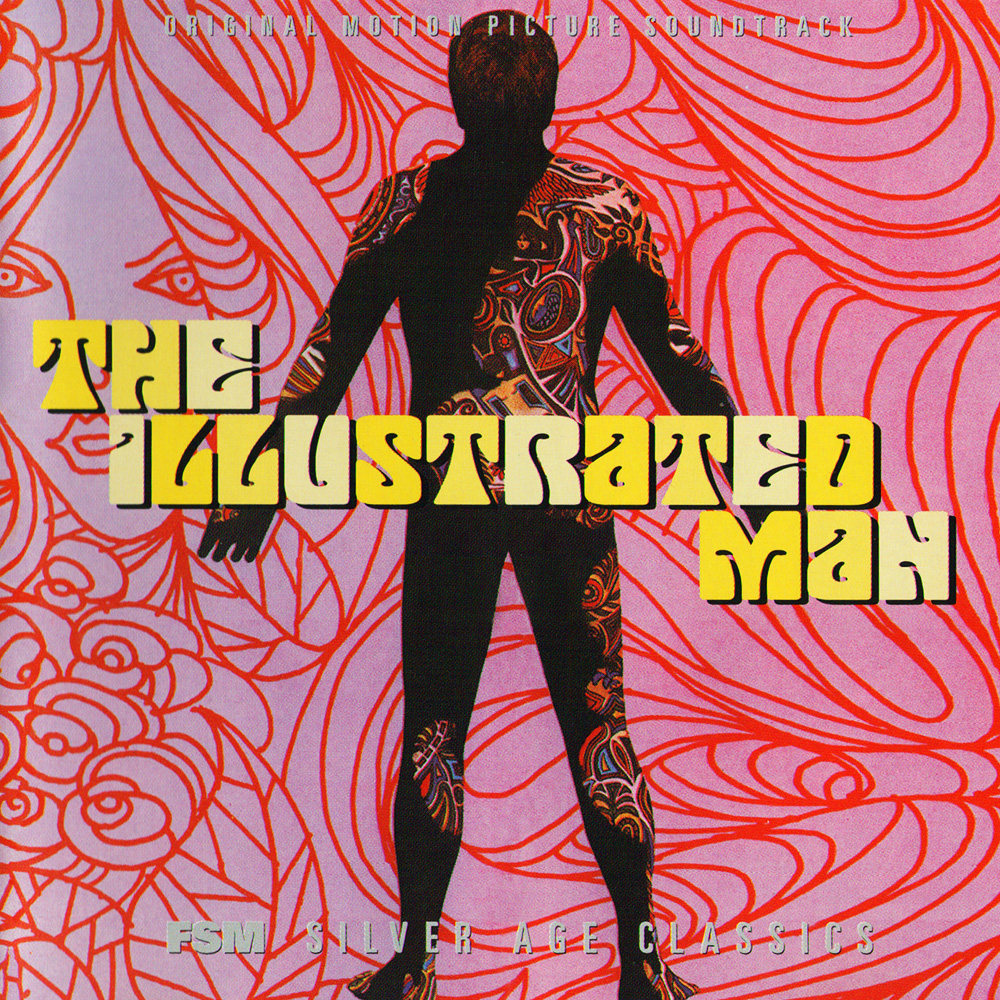
The Illustrated Man – music by Jerry Goldsmith
 In 1969, the thought of dramatizing the short stories of renowned speculative fiction master Ray Bradbury was still relatively new, and the thought of trying to cohesively film a short story collection was probably daunting in itself. Put the two together, and you have a recipe for a movie that probably won’t meet anyone’s expectations. Despite the talent and star power brought to bear on it, The Illustrated Man is considered a valiant attempt, but still a flop at the box office.
In 1969, the thought of dramatizing the short stories of renowned speculative fiction master Ray Bradbury was still relatively new, and the thought of trying to cohesively film a short story collection was probably daunting in itself. Put the two together, and you have a recipe for a movie that probably won’t meet anyone’s expectations. Despite the talent and star power brought to bear on it, The Illustrated Man is considered a valiant attempt, but still a flop at the box office.
Among that talent was Jerry Goldsmith, who had just shaken up movie audiences the previous year with his paradigm-shifting soundtrack from Planet Of The Apes. Setting a pattern that would continue for much of the rest of his life and career, Goldsmith was now being sought out as a composer who “got” science fiction – and, more importantly, could lend it sonic support that would help the audience “get” it too. His score for The Illustrated Man, essentially four separate but linked scores for the price of one, continued Goldsmith’s streak as a cerebral, forward-thinking composer.
The framing story (involving the Illustrated Man of the title) gets a deceptively pastoral sound, introducing the movie’s only real theme. As the framing story’s characters reveal their true nature, the music grows more uneasy, reaching a disquieting climax as the first story within the story opens. For the sequence based on Bradbury’s “The Veldt”, Goldsmith leans almost entirely on synthesizers for the setting of a futuristic house, anticipating his work on Logan’s Run (which was still seven years away). As this story closes, Goldsmith generates some real shock value by pairing the full orchestra with the synths for the climax.
After a brief segue back to the movie’s framing device, the music for the dramatization of “The Long Rain” presents a more traditional orchestral setting, but a languid, hopeless and droning one, ideal music for saturation.
“The Last Night Of The World” continues the cheerless feel, in a somewhat simpler, plainer vein, at least until Bradbury’s cruel twist ending catches up with the story’s characters. This leads into a flashback and a return to the framing story, which itself has a sting in the tail before the movie (and soundtrack) are over.
 Goldsmith was an ideal composer to pair with the works of the late Ray Bradbury. More intellectual and adventurous than worried about what constituted “proper” music in a classical vein, Goldsmith – with his music – was willing to step outside the same bounds that Bradbury’s words did. It’s a pity that the result on film wasn’t as good as the musical collision of their respective worlds.
Goldsmith was an ideal composer to pair with the works of the late Ray Bradbury. More intellectual and adventurous than worried about what constituted “proper” music in a classical vein, Goldsmith – with his music – was willing to step outside the same bounds that Bradbury’s words did. It’s a pity that the result on film wasn’t as good as the musical collision of their respective worlds.
- Main Title (3:28)
- The House (2:50)
- The Illustrations (2:25)
- Felicia (1:40)
- The Rose (1:55)
- The Lion (0:51)
“The Veldt”
- 21st Century House (1:56)
- Angry Child (1:49)
- Quiet Evening (2:50)
- Skin Illustrations (1:22)
- The Rocket (1:19)
“The Long Rain”
- The Rain (1:34)
- The Sun Dome (1:24)
“The Last Night of the World”
- Almost a Wife (6:05)
- The Morning After (2:00)
- The House Is Gone (3:46)
- Frightened Willie (4:29)
Released by: Film Score Monthly
Release date: 2001
Total running time: 42:02
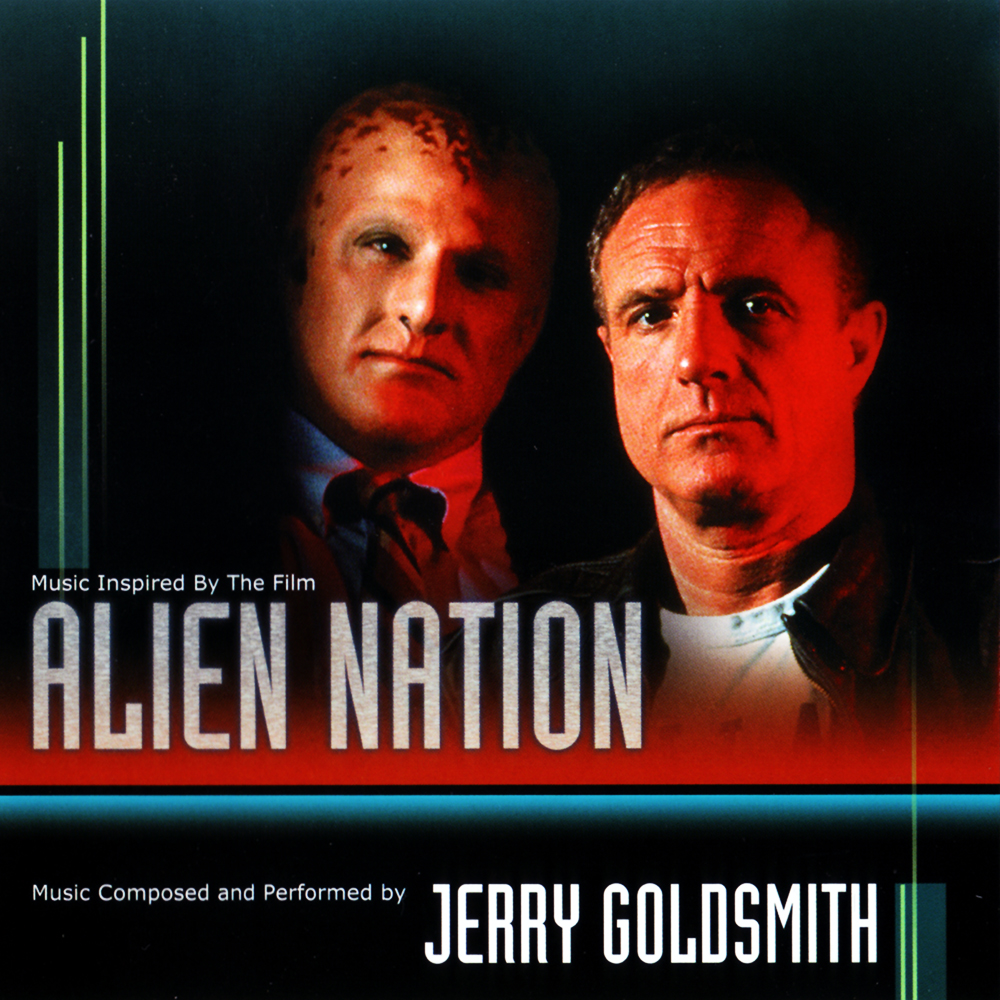
Alien Nation – music by Jerry Goldsmith
 The differences between Alien Nation‘s movie and TV incarnations are so significant that they almost shouldn’t share the name. Both had shortcomings: the TV series delved into the concept more fully, but was often cutesy in an ’80s-family-drama kind of way; the movie was a bit edgier, but ultimately less successful in fleshing out the concept.
The differences between Alien Nation‘s movie and TV incarnations are so significant that they almost shouldn’t share the name. Both had shortcomings: the TV series delved into the concept more fully, but was often cutesy in an ’80s-family-drama kind of way; the movie was a bit edgier, but ultimately less successful in fleshing out the concept.
The soundtrack of Alien Nation (the movie) wasn’t one of the things that made it edgier. It was also the second soundtrack the film went through: Jerry Goldsmith had originally been hired to score Alien Nation, and created an all-synth score which was subsequently rejected and replaced by the Curt Sobel score that was ultimately heard in theaters. The liner notes of this release paint this as the movie’s loss, but it may be a toss-up as to which composer would have serviced the movie better.
Here’s the problem: frankly, the TV series had better music, because it dared to give its alien characters alien music. There seem to be a few hints that Goldsmith had thoughts about going in that direction, but most of those hints take the form of unearthly noise sweeps at the beginning of some tracks. But for the most part, as unlikely as it may seem to describe anything composer by Jerry Goldsmith this way, Alien Nation a la Goldsmith is unremarkable.
 It’s no better and no worse than any other synthesized score, but the music itself seems remarkably tame for what was meant to be an adventurous, high-concept new take on a classic genre. It almost sounds like a demo rather than a finished score, which may or may not have been the intention. And in any case, Goldsmith would go on to create better music for better projects than Alien Nation. Maybe the material just didn’t inspire him.
It’s no better and no worse than any other synthesized score, but the music itself seems remarkably tame for what was meant to be an adventurous, high-concept new take on a classic genre. It almost sounds like a demo rather than a finished score, which may or may not have been the intention. And in any case, Goldsmith would go on to create better music for better projects than Alien Nation. Maybe the material just didn’t inspire him.
- Alien Landing (3:47)
- Out Back (2:01)
- Are You Alright? (1:50)
- Take It Easy (2:53)
- The Vial (2:13)
- Jerry’s Jam (1:51)
- Alien Dance (1:57)
- Are You There? (2:01)
- The Beach (3:42)
- Tow Truck Getaway (1:52)
- 772 / I Shall Remember (4:08)
- Tell Them (1:29)
- A Game Of Chicken (2:36)
- Overdose (2:26)
- Got A Match? (2:53)
- A Nice view (2:34)
- Just Ugly (1:57)
- The Wedding (4:43)
Released by: Varese Sarabande
Release date: 2005
Total running time: 46:43
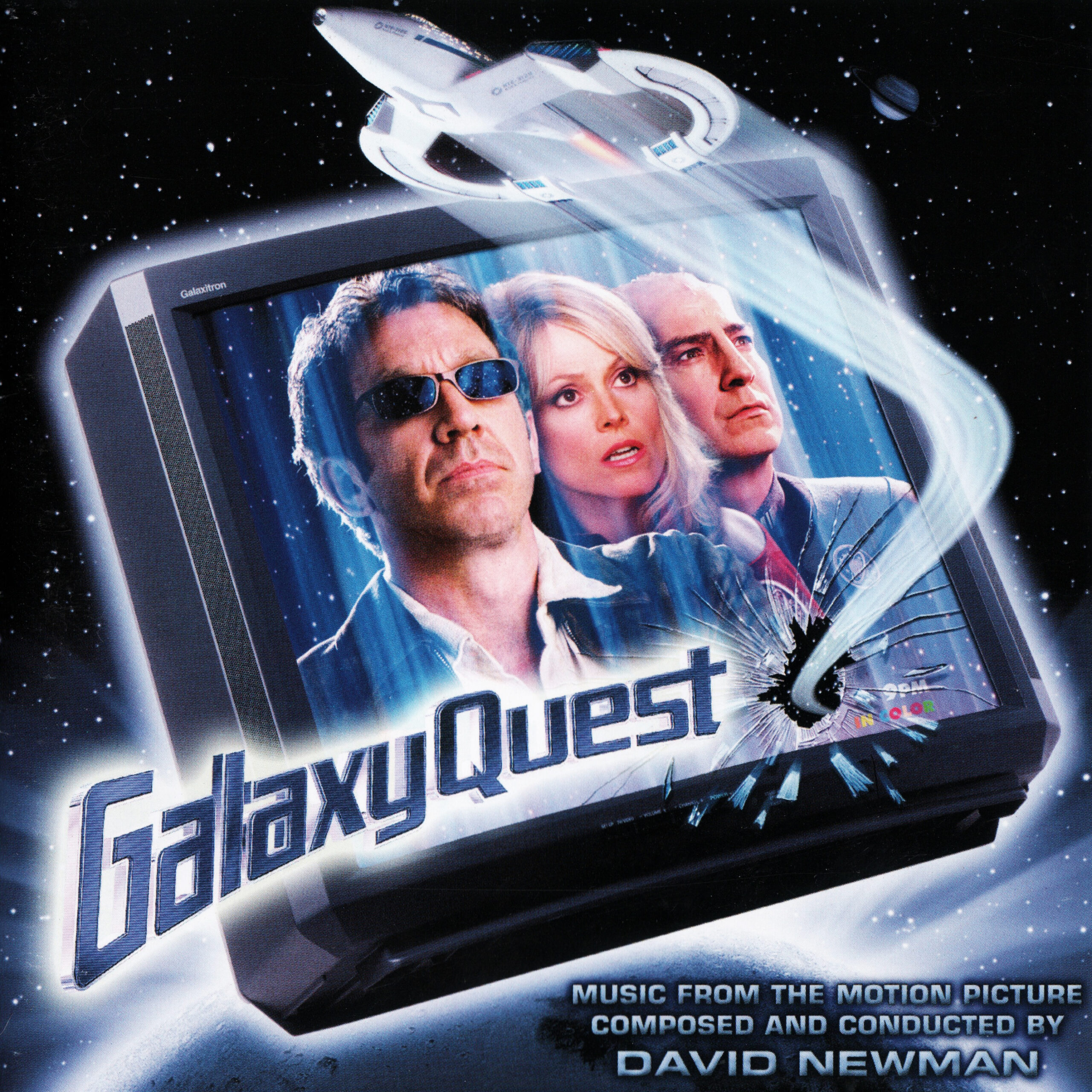
Galaxy Quest (Newly Expanded Edition)
 Originally released shortly after the movie’s premiere, but only in a semi-official capacity on an obscure (and now extinct) label specializing in private-label releases for film and TVcomposers, Galaxy Quest has always been one of my favorite things on my soundtrack shelf. With David Newman tackling the movie as a serious SF film (and the cast and crew doing the same thing, keeping up kayfabe for nearly the entire show), the soundtrack was positively epic – the best science fiction film score of the ’90s. Yes, better than The Matrix.
Originally released shortly after the movie’s premiere, but only in a semi-official capacity on an obscure (and now extinct) label specializing in private-label releases for film and TVcomposers, Galaxy Quest has always been one of my favorite things on my soundtrack shelf. With David Newman tackling the movie as a serious SF film (and the cast and crew doing the same thing, keeping up kayfabe for nearly the entire show), the soundtrack was positively epic – the best science fiction film score of the ’90s. Yes, better than The Matrix.
La La Land Records has rescued Galaxy Quest from obscurity, finally giving the soundtrack a fresh remastering and a wide (if limited-edition) release. There are also a few extra minutes of music, but there was plenty of meat on the bones of the earlier release: this is full-bodied, full-orchestra film music at its finest.
The highlights are still the same as they were before: “Red Thingie, Green Thingie… RUN!” is still one of the best pieces of action movie music since the heyday of Star Wars. What this new La La Land edition has over the old Supertracks release is its copious liner notes booklet, telling me more in just a few pages than I ever knew about Galaxy Quest before, including how hard the studio came down on the writers and director to avoid “offending” the Star Trek franchise’s power players and fans. (As it turns out, Star Trek’s power players were among Galaxy Quest‘s biggest fans – Patrick Stewart, in particular, found the movie uproariously funny.) Also revealed is that David Newman was a mere session orchestra player on the first two Star Trek films, which explains how he nails the all of the little Goldsmith and Horner stylistic tricks so perfectly with Galaxy Quest. This score was Newman’s final exam in how closely he was paying attention in 1979 and 1982.  I think he passed.
I think he passed.
Galaxy Quest has faded into relative obscurity as a theatrical event, so this soundtrack is getting only a limited release. That’s the only less-than-perfect thing about the whole package. It’s still the best sci-fi movie score of the 1990s.
- Galaxy Quest: The Classic TV Theme (0:57)
- TV Clip (1:32)
- Pathetic Nesmith (0:57)
- Galaxy Quest TV Clip #3 / Introducing Sarris / Revealing the Universe (1:50)
- Transporting the Crew / Meet the Thermians (1:33)
- The N.S.E.A. Protector (0:43)
- Crew Quarters & The Bridge / The Launch (3:24)
- Jason Takes Action / Sarris Tortures Captain (1:41)
- Red Thingie, Green Thingie… Run! (3:30)
- Shuttle to Planet / Trek Across Planet (4:26)
- Rolling the Sphere / Pig Lizard / Rock Monster (6:05)
- “Digitize Me Fred” (1:13)
- “I’m So Sorry” (1:42)
- Fight, Episode 17 (1:15)
- The Hallway Sneak / Alex Finds Quellek (2:16)
- Angry Sarris / Into the Ducts / Omega 13 / Heroic Guy / Reveal Chompers / Opening the Airlock (3:31)
- Big Kiss / Happy Rock Monster / Dying Thermians / Quellek’s Death / Into Reactor Room / Push the Button / A Hug Before Dying (4:08)
- Sarris Orders Attack / The Battle (3:34)
- Mathesar Takes Command / Sarris Kills Everybody (2:18)
- Mathesar, Hero / Goodbye My Friends / Crash Landing (1:45)
- Goodbye Sarris / Happy Ending (2:04)
- The New Galaxy Quest (0:59)
Released by: La La Land Records
Release date: 2012
Total running time: 53:07
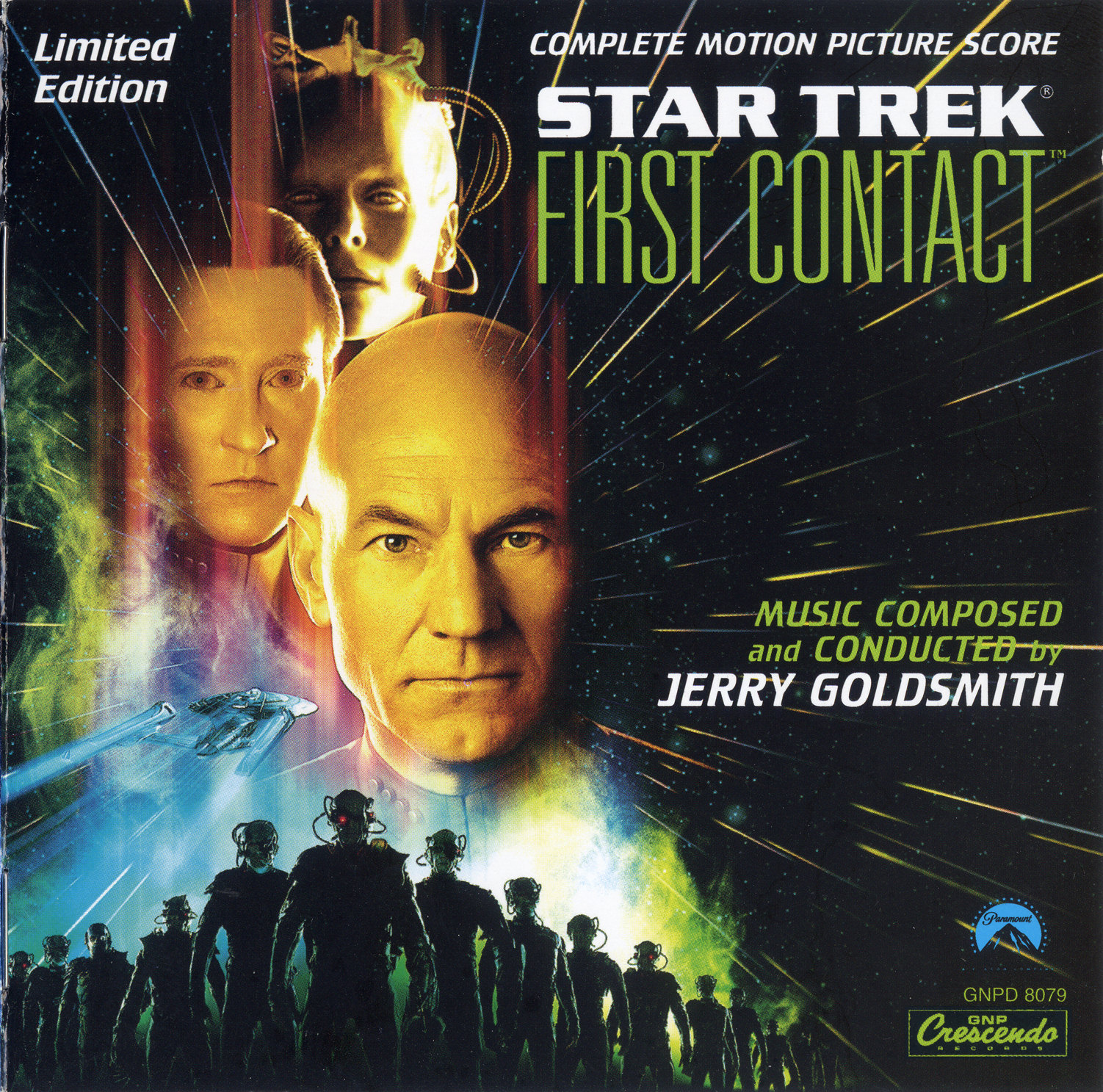
Star Trek: First Contact (Newly Expanded Edition)
Though it really shouldn’t have been surprising after the recent glut of remastered soundtracks from the Kirk-era Star Trek movie franchise, the sudden announcement of a complete and remastered Star Trek: First Contact soundtrack took many by surprise. It came from a label that had been dormant for years – GNP Crescendo had a seemingly absolute lock on all Star Trek soundtrack releases throughout the 1990s – and it was the first remastered soundtrack from the shorter big-screen run of the Star Trek: The Next Generation crew.
Of course, First Contact was the first (and arguably only) undisputed success among the TNG-era films, and marked the return of Jerry Goldsmith to the Star Trek film franchise, so it’s an obvious starting point for the TNG movie soundtrack remasters. (Three TNG-era movies’ soundtracks remain to be remastered and expanded, and two of them – Generations and Insurrection – were previously released by Crescendo, making it almost certain that Crescendo will be releasing the expanded editions.)
The original 1996 soundtrack release of First Contact was hampered by two factors: the punishing cost of licensing more than 40 minutes of music recorded by a union orchestra for a soundtrack release, and a somewhat arbitrary decision to slant the original soundtrack heavily in favor of music by Jerry Goldsmith. Almost a quarter of the movie was actually scored by Joel Goldsmith, who would later make his mark on the genre by scoring the vast majority of the Stargate TV franchise, due to Jerry Goldsmith’s busy schedule. The liner notes even point out that executive producer Rick Berman and director/co-star Jonathan “Riker” Frakes greeted this development by pointing out that they’d paid for Jerry Goldsmith to score their movie. As it so happens, the elder Goldsmith played a thundering action cue that impressed everyone in the room – and then revealed that his son had written it. But that didn’t mean that Joel’s music would find its way onto the original soundtrack release: the same silly argument cropped up. The CD cover said “music by Jerry Goldsmith,” and album producer Neil Norman was determined to deliver on that. The payoff there is that Joel Goldsmith was responsible for the music to the one scene in the movie that everyone bought a ticket to see, the first warp flight by Zefram Cochrane. That was, without a doubt, First Contact‘s money shot. I remember seeing the movie in the theater the first time with my friend Mark, who said “Holy shit!” out loud when the Phoenix deployed its warp engines from its Titan missile casing. It was built up as the movie’s “holy shit!” moment from the word go, and it got “holy shit!” music from the junior Goldsmith – which Crescendo then proceeded to omit from the album on the ground that the cue wasn’t composed by Jerry Goldsmith.
That cue, “Flight Of The Phoenix”, has been… obtainable, for the lack of a better way to put it, as part of a bootleg First Contact score that’s been circulating since the Napster days. However, this single-disc release has been remastered by the same team responsible for the previous Trek movie score remasters, and it’s never sounded this good. With all due respect to the now-departed “dean of movie music,” as Trek TV composer Dennis McCarthy once called him, “Flight Of The Phoenix” is the highlight of the restored full-length soundtrack, just as it was in the movie itself. It’s ironic that arguably the most iconic piece of music in a score attributed to Jerry Goldsmith was composed by his son. Stargate fans will also want to check out Joel’s cues here as a precursor to the up-and-coming composer’s body of work for that franchise (SG-1 was about a year away from premiering at the time of First Contact‘s release).
For those who, like the label circa 1996, are more interested in Goldsmith Sr.’s work, there are unreleased cues by him as well. One of the more intriguing ones is “Borg Montage”, a brief, menacing cue covering several shot Borg-related interludes aboard the Enterprise-E, culminating in a hapless security team wandering into a dimly-lit space which is then illuminated by the laser sights of several approaching Borg. There are two versions of this cue – one used in the movie, and a significantly different one with a more martial approach – and both are vintage Goldsmith with a big brassy flourish at the end.
If you want Steppenwolf or Roy Orbison this time around, there are other sources for those tracks, and in the intervening years they’ve almost certainly been remastered too.
The return of Crescendo Records to the soundtrack arena, especially with the full release of First Contact in hand, is a welcome one, especially when some of the soundtrack specialty labels are calling it a day in the current economy (Film Score Monthly) or beginning to split their release schedules between classic remasters and brand new releases (Intrada). The liner notes booklet – both the printed one with the disc and the downloadable PDF “booklet” (more like one giant, unending vertical strip, possibly representing the first-ever soundtrack liner notes wall  scroll) – looks like it just woke up from ’96, however. The cover layout also shows no attempt to mesh with the general cover design that’s been established for the other Star Trek movie score remasters to date, so maybe a visual rethink might be in order before Crescendo turns out another remastered Trek soundtrack. In the end, though, it’s the music that matters, and this release delivers an increase in both sound quality and quantity. Hopefully it delivers enough sales to Crescendo’s doorstep to merit upgraded releases of Generations and Insurrection.
scroll) – looks like it just woke up from ’96, however. The cover layout also shows no attempt to mesh with the general cover design that’s been established for the other Star Trek movie score remasters to date, so maybe a visual rethink might be in order before Crescendo turns out another remastered Trek soundtrack. In the end, though, it’s the music that matters, and this release delivers an increase in both sound quality and quantity. Hopefully it delivers enough sales to Crescendo’s doorstep to merit upgraded releases of Generations and Insurrection.
- Main Title / Locutus (4:18)
- How Many Ships (0:31)
- Battle Watch (1:13)
- Red Alert (2:16)
- Temporal Wake (2:11)
- Shields Down (1:48)
- The Phoenix (1:04)
- They’re Here (0:28)
- 39.1 Degrees Celsius (4:48)
- Search For The Borg (1:53)
- Retreat (4:01)
- No Success (1:33)
- Borg Montage (1:03)
- Welcome Aboard (2:43)
- Stimulation (1:08)
- Smorgasborg (1:30)
- Getting Ready (1:36)
- Fully Functional (3:22)
- The Dish (7:09)
- Objection Noted (1:57)
- Not Again (2:44)
- Evacuate (2:24)
- New Orders / All The Time (3:52)
- Flight Of The Phoenix (6:23)
- First Contact (6:03)
- End Credits (5:32)
- The Phoenix [alternate] (1:10)
- Borg Montage [alternate] (1:20)
- Main Title [alternate] (2:54)
Released by: GNP Crescendo Records
Release date: 2012
Total running time: 78:54
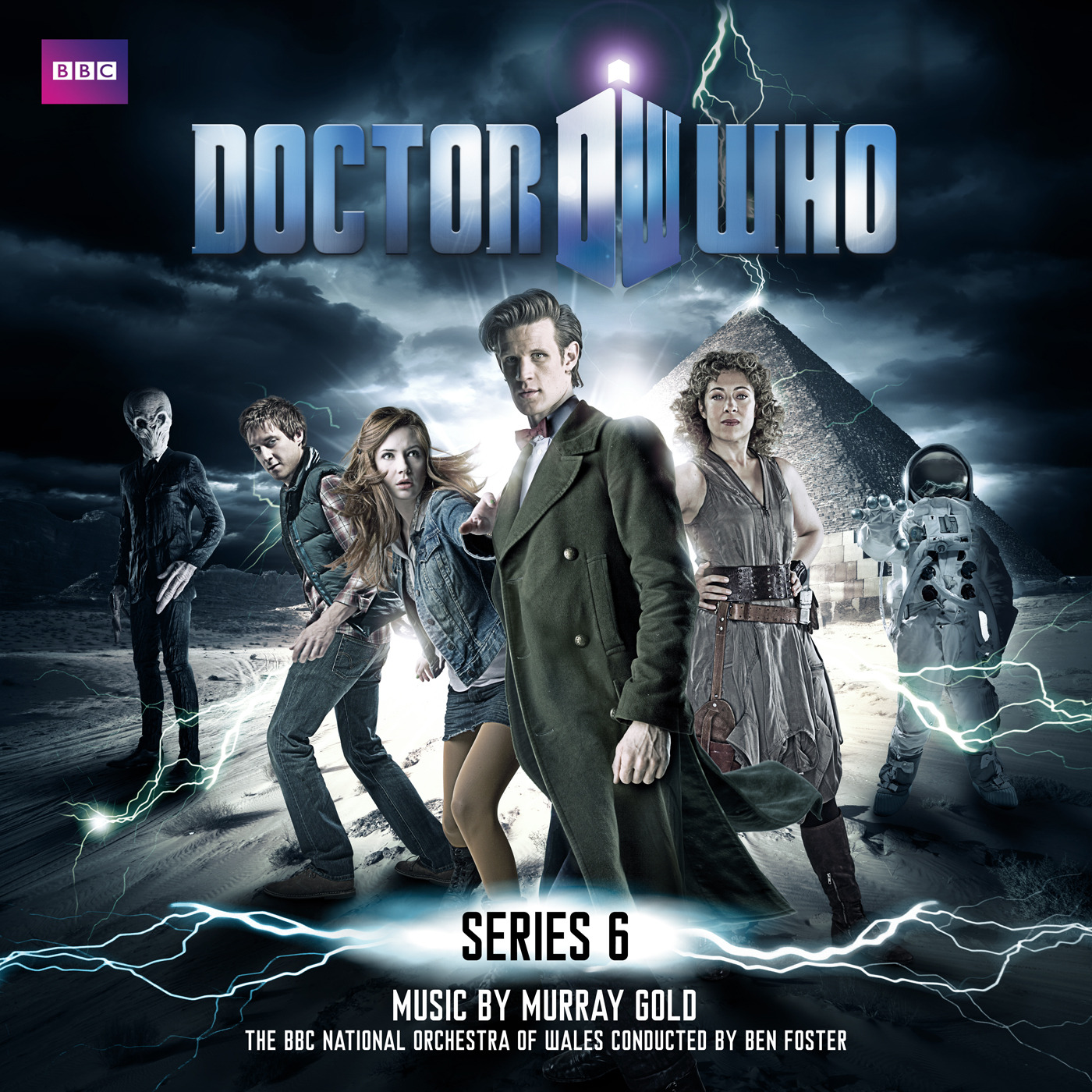
Doctor Who Series 6 – music by Murray Gold
It’s rare, but not unheard of, to claim to have enjoyed the music from a movie or TV show tremendously, while not enjoying the story that spawned the music. Much of the sixth season of revived Doctor Who is like that for me – the season’s reliance on, and constant referral to, the Doctor’s apparent date with death, just rubbed me the wrong way. It might’ve been a brilliant device to use if it had been the final season for the incumbent Doctor, but in this day and age the general public knows that the actor in question is contracted for several years, and won’t be bowing out at the end of his second season. All the constant refrain of the season’s already-witnessed cliffhanger did was remind me how suspense-free the whole enterprise was. It was right up there with the third season (the “Martha season”) as my least favorite year of the show’s revival.
Could I separate my noncommittal grunt of a response to the season from the music? Yes and no. Murray Gold gamely gives his all to every episode, though there’s a lot of referring back to the Doctor’s new theme established in the previous season (and on that season’s soundtrack). There’s also a lot of referring back to the style that Gold employed for much of the Davies/Tennant years – unashamed orchestral bombast, even in scenes that don’t always call for it – and less of the promising experimentation of the fifth season. The season’s opening two-parter is at its best when it’s using a slightly twangy electric guitar to signify its setting, although the “Apollo 11” cue is as good a musical theme for the launch of the first moon landing mission as I’ve ever heard. “Another Perfect Prison”, “Day Of The Moon” and “I See You Silence” are the best examples of this, recalling the best of John Barry’s James Bond scores.
The Curse Of The Black Spot and The Doctor’s Wife have outstanding music, with the latter being a standout of the season both musically and story-wise. The “Run, Sexy” cue is one of the few overt examples of the orchestra-and-electronics-joined-at-the-hip style that made the fifth season’s soundtrack such a welcome change of pace from what had come before. The Rebel Flesh and The Almost People, a two-parter dealing with clones demanding independence, are more subdued to make way for dialogue.
But things crank up for the second half of the mid-season cliffhanger. (Sadly, it’s one of the silliest episodes in the series’ nearly-50-year history, but nobody’s perfect.) Let’s Kill Hitler gets a snarlingly oppressive march for the Nazi terror, a good place for orchestral bombast if there ever was one.
The second half of the season has more interesting episodes and more interesting scores. Night Terrors has a deceptively calm opening theme and sinister passages, while The Girl Who Waited is dripping with uncertainty as Amy comes to grips with a TARDIS-free reality on the run, and then learns that even that isn’t immutable. The God Complex has some very unusual keyboard/synth-heavy cues (including the recurring “muzak” motif). “Room Of Your Dreams” opens up with the kind of electronics that haven’t been heard since the original series.
Closing Time sounds almost like a sitcom in its opening track, and most of the cues presented here stay light-hearted. The music from the season closer, The Wedding Of River Song, starts with a rollicking opening track, “5:02 PM”, before becoming surprisingly quiet. One of the better tracks, “Brigadier Lethbridge-Stewart”, accompanies the kick-in-the-gut meta moment where the Doctor learns of the his old friend’s death (Nicholas Courtney, the actor who portrayed the Brigadier in all of his appearances, had died earlier in the year) to a wistful tune.
Wedding finishes off by rehashing the Doctor’s theme in various ways, and includes the cue that sees out the season, accompanying the closing moments in which a portly severed head bellowing “DOCTOR…WHO?” over and over. The soundtrack itself closes by wrapping around to a cue from Day Of The Moon which, again, repeats the Doctor’s theme.
 There’s some music here that I’ve had no desire to re-listen to, but that may well represent a failing on my part to separate music from story subject matter. Murray Gold still delivers a unique, full-blooded sounded that’s unlike anything else on TV, and the soundtracks released by Silva Screen are uncommonly generous with their double-disc set covering all 13 of the season’s episodes. Next year, I just want the stories to be as good as the music.
There’s some music here that I’ve had no desire to re-listen to, but that may well represent a failing on my part to separate music from story subject matter. Murray Gold still delivers a unique, full-blooded sounded that’s unlike anything else on TV, and the soundtracks released by Silva Screen are uncommonly generous with their double-disc set covering all 13 of the season’s episodes. Next year, I just want the stories to be as good as the music.
The Impossible Astronaut / Day of the Moon
- I Am The Doctor In Utah (1:44)
- 1969 (2:01)
- The Impossible Astronaut (3:16)
- Trust Me (1:39)
- Help Is On Its Way (3:59)
- Another Perfect Prison (0:53)
- Greystark Hall (2:53)
- Apollo 11 (0:54)
- Day Of The Moon (2:44)
- I See You Silence (1:05)
The Curse of the Black Spot
- You’re A Dead Man (1:40)
- Deadly Siren (5:30)
- Perfect Reflection (1:03)
- All For One (3:49)
- The Curse Of The Black Spot (1:14)
The Doctor’s Wife
- I’ve Got Mail (0:45)
- My TARDIS (1:30)
- Run, Sexy (1:56)
- Locked On (1:11)
The Rebel Flesh / The Almost People
- The Chemical Castle (1:30)
- Which One Is The Flesh? (1:39)
- Scanning Me (2:31)
- Ransacked (2:01)
- Always With The Rory (1:22)
- Double Doctor (2:02)
- Tell Me The Truth (3:48)
- Loving Isn’t Knowing (The Almost People Suite) (5:29)
A Good Man Goes to War
- River’s Waltz (1:53)
- Pop (1:36)
- Tell Me Who You Are (1:52)
- Melody Pond (2:36)
Disc Two
Let’s Kill Hitler
- Growing Up Fast (1:21)
- The Blush Of Love (1:22)
- Terror Of The Reich (3:05)
- The British Are Coming (1:07)
- A Very Unusual Melody (2:53)
- When A River Forms (1:32)
- Pay Attention Grown Ups (2:10)
- The Enigma Of River Song (3:59)
Night Terrors
- Bedtime For George (2:24)
- Tick Tock Round The Clock (2:11)
- A Malevolent Estate (3:58)
- Night Terrors (1:19)
The Girl Who Waited
- Apalapucia (1:29)
- 36 Years (0:55)
- Lost In The Wrong Stream (3:25)
The God Complex
- The Hotel Prison (0:47)
- Room Of Your Dreams (1:21)
- Fear Enough (1:17)
- What’s Left To Be Scared Of? (1:00)
- Rita Praises (1:08)
Closing Time
- Stormageddon, Dark Lord Of All (1:34)
- Definitely Going (1:56)
- Over Your Shoulder (1:11)
- Ladieswear (0:45)
- Fragrance (2:17)
- My Time Is Running Out (4:55)
- Tick Tock (vocal track) (1:23)
The Wedding of River Song
- 5:02 PM (2:43)
- The Head Of An Enemy (1:15)
- My Silence (1:13)
- Brigadier Lethbridge–Stewart (2:19)
- Forgiven (2:31)
- Time Is Moving (1:31)
- The Wedding Of River Song (4:32)
Day of the Moon
- The Majestic Tale (Of A Madman In A Box) (4:01)
Released by: Silva Screen
Release date: 2011
Disc one total running time: 68:05
Disc two total running time: 55:27
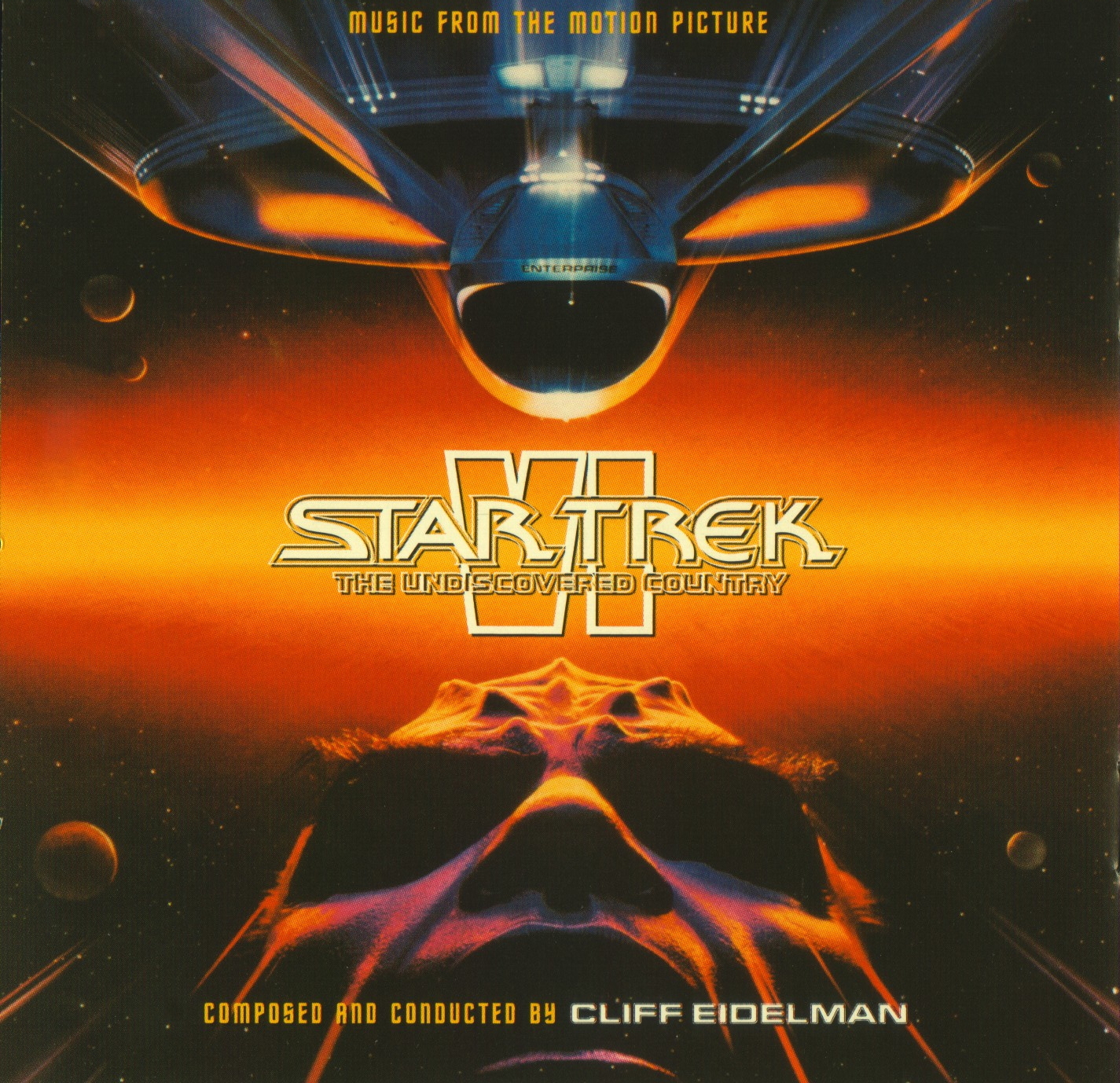
Star Trek VI: The Undiscovered Country (Newly Expanded Edition)
The only big-screen classic Star Trek sequel still waiting for its soundtrack to be remastered has finally gotten the deluxe treatment from Intrada. The release was inadvertently revealed by composer Cliff Eidelman early in 2012, a practice that the soundtrack boutique labels tend to avoid simply because they barely have enough time in the day to do what they do, let alone answer endless questions about upcoming releases and whether or not they can be pre-ordered. But that would seem to reveal a certain degree of pride on Eidelman’s part for his first major film scoring assignment – and listening to this expanded release, which finally puts every note of the movie’s music in fans’ hands, it must be said that any such pride is certainly justified.
Star Trek VI was a movie that almost didn’t happen. The William Shatner-directed Trek V bombed at the box office once word got out about its utterly goofy treatment of philosophical subject matter that had big implications, and it proved to be Shatner’s only directorial turn in the franchise, and the last stop for producer Harve Bennett, who, had turned the Trek films into a Big Deal with Star Trek II. But 1991 was the 25th anniversary of the premiere of the original Star Trek, and Paramount wanted to make a Big Deal out of that too, and so it took stock of the other driving creative forces behind Trek II and Trek IV, the series’ most successful films. A sixth movie would happen after all, shepherded to the screen by director Nicholas Meyer and Leonard Nimoy, surrending his director’s seat to produce the final film to feature the full original cast.
Meyer’s original musical idea was to adapt either Holst’s The Planets or Stravinsky’s Firebird Suite – basically pulling a Kubrick and scoring the movie with existing classical music. Composer Cliff Eidelman, chosen for his strong classical background, got a break when Holst’s estate refused to allow The Planets to be licensed or altered without a gigantic price tag: he would get to compose an original score with hints of both Stravinsky and Holst’s stylistic trappings. The result was something far darker than anything the Star Trek films had been graced with before, including the first use of choir in the Trek movies. Only fleeting references to prior scores in the film series would be made; Trek VI happened further in the future than any of the previous films and would have a stand-alone sound. A scary and glorious stand-alone sound, too, with Eidelman not holding back on playing up the implications of impending war between the Federation and its enemies, and the willingness of almost all parties to sacrifice Captain Kirk and Dr. McCoy as pawns in the rapidly escalating hostilities.
The second disc of this two-disc set features a remastered edition of the original 1991 soundtrack album, which we covered back when The Undiscovered Country was a relatively recent arrival in theaters. The first disc presents the music as heard in the film itself, which sometimes means entire pieces of music that haven’t been heard before, and sometimes means subtly different versions of the pieces you’re already familiar with. It may not hurt to listen to this version first, so it’s easier to spot the missing material added to the complete score on disc one. Some of the missing material flies past pretty quickly, but as always, it encompasses key moments that weren’t incorporated into the original soundtrack release. Scenes that were on the original soundtrack but weren’t heard in full include the Excelsior crew receiving a message about a Chernobyl-like “incident” at a Klingon power plant, Kirk receiving his orders to attempt peace with the Klingons, and Kirk’s trial on a brutal Klingon prison planet after he’s accused of assassinating the Klingons’ leader at that peace summit.
Fans of the original soundtrack and the movie know by now that the original CD’s “Battle For Peace” track – an eight-minute orchestral assault – left some stuff out, including, ironically, silence. The expanded version of this lengthy battle scene is now complete, including those conveniently-timed pauses for Kirk and Sulu to issue their respective orders to destroy the pesky Klingon Bird of Prey whose commander is fighting to keep both worlds at war.
The most interesting and showy material among the previously unissued tracks center around the Enterprise crew’s search for evidence to lead them to the real assassins. In the movie, this search took the form of several vignettes as planted evidence was repeatedly found, leading to the wrong suspects, but it’s surprisingly good music that shows no ambitions toward low-key subtlety. The other new and interesting material is music that isn’t from the movie at all. Star Trek VI was the first and only Star Trek film to this day to have custom-scored trailers. Earlier films tended to rely on mashups of music from earlier Star Trek movies for their trailers, and even the very first Trek movie had trailers choppily scored with pieces of Jerry Goldsmith’s immortal music, often clumsily hacked to pieces in the editing room. For Trek VI, Cliff Eidelman scored his own trailers, offering the audience a preview of the music as well as the movie. Not edited together from the score, the trailers are custom-made creations that use the same themes in a kind of rapid-fire greatest-hits style. This is the first time that music has been released, and it’s pretty neat to hear.
Star Trek music expert Jeff Bond, who still needs to update his excellent 1999 book “The Music Of Star Trek: Profiles In Style”, and Film Score Monthly Trek music savior Lukas Kendall provide some of the best liner notes in the business, detailing the creation of both the movie and its music, rounding out the package. As with its Star Trek IV soundtrack, Intrada has wisely forgone its usual route of limiting this soundtrack to an arbitrary print run of 3,000 copies – there are enough copies for everyone who wants one.
Star Trek music fans have been graced with a wealth of re-releases and never-before-released material from both the movie and TV franchises in the past three years (like his movie or not, you can probably thank J.J. Abrams for raising Star Trek’s public profile enough to make that possible). Now, of course, everyone’s licking their lips and hoping for another re-release of Goldsmith’s music from the first film, hopefully this time in complete form. (I wouldn’t object if the next project was Dennis McCarthy’s criminally-underrated Star Trek: Generations score,  but I suspect I’m in the minority there; McCarthy has a small but loyal base of fans, of which I count myself one, while Goldsmith now has a cult of worshippers who’ll buy anything with the man’s name on it.) The ongoing expand-and-reissue project, however, has been nothing short of a delight for the ears, and Star Trek VI will keep me more than happy until the next re-release.
but I suspect I’m in the minority there; McCarthy has a small but loyal base of fans, of which I count myself one, while Goldsmith now has a cult of worshippers who’ll buy anything with the man’s name on it.) The ongoing expand-and-reissue project, however, has been nothing short of a delight for the ears, and Star Trek VI will keep me more than happy until the next re-release.
Disc One: complete score
- Overture (3:02)
- The Incident (1:09)
- Spacedock / Clear All Moorings (1:59)
- Spock’s Wisdom (3:13)
- Guess Who’s Coming (0:49)
- Assassination (2:16)
- Surrender For Peace (2:48)
- The Death Of Gorkon (2:07)
- The Trial / Morally Unjust Evidence (1:13)
- Sentencing (1:02)
- Rura Penthe / First Sight Of Rura Penthe (4:09)
- Alien Fight (1:05)
- First Evidence / The Search (1:33)
- Escape From Rura Penthe (5:35)
- The Mirror (1:17)
- Revealed (2:48)
- Mind Meld (2:06)
- Dining On Ashes (1:01)
- The Battle For Peace / The Final Chance For Peace / The Final Count (8:15)
- The Undiscovered Country (1:07)
- Sign Off (3:16)
- Star Trek VI End Credits Suite (6:17)
- Trailer (take 10) (2:23)
- Guess Who’s Coming (alternate) (0:51)
- Sign Off (alternate) (3:31)
- Trailer (take 2) (2:20)
Disc Two – original 1991 album
- Overture (2:57)
- An Incident (0:53)
- Clear All Moorings (1:39)
- Assassination (4:45)
- Surrender Dor Peace (2:46)
- Death Of Gorkon (1:10)
- Rura Penthe (4:22)
- Revealed (2:38)
- Escape From Rura Penthe (5:34)
- Dining On Ashes (1:00)
- The Battle For Peace (8:03)
- Sign Off (3:13)
- Star Trek VI Suite (6:18)
Released by: Intrada
Release date: 2012
Disc one total running time: 67:14
Disc two total running time: 45:!7
fun. – Some Nights
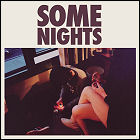 fun.’s debut album was one of those musical first-stretches-out-of-the-starting-gate that made one wonder how the group would top that in the second leg of the race. It turns out they’re doing it quite nicely, even though there are a few stylistic quirks to Some Nights that left me feeling a little bit old. The rock-solid songwriting is more evocative of Queen than ever, and that alone makes fun. worth following.
fun.’s debut album was one of those musical first-stretches-out-of-the-starting-gate that made one wonder how the group would top that in the second leg of the race. It turns out they’re doing it quite nicely, even though there are a few stylistic quirks to Some Nights that left me feeling a little bit old. The rock-solid songwriting is more evocative of Queen than ever, and that alone makes fun. worth following.
When I reviewed the group’s first album, I found myself wondering if their chosen band name might be a liability. Perhaps I was worrying too much – in the months leading up to the release of Some Nights, fun. managed to step up its promotional game considerably. The song “We Are Young” was highlighted on Glee months in advance of the album, and it’s also been picked up for a major national advertising campaign as well. This sort of thing shouldn’t be considered “selling out” – if anything, in the download age, strategic licensing of one’s music is bread and butter, and I don’t hold it against anybody trying to get a song placed in an ad campaign. These alliances have served as a showcase of fun.’s music, giving the band the kind of exposure that, in these dying days of radio, no amount of payola can buy.
And it’s really good music. That’s already been mentioned, hasn’t it? It’s really good music. The title track is split across an extended intro and the main song itself; if for no other reason than the prominent F-bomb, the intro will likely be skipped in nearly every broadcast venue. (It’s rather stunning that there’s a video for it, and an uncensored one at that.) “Some Nights” is the first indication that the album of the same name is an entire album of anthems – nearly every song is a celebration of its subject matter, whether it’s youth and the excesses that go with it (“Some Nights” and the perfectly-pitched ’50s rock pastiche “We Are Young”), and resilience in the face of opposition (“Carry On”, “It Gets Better”). With the exception of the world-weary but beautiful “Carry On” (my early favorite out of the entire album) and “Why Am I The One”, Some Nights is upbeat and fun.
If I have a bone to pick with Some Nights, it’s the utterly bizarre use of auto-tune on several songs. I know it’s standard-issue in any studio at this point, but I can’t think of a band that needs it less. After Aim & Ignite, lead singer Nate Ruess was almost inevitably compared to Freddie Mercury of Queen, and given the very operatic, Queen-like “Some Nights Intro”, it would seem that he’s cool with that comparison (and really, what a voice to be compared to!). If there’s a voice in rock music today that needs auto-tune less than Nate Ruess, please point me that way because that person’s probably singing some good stuff too. It’s used here as a style choice, just another tool in the studio arsenal, but I can’t help but feel that it mars the proceedings when it rears its head. Nate Ruess does not need auto-tune. He may just be the best voice in rock today, and I’ll bet he could’ve hit every note without the studio trickery – it cheapens that voice  to turn him into a singing robot.
to turn him into a singing robot.
Give or take a couple of production choices that make it unwisely easy to downplay what an amazing voice fun.’s frontman has, Some Nights is definitely worthy of the hype and build-up that it got. You should definitely keep your eyes and ears on fun.
- Some Nights Intro (2:17)
- Some Nights (4:37)
- We Are Young featuring Janelle Monáe (4:10)
- Carry On (4:38)
- It Gets Better (3:36)
- Why Am I The One (4:46)
- All Alone (3:03)
- All Alright (3:57)
- One Foot (3:31)
- Stars (6:53)
- Out On The Town (4:21)
Released by: Fueled By Ramen
Release date: 2012
Total running time: 45:49
Liam Finn – FOMO
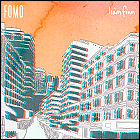 The eagerly awaited second effort from Liam Finn was a major event for indie music in 2011; indeed, it was easier to find his new album than it was to track down the latest efforts from his famous father or uncle. I’ll Be Lightning had set the bar incredibly high, with across-the-board great songwriting, crisp (if occasionally slightly lo-fi) production, and mind-boggling performances from Finn, who played and sang every note on the album. How could he surpass that opening act?
The eagerly awaited second effort from Liam Finn was a major event for indie music in 2011; indeed, it was easier to find his new album than it was to track down the latest efforts from his famous father or uncle. I’ll Be Lightning had set the bar incredibly high, with across-the-board great songwriting, crisp (if occasionally slightly lo-fi) production, and mind-boggling performances from Finn, who played and sang every note on the album. How could he surpass that opening act?
With FOMO, it would seem that he wasn’t trying to surpass it, but to steer clear of it. As universally lauded as Lightning was, it was a pretty good bet that the follow-up wouldn’t live up to everyone’s expectations. FOMO‘s lead single, “The Struggle”, was a sonic mess compared to Lightning‘s panoramic production and gorgeous harmonies – swampy, even more lo-fi, and more suited to fans of shouty punk rock than to fans of the previous album. It was evolved from the loop-based style that Finn had adopted during endless one-man-band touring for Lightning, but was a little off-putting if you’d grown accustomed to I’ll Be Lightning‘s house style.
Fortunately, it’s also an oddball song on FOMO, which opens with four songs as good as anything on Finn’s debut album. “Neurotic World” picks up where the Lightning‘s relaxing, harmony-based pop songs left off, while “Don’t Even Know Your Name” is a jumpier rock song with improbable ascending vocals in the chorus. The one-two punch of “Roll Of The Eye” and “Cold Feet” is the strongest pair of songs on FOMO, and it’s no accident that the latter was quickly rolled out as the album’s second single with an amusing video to match. It’s with these two songs that one of Liam Finn’s major influences can be found: while his father may be aspiring to be the 21st century’s answer to Paul McCartney, Liam is exploring Lennon territory and doing so boldly. If you’ve been missing the John Lennon sound, just as melodic as McCartney but occasionally bolder and more unpredictable, you need to be following Liam Finn’s musical exploits. “Cold Feet” was one of the catchiest songs I heard in 2011.
“Real Late” has a faux-Eastern flavor to it, but loses a lot of the energy built up in the first four songs. This is followed by “The Struggle” and “Little Words”, another low-key number with some great harmonies. “Reckless” gets things back on track with a jumpy punk-pop feel that – as much as I don’t want to make the obvious comparisons – would’ve fit right into the early ’80s Split Enz setlist. “Chase The Seasons” is a pleasant, beautifully-harmonized shuffle, while “Jump Your Bones” closes things out with a bit of a free-form jam – the closest any other songs on the album gets to “The Struggle”.
 Most of the album is a real joy, even in its quieter moments. Liam Finn continues to show expert songwriting and performance chops, and some impressive production skill to boot – bits of “Cold Feet” are almost Lindsey Buckingham-esque (perhaps even moreso than anything Buckingham himself has turned out in recent years), and that’s not a bad thing.
Most of the album is a real joy, even in its quieter moments. Liam Finn continues to show expert songwriting and performance chops, and some impressive production skill to boot – bits of “Cold Feet” are almost Lindsey Buckingham-esque (perhaps even moreso than anything Buckingham himself has turned out in recent years), and that’s not a bad thing.
- Neurotic World (3:00)
- Don’t Even Know Your Name (4:09)
- Roll Of The Eye (4:40)
- Cold Feet (4:16)
- Real Late (3:11)
- The Struggle (2:52)
- Little Words (2:37)
- Reckless (2:36)
- Chase The Seasons (3:01)
- Jump Your Bones (5:37)
Released by: Yep Roc
Release date: 2011
Total running time: 35:59
Gotye – Making Mirrors
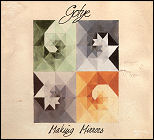 Rapidly gaining notice outside of his native Australia, Gotye is yet another one of these artists who plays and sings nearly everything himself, and produces his own material as well. Originally starting out with a heavy reliance on sampling, Gotye has managed to emerge as an musician with originality and a style not unlike something I’ve been missing for a while: it certainly doesn’t hurt that, when the man lets rip vocally, he sounds like Peter Gabriel at the height of his powers, or late-Police-era/Dream Of The Blue Turtles-era Sting. Put that voice together with a quirky approach to instrumentation and you’ve got a pretty potent brew that’s hit the top of the charts in Australia and New Zealand, and might well do some damage elsewhere in the world.
Rapidly gaining notice outside of his native Australia, Gotye is yet another one of these artists who plays and sings nearly everything himself, and produces his own material as well. Originally starting out with a heavy reliance on sampling, Gotye has managed to emerge as an musician with originality and a style not unlike something I’ve been missing for a while: it certainly doesn’t hurt that, when the man lets rip vocally, he sounds like Peter Gabriel at the height of his powers, or late-Police-era/Dream Of The Blue Turtles-era Sting. Put that voice together with a quirky approach to instrumentation and you’ve got a pretty potent brew that’s hit the top of the charts in Australia and New Zealand, and might well do some damage elsewhere in the world.
The single that brought Gotye to everyone’s notice (mine included) was “Somebody That I Used To Know”, a song that’s uncompromisingly Gabriel-esque in its execution (and the striking-but-not-flashy video’s not a million miles away from the groundbreaking stuff that a younger Pete used to do, either). Featuring a guest vocal from New Zealand jazz singer Kimbra, it’s a handy jumping-on point for those unfamiliar with Gotye. The rest of the album isn’t necessarily just like it, but with songs that walk deftly between such well-defined genres as techno and reggae, we shouldn’t be expecting any two Gotye songs to be alike: this guy clearly loves to kick down the barriers that common sense and received wisdom tell us should exist between these styles of music, and the result is startlingly original cutting-edge rock.
Much of the album is sunnier than the somewhat angsty “Somebody That I Used To Know”, but it’s no less listenable. “State Of The Art” is as close as Making Mirrors gets to revisiting “Somebody”‘s dark feel, relying on samples, spoken word, and instrumentation that doesn’t normally get paired together. It’s a stranger specimen than “Somebody”, but it’s still listenable and re-listenable. The echoing “Smoke And Mirrors” and the low-key, atmospheric “Giving Me A Chance” Gotye has some fairly daring ideas on what kind of percussion and  instrumentation to use – it’s innovative and unconventional, but not alienating. Which really sums up the album as a whole.
instrumentation to use – it’s innovative and unconventional, but not alienating. Which really sums up the album as a whole.
Go ahead and give Gotye a listen. I think this one’s going to wind up being on a lot of people’s “new discoveries” lists for 2012, and I for one plan to also put him on the “track down his older stuff and watch closely for what he does in the future” list.
- Making Mirrors (1:01)
- Easy Way Out (1:57)
- Somebody That I Used To Know featuring Kimbra (4:04)
- Smoke And Mirrors (5:13)
- I Feel Better (3:18)
- In Your Light (4:39)
- State Of The Art (5:15)
- Don’t Worry, We’ll Be Watching You (3:18)
- Giving Me A Chance (2:56)
- Save Me (3:53)
- Bronte (3:18)
Released by: Eleven
Release date: 2011
Total running time: 38:52

Star Trek IV: The Voyage Home (Newly Expanded Edition)
Marking the first foray of soundtrack label Intrada into the neutral zone of Star Trek movie music, Star Trek IV: The Voyage Home is a risky thing to release, then or now. It’s also the only Star Trek adventure for Leonard Rosenman (Beneath The Planet Of The Apes, Ralph Bakshi’s animated Lord Of The Rings), and it’s been misunderstood since the original 35-minute soundtrack album was released by MCA in 1986. Rosenman’s approach to film scoring was always steeped in his classical background, and while that doesn’t mean that he wasn’t suited to making movie music, his old-school sensibilities on such things as formal structure haven’t won him as wide a fan base as, say, Jerry Goldsmith or John Williams.
Intrada’s single-disc release almost fills the running time of its CD, doubling the amount of music that was available before by finally revealing the alternate versions of many key pieces of music. There are so many alternates here that it almost constitutes a second soundtrack that we never got to hear. Rosenman has taken a lot of heat from critics for the almost Christmas-like main titles, and his original main titles are quite a departure from that – a stately, fully orchestral version of the theme from the original Star Trek series, for the first and only time in the movie series (that we never got to hear). Not just a quotation, not just the four-note fanfare, but the entire theme as heard on TV in the ’60s, 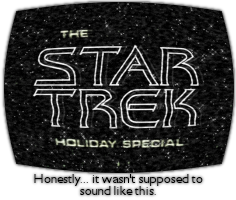 upgraded to the splendor of a full orchestra rather than the bongos and the warbling female vocal. It’s pretty magnificent stuff, though of course using that would’ve gotten Rosenman bashed for lack of originality (a charge already leveled at the screen-used titles, which bore a slight resemblance to Rosenman’s Lord Of The Rings). The poor guy couldn’t win.
upgraded to the splendor of a full orchestra rather than the bongos and the warbling female vocal. It’s pretty magnificent stuff, though of course using that would’ve gotten Rosenman bashed for lack of originality (a charge already leveled at the screen-used titles, which bore a slight resemblance to Rosenman’s Lord Of The Rings). The poor guy couldn’t win.
The other alternates reveal a slightly darker take on the themes for the inscrutible, cylindrical alien probe and the whaling ship at the end of the movie, both of which are looking for the same thing; the alternate whaling ship cue is a more violent, guttural sounding piece, almost like Goldsmith action music.
Heard in the movie, but previously unheard on a soundtrack album, are the series of vignettes at the beginning of the movie, reintroducing us to the Enterprise crew and their purloined Klingon ship, setting up the conflict with the Klingons in a diplomatic vanue on Earth, and setting up the probe crisis from the vantage point of Starfleet Command. This music is presented as a single suite, mainly because the scenes were presented that way too. Another series of vignettes, “In San Francisco”, follows Kirk’s fish-out-of-water crew through their haphazard attempts to function on 20th century Earth, and is perhaps a bit less successful as it falls back on stereotypical samplings of various “ethnic” music types to represent the nationalities of the crew. There’s somewhat predictable Eastern-scale music for the Sulu scenes that we barely got to see (much of the 20th century Sulu scenes, including a run-in with a potential ancestor, were cut from the movie), as well as Scottish and Russan refrains for Scotty and Chekov.
Several of the cues may leave Trek music fans cringing precisely because they don’t fit neatly into the template established by Goldsmith and James Horner in the first three movies. Rosenman was assigned to score a movie that was basically a comedy with a dramatic framing device, and that’s how the movie is scored. It worked well with the movie, but purely as a listening experience, even with the added material, it probably won’t satisfy listeners expecting a “hey, the music wasn’t that bad” revelation like the expanded Star Trek V soundtrack gave us.
It’s good to finally be able to hear more than 35 minutes of music, though, and even the movie’s comedy trappings have a musical payoff: the song written especially for the punk-on-the-bus scene, “I Hate You”, is heard in full, performed by an ad hoc band formed by some of the movie’s production team. In the film, the song gets shut down in the first chorus thanks to Spock’s timely nerve-pinching intervention, but here we get to hear it in all of its recorded-in-one-take lo-fi glory. It sounds like a local punk band’s recorded-on-cassette-in-the-living-room opus, which succeeds in ways that a licensed, “bought-in” and professionally produced song wouldn’t have. It also provides the Trek soundtrack library with its first explicit lyrics warning label (!) with an F-bomb right before the song ends.
 It’s still too early to say whether or not this new release of the Star Trek IV soundtrack will lead to the movie’s music be any better understood, but it at least gives students of film music a more complete picture of what Rosenman was trying to accomplish (and in some cases, what he was told to accomplish differently). It’s a stronger listening experience for the added material, and may well be the Star Trek film score that most needed this expanded treatment.
It’s still too early to say whether or not this new release of the Star Trek IV soundtrack will lead to the movie’s music be any better understood, but it at least gives students of film music a more complete picture of what Rosenman was trying to accomplish (and in some cases, what he was told to accomplish differently). It’s a stronger listening experience for the added material, and may well be the Star Trek film score that most needed this expanded treatment.
- Logo / Main Title (2:52)
- Starfleet Command / On Vulcan / Spock / Ten Seconds of Tension (1:40)
- The Probe (1:16)
- The Probe—Transition / The Take-Off / Menace of the Probe / Clouds and Water / Crew Stunned (3:08)
- Time Travel (1:28)
- Market Street (4:38)
- In San Francisco (2:01)
- Chekov’s Run (1:21)
- Gillian Seeks Kirk (2:42)
- Hospital Chase (1:14)
- The Whaler (2:00)
- Crash / Whale Fugue (8:38)
- Kirk Freed (0:44)
- Home Again / End Credits (5:39)
- Ballad of the Whale (4:59)
- Main Title (alternate) (2:56)
- Time Travel (alternate) (1:29)
- Chekov’s Run (album ending) (1:19)
- The Whaler (alternate) (2:05)
- Crash / Whale Fugue (album track) (8:15)
- Home Again and End Credits (alternate) (5:16)
- Main Title (album track) (2:40)
- Whale Fugue (alternate) (1:05)
- I Hate You (1:59)
Released by: Intrada
Release date: 2012
Total running time: 72:44
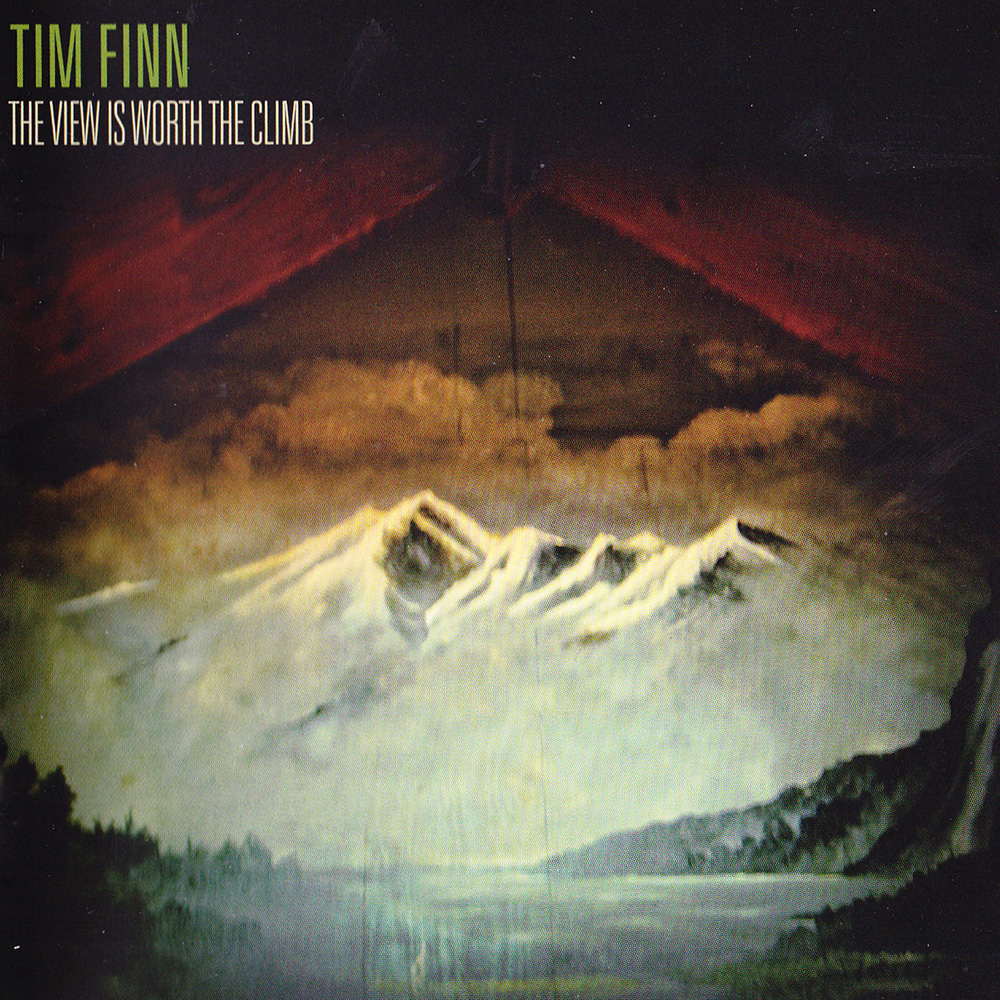
Tim Finn – The View Is Worth The Climb
 A new solo album that put the lie to Split Enz co-founder Tim Finn’s claims that he was done with his solo career, The View Is Worth The Climb is a welcome, if slightly subdued, new chapter of that career.
A new solo album that put the lie to Split Enz co-founder Tim Finn’s claims that he was done with his solo career, The View Is Worth The Climb is a welcome, if slightly subdued, new chapter of that career.
A little over ten years ago, Tim Finn was railing against turning 50 by turning out throat-thrashing, experimental albums that dipped their toes into electronica and yet were still a great listen. Now staring down the barrel of 60, he’s mining his material from the almost-normal home life that eluded him for so long, and it’s translating into pleasant listening that’s solidly in middle-of-the-road rock territory rather than actively looking for barriers to break down; it’s no accident that the album’s first track is “The Everyday.”
The lead single “Going Going Gone” is an apt opening act for The View Is Worth The Climb, demonstrating the album’s acoustic-leaning sound and hopeful lyrics. The only tracks that even threaten to break the album’s mid-tempo groove are “Wild Sweet Children” and “Can’t Be Found”, and those are really only a faster flavor of mid-tempo. My two favorite tracks, “Certain Way” and “Keep Talking”, dispense a bit with the carefree tone of the rest of the album, and the latter of the two almost has a ’70s AM radio groove going on.
 Overall, The View Is Worth The Climb is a very pleasant listen, if not necessarily one that’ll get everyone out of their seats to dance. Laid-back and relaxing, it’s a nice bonus round of new music from someone who – as of his career-spanning retrospective just a couple of years ago – said he was ducking out of the studio for a while.
Overall, The View Is Worth The Climb is a very pleasant listen, if not necessarily one that’ll get everyone out of their seats to dance. Laid-back and relaxing, it’s a nice bonus round of new music from someone who – as of his career-spanning retrospective just a couple of years ago – said he was ducking out of the studio for a while.
- The Everyday (3:13)
- The View Is Worth The Climb (3:57)
- Going Going Gone (3:49)
- All This And More (3:59)
- Wild Sweet Children (4:13)
- Everybody’s Wrong (3:16)
- Can’t Be Found (3:40)
- Opposite Sign (4:07)
- People Like Us (4:06)
- Certain Way (3:39)
- Keep Talking (3:49)
Released by: ABC Music
Release date: 2011
Total running time: 41:38
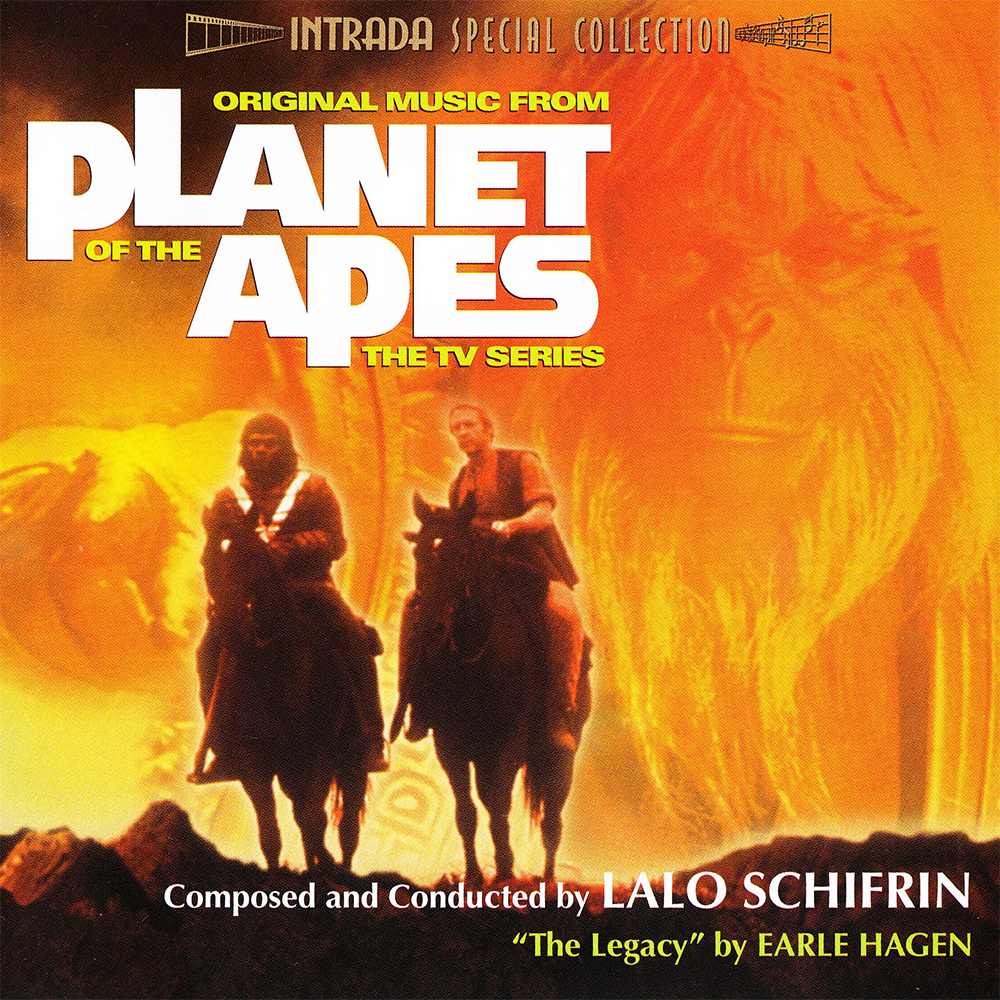
Planet Of The Apes: The Series
 The most unexpected Planet Of The Apes soundtrack of all is this compilation of music from the franchise’s brief extension in live-action TV. Though the series boasted some segments worthy of the Apes brand of storytelling, it’s often ignored by more serious afficionados of the original film series because it doesn’t try very hard to adhere to the movies’ timeline. What the TV series had going for it was lavish location filming, Roddy McDowall again donning the makeup of a sympathetic ape, and what was actually a fairly effective music library.
The most unexpected Planet Of The Apes soundtrack of all is this compilation of music from the franchise’s brief extension in live-action TV. Though the series boasted some segments worthy of the Apes brand of storytelling, it’s often ignored by more serious afficionados of the original film series because it doesn’t try very hard to adhere to the movies’ timeline. What the TV series had going for it was lavish location filming, Roddy McDowall again donning the makeup of a sympathetic ape, and what was actually a fairly effective music library.
With the rules of television scoring being different in the ’70s, not every episode of the Apes TV series got its own score; many of its installments were “tracked” from this music written for early episodes. Lalo Schifrin also composed the oppressive, guttural main theme, so his scores tended to quote that theme frequently, providing some unity. The episodes scores by Schifrin were less adventurous than, say, the same composer’s globe-style-trotting music for Mission: Impossible, but he wisely leans in favor of “aping” the brutal, occasionally dissonant sound established by the first movie’s groundbreaking Jerry Goldsmith soundtrack. With a smaller ensemble at his disposal, Schifrin makes the best use of his orchestral resources: there’s more brass than strings here, and he can’t hope to match Goldsmith’s wall of violent unconventional percussion. What he manages to pull off with that smaller orchestra is impressive.
Some of the better cues are the wrap-everything-up-on-a-less-hopeless-note final scenes from Schifrin’s scores. “Your World”, from the series pilot, is the musical epitome of “cautiously optimistic,” while “A Beginning” (the final cue of the show’s second hour, The Gladiators) is less certain in its feel-good send-off (and was used to close out many of the series’ installments). The Gladiators score also provides a showcase for what Schifrin was able to do with his more modest percussion section.
Another early episode score, The Legacy, was composed by guest musician Earle Hagen, and it’s distinctly different from Schifrin’s music. Less in-your-face pessimistic than Schifrin’s scores, Hagen’s music is more typical of mid 1970s drama scoring for American TV. Cues like The Soldiers demonstrate an attempt to mesh with the Schifrin scores, but most of the music is subtler and more mysterious, befitting the episode’s race to preserve a hologram which promises to be a storehouse of human scientific knowledge. Hagen went on to compose other scores for the series, ultimately providing almost a third of the show’s scores versus the two-thirds either scored by Schifrin or tracked from episodes previously scored by Schifrin.
The last score – incidentally closing out the first four episodes of the show – sees Schifrin return with a more robust percussion ensemble, and resuming the use of music that complements his main theme nicely. A few cues (the opening moments of “Riding For Urko” in particular) see Schifrin confidently stepping right up to the territory mapped out by Goldsmith’s score for the first Apes movie.  This score truly belongs in the Apes musical pantheon.
This score truly belongs in the Apes musical pantheon.
And so does the TV soundtrack as a whole. More obscure than even the later film sequels, the TV series suffered from a malady common to early ’70s TV science fiction – namely having well-worn plots from westerns or The Fugitive grafted onto the Planet Of The Apes backstory – but the music is one of the better things about the show, consistently reminding the audience of the stakes in play, even if the scripts didn’t make this quite so clear.
- Main Title (1:15)
Escape From Tomorrow by Lalo Schifrin
- The Spaceship (2:38)
- Apes (2:48)
- The Warp (2:03)
- Urko and Galen (4:05)
- Prison Guard (1:58)
- Jail Break (3:32)
- Your World (1:58)
The Gladiators by Lalo Schifrin
- Jason (1:11)
- Fighting (2:14)
- Barlow (1:50)
- Trouble (2:25)
- Into the Arena (2:47)
- There Will Be Death (0:53)
- Humans versus Apes (2:34)
- A Beginning (2:32)
The Legacy by Earle Hagen
- Into the Ruined City (2:28)
- The Machine (0:50)
- The Soldiers (2:30)
- The Key (1:25)
- Verdon and the Kid (1:10)
- The Family (1:56)
- The Reward (2:25)
- Knowledge Hunts (3:13)
- Farewell (0:38)
The Good Seed by Lalo Schifrin
- Riding for Urko (1:48)
- Travel Without Stars (3:18)
- Attack (3:18)
- Bonded Humans (2:26)
- Next String (2:27)
- End Credits (1:59)
Released by: Intrada
Release date: 2005
Total running time: 68:34
8 Bit Weapon – Bits With Byte
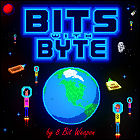 Logging in with the first full-album-length effort since the remixed Confidential 2.0, chiptune duo 8 Bit Weapon proves why it’s still practically the dictionary definition of this genre of music (i.e. “Chiptune music – you know, like 8 Bit Weapon”). It’s not enough to just slam the sounds (or samples) of old game machines together; there’s got to be a memorable tune under it. The earliest era of video game music turned out several hummable earworms despite the limitations of the day, and 8 Bit Weapon “gets” that. There’s always a tune behind the tech, and one often suspects the songs are strong enough to survive being transferred to more “traditional” instrumentation. (Now there’s an idea for a tribute album.)
Logging in with the first full-album-length effort since the remixed Confidential 2.0, chiptune duo 8 Bit Weapon proves why it’s still practically the dictionary definition of this genre of music (i.e. “Chiptune music – you know, like 8 Bit Weapon”). It’s not enough to just slam the sounds (or samples) of old game machines together; there’s got to be a memorable tune under it. The earliest era of video game music turned out several hummable earworms despite the limitations of the day, and 8 Bit Weapon “gets” that. There’s always a tune behind the tech, and one often suspects the songs are strong enough to survive being transferred to more “traditional” instrumentation. (Now there’s an idea for a tribute album.)
The sound is so old-school that, halfway through Bits With Bytes’ 18 tracks, one can imagine a “side one/side two” break (for those of you old enough to remember turning over the record or tape). The first nine songs are brand-new numbers, all instrumentals, with “The Art Of Video Games Anthem” (accompanying an upcoming exhibit at the Smithsonian), “We Fight For The Users”, “Escape From Xenon” and “Galactic Invasion” emerging as highlights. The title track is no slouch either (check out the official video below the jump at the bottom of the review). I got a kick out of the actual recording of a typically noisy, disk-drive-rattling Apple II boot-up (oh, the memories…) at the beginning of “Apple Core II”. There are enough melodic hooks here – or, at the very least, interestingly unconventional musical ideas – to keep you going for a while.
Starting with the tenth track, some of 8 Bit Weapon’s older material is revisited, with a positively hyperkinetic remix of “Closer” from the Electric High EP. Appropriately titled “Closer 2.0”, it’s definitely an upgrade. A revised “Micro Boogie” (one of my all-time favorites by this group) follows, though the differences may take a couple of listens to spot. The 8 Bit Bandit remix of “Closer” and the Sanxion7 remix of “Chip On Your Shoulder” (another revised Electric High number) substantially rearrange the DNA of the originals to make completely unique versions of each – again, this version of “Chip” may be superior to the original.
Demo versions of “Bits With Byte”, “The Art Of Video Games Anthem” and “Galactic Invasion” round things off; some artists demos show a striking difference in sound and production quality, but these instead offer a snapshot of the arrangements of each song in flux, not quite having landed on their final versions. Another new tune, “Vic XX”, closes things out nicely.
 I’m normally the first person to call shenanigans when almost half of a purportedly new album consists of older material, but here at least the material has been polished to an even higher shine than the originals – sort of like they’re in HD now. All of it’s worth a listen, especially if you don’t partake of 8 Bit Weapon’s shorter EPs (note: if you’re actually doing that, you’re depriving yourself of even more good stuff).
I’m normally the first person to call shenanigans when almost half of a purportedly new album consists of older material, but here at least the material has been polished to an even higher shine than the originals – sort of like they’re in HD now. All of it’s worth a listen, especially if you don’t partake of 8 Bit Weapon’s shorter EPs (note: if you’re actually doing that, you’re depriving yourself of even more good stuff).
- Bits with Byte (3:01)
- Galactic Invasion (3:03)
- Apple Core II (1:57)
- The Art of Video Games Anthem (3:12)
- Miami Dub Bounce (2:39)
- We Fight for the Users (3:05)
- Drive Grinder (3:11)
- Escape from Xenon (3:08)
- Goodbye Cochise (1:36)
- Closer 2.0 (2:45)
- Micro Boogie 2.0 (3:45)
- Chip On Your Shoulder (Electric High Mix) (3:20)
- Closer (8 Bit Bandit Remix) (6:02)
- Chip On Your Shoulder (Sanxion7 Remix) (3:30)
- Bits with Byte Demo (2:54)
- The Art Of Video Games Anthem Demo (3:16)
- Galactic Invasion Demo (2:54)
- Vic XX (3:18)
Released by: 8 Bit Weapon
Release date: 2012
Total running time: 56:36
Peter Gabriel – New Blood
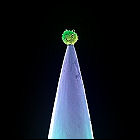 Picking up conceptually where the too-tame orchrstral cover album Scratch My Back left off, Peter Gabriel’s follow-up is another orchestral cover album, this time drawing from Gabriel’s own back catalog. I was so unimpressed with Scratch My Back that I elected not to review it here (in a nutshell: Gabriel’s cover of Paul Simon’s “Boy In Then Bubble” was the only track I bother to revisit since the first listen), so the thought of Gabriel giving his own material the same treatment didn’t excite me: would he pick the right songs? Would he saddle them with uninspired, Scratch My Back-style arrangements?
Picking up conceptually where the too-tame orchrstral cover album Scratch My Back left off, Peter Gabriel’s follow-up is another orchestral cover album, this time drawing from Gabriel’s own back catalog. I was so unimpressed with Scratch My Back that I elected not to review it here (in a nutshell: Gabriel’s cover of Paul Simon’s “Boy In Then Bubble” was the only track I bother to revisit since the first listen), so the thought of Gabriel giving his own material the same treatment didn’t excite me: would he pick the right songs? Would he saddle them with uninspired, Scratch My Back-style arrangements?
And yet some of Gabriel’s music just oozes widescreen majesty. Surely translation into a symphonic idiom could only expand on that… right?
Well… yes and no. Gabriel is working with the same arranger with whom he collaborated on Scratch My Back here, so it’s hit or miss. “Rhythm Of The Heat” is pretty typical of the album as a whole”: for the most part it’s a competent enough translation of the original version of the song, but adds nothing new except a swap-out of rock instruments for orchestral instruments. It’s unadventurous. That description applies to many of the album’s covers. Very few songs break the mold and make me go “wow” – “Intruder” is a good example of this, taking the (already disturbing) original song and reshaping it into an unnerving piece of horror movie music – but most fall into the spineless category. Worse yet, Gabriel’s voice isn’t capable of the acrobatics he could pull off in his younger years, stripping even more of the “oomph” from the songs as he tones the vocals down along with the instruments.
If you’re detecting a recurring theme here, aside from “this could have been so much better,” you’re not imagining things. Peter Gabriel is a maker of mind-expanding, widescreen music. It’s not for nothing that he’s scored movies before (Birdy, The Last Temptation Of Christ), and it’s not for nothing that he was selected to assemble the world-music-rock-opera for London’s Millennium Dome (OVO). And yet New Blood seems to sap the blood from the same songs that made me a Peter Gabriel fan in the first place.
Maybe what this album needed was some TLC from someone who actually does soundtracks, rather than the same numbingly dull approach as Scratch My Back. Bear McCreary of Battlestar Galactica soundtrack fame, who is credited by a lot of that show’s fans for exposing them to new and different styles of music, would have knocked this out of the park and (excuse the pun) straight into orbit, fusing orchestral and ethnic music with ease.
 I hope Peter Gabriel resumes his more traditional style of music for whatever he releases next. The songs selected for New Blood were enthralling in their original versions because they were so unconventional. New Blood squandered the opportunity to expand on those songs by make them not just convention, but watered-down shadows of their former selves.
I hope Peter Gabriel resumes his more traditional style of music for whatever he releases next. The songs selected for New Blood were enthralling in their original versions because they were so unconventional. New Blood squandered the opportunity to expand on those songs by make them not just convention, but watered-down shadows of their former selves.
Disc One – Vocals
- The Rhythm Of The Heat (5:41)
- Downside Up (3:52)
- San Jacinto (6:58)
- Intruder (5:07)
- Wallflower (6:25)
- In Your Eyes (7:13)
- Mercy Street (5:59)
- Red Rain (5:15)
- Darkness (6:10)
- Don’t Give Up (6:40)
- Digging In The Dirt (4:57)
- The Nest That Sailed The Sky (3:54)
- A Quiet Moment (4:48)
- Solsbury Hill (4:35)
Disc Two – Instrumentals
- The Rhythm Of The Heat (instrumental) (5:41)
- Downside Up (instrumental) (3:52)
- San Jacinto (instrumental) (7:12)
- Intruder (instrumental) (5:06)
- Wallflower (instrumental) (6:24)
- In Your Eyes (instrumental) (7:13)
- Mercy Street (instrumental) (6:00)
- Red Rain (instrumental) (5:15)
- Darkness (instrumental) (6:10)
- Don’t Give Up (instrumental) (6:40)
- Digging In The Dirt (instrumental) (4:58)
- The Nest That Sailed The Sky (instrumental) (3:54)
- The Blood Of Eden (instrumental) (6:05)
Released by: RealWorld
Release date: 2011
Disc one total running time: 77:34
Disc two total running time: 74:30
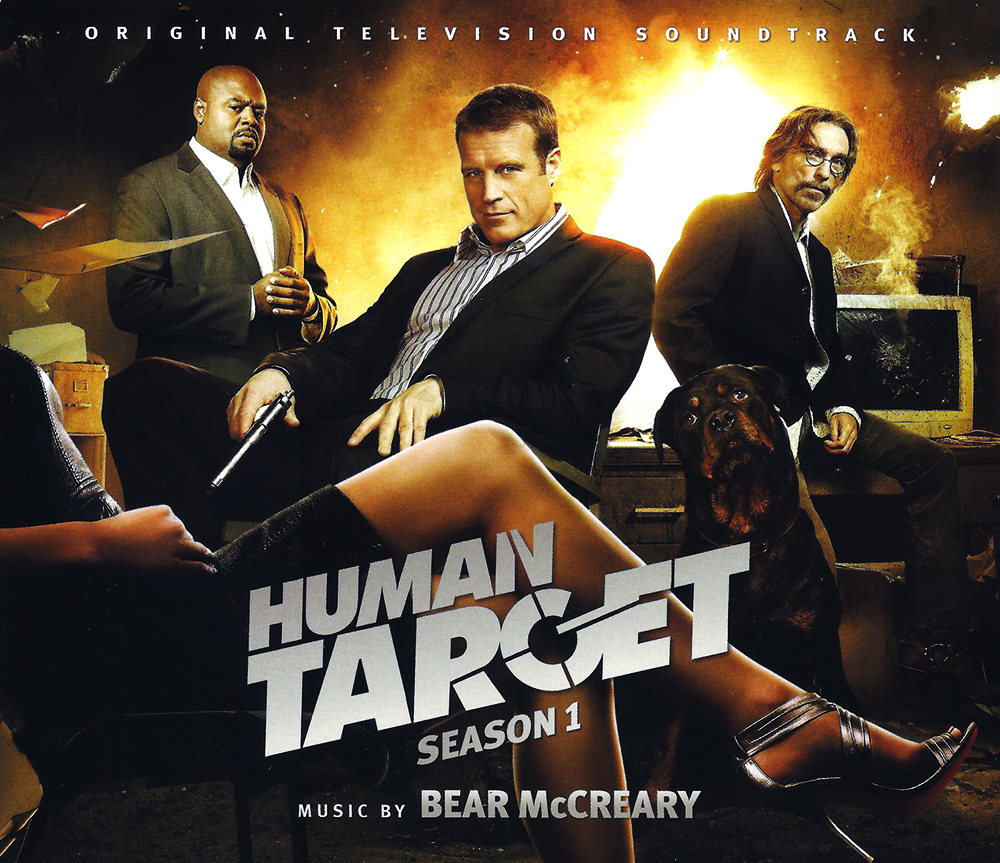
Human Target – music by Bear McCreary
Based on the comic of the same name, Fox’s TV series Human Target may have already set a record: according to Variety, its music was recorded by the largest orchestra assembled for an American TV series in well over ten years. Human Target isn’t a terribly high-profile project, and Fox doesn’t reach deep into its pockets for no reason; that huge orchestra was hired because of the acclaimed composer handling the music: Battlestar Galactica alumnus Bear McCreary. It’s a pretty good bet that McCreary’s name is what got this music released, too: Warner Bros. Watertower Music label released two CDs worth of music as a digital download, while McCreary’s home label La-La Land Records unleashed a 1,200 copy run of a 3-CD set covering everything in Watertower’s digital release and then some, including a few work-in-progress sketches created as precursors to the orchestral sessions.
McCreary’s music is flat-out, unabashed action music of a kind that hasn’t been heard since John Williams was in the business of scoring every blockbuster that wasn’t assigned to Jerry Goldsmith. There are, in fact, a few passages of music that bring Star Wars instantly to mind. McCreary establishes the Human Target theme up front in the extended version of the main titles, and uses it as a motif in many, if not most, of the cues from the show’s episodes. Other themes begin to recur for the show’s ensemble of characters.
And if you’re wondering if it makes any difference that this music was recorded by the largest orchestra to record TV music in ages, fear not – you can tell. The balls-to-the-wall action scenes have the kind of full-blooded feel that samples and synths just can’t quite cut (at least not without sounding like a wall of synths). There are still some synthesizers in the mix, along with the usual suspects (i.e. Oingo Boingo alum Steve Bartek on guitar) and the kind of big percussion for which McCreary became known on Galactica, but the orchestra is front and center in the mix. (And for the record, it really doesn’t sound anything like Galactica.)
The show itself failed to grab me, but I continue to find myself humming bits of the soundtrack here and there, occasionally from episodes I didn’t even see. A major turnover of behind-the-scenes personnel between Human Target’s two seasons on the air left both  its original showrunner and McCreary out in the cold, and there seems to be little disagreement that the result was something less watchable (which eventually led to its cancellation) and certainly less listenable. And it’s perhaps just as well: the quality of McCreary’s work makes every released soundtrack a calling card, and it can’t be too long before steady feature work is more prominent than TV scoring on his resume, because this is big-screen-worthy music.
its original showrunner and McCreary out in the cold, and there seems to be little disagreement that the result was something less watchable (which eventually led to its cancellation) and certainly less listenable. And it’s perhaps just as well: the quality of McCreary’s work makes every released soundtrack a calling card, and it can’t be too long before steady feature work is more prominent than TV scoring on his resume, because this is big-screen-worthy music.
Disc One
- Theme from ‘Human Target’ (long version) (1:31)
- Skydive (5:19)
- No Threats (4:17)
- Military Camp Rescue (4:37)
- Motorcycle Escape (5:29)
- Monastery in the Mountains (1:41)
- Paint a Bullseye (2:19)
- The Katherine Walters File (4:30)
- Switching Sides (6:09)
- This is Awkward (2:11)
- The Russian Embassy (3:32)
- The Devil’s Mouth (1:21)
- Ice Cubes (2:05)
- Allyson’s Past (3:05)
- Flipping the Plane (10:53)
- Driving Away (0:48)
- Airborne and Lethal (3:34)
- Chance’s Old Boss (3:54)
- Old Chance (2:14)
- Skyhook Rescue (7:05)
- Into the West (1:35)
Disc Two
- New York City Arrival (1:52)
- Train Fight (3:33)
- Baptiste (2:39)
- Tango Fight (1:27)
- Maria and Chance (2:35)
- Katherine’s Killer (4:10)
- Confronting Baptiste (8:51)
- Courthouse Brawl (5:09)
- Stop Running (3:08)
- Not a Pacifist (0:46)
- Bullet Train (1:56)
- Gondola (8:43)
- An Old Life (3:21)
- Lockdown (5:02)
- A Bottle of Japanese Whisky (1:34)
- Victoria (3:29)
- The New Champion (5:56)
- Emma Barnes (3:10)
- Stephanie’s Ring (1:50)
- Port Yard Deaths (2:52)
- The New Christopher Chance (6:34)
- Theme from ‘Human Target’ [Short version] (0:40)
Disc Three
- Flight Attendant Wilson (0:49)
- Round One (3:25)
- Emma’s Bra (2:24)
- Maria Gallego (1:58)
- Afraid in Alaska (1:21)
- Guerrero and Sergei (2:51)
- Chance Takes the Job (0:54)
- Tracking Device (3:03)
- The Black Room (1:41)
- Fighting Kendrick Taylor (1:27)
- Bertram (6:59)
- Sparring Guerrero (1:46)
- Scar Stories (3:35)
- Danny’s Killer (2:42)
- Chaos in the Cockpit (5:49)
- A Mistake (0:50)
- Chance’s Theme (Sketch Version 1) (1:17)
- Chance’s Theme (Sketch Version 2) (1:44)
- Katherine’s Theme (Solo Piano Version) (1:48)
- Theme from Human Target (Alternate Short Version) (0:38)
Released by: La-La Land Records
Release date: 2010
Disc one total running time: 78:16
Disc two total running time: 79:23
Disc three total running time: 47:11
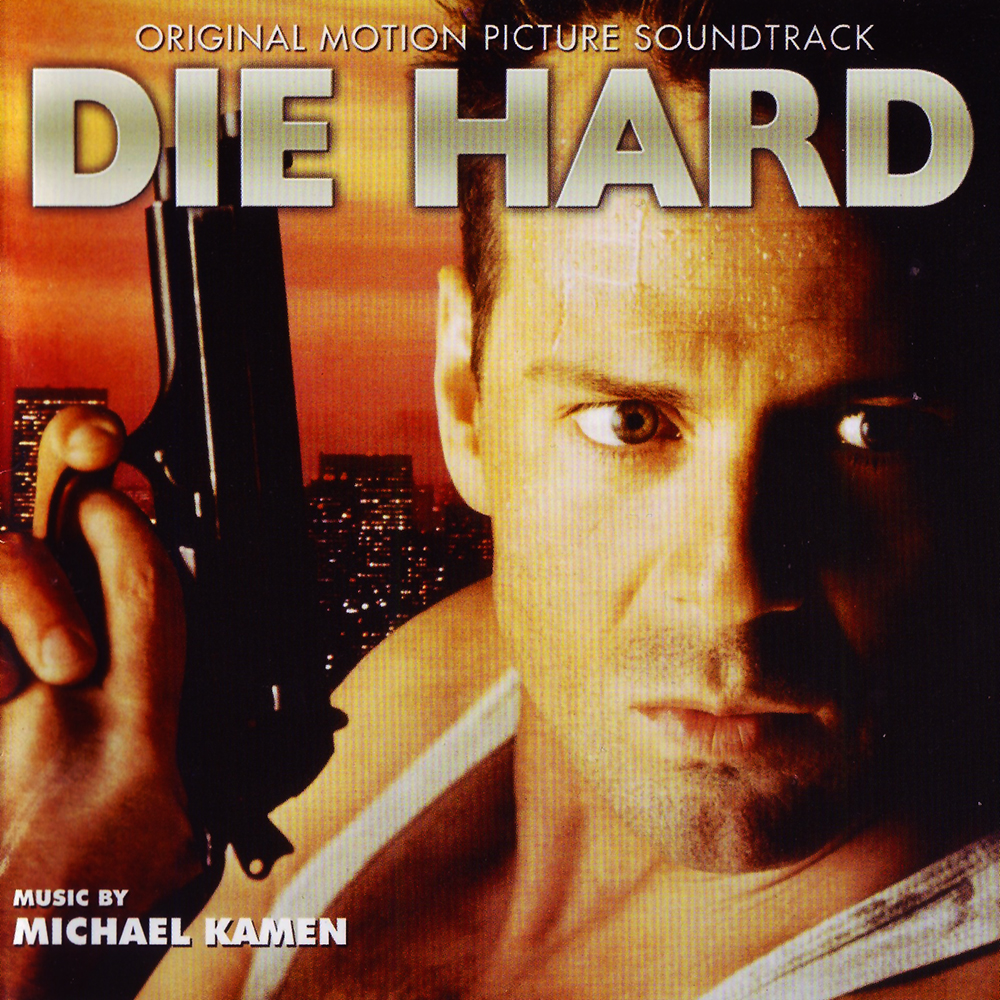
Die Hard (Limited Edition) – music by Michael Kamen
Action films rarely age like fine wine. Most are so rooted in the time period they were released, it’s hard to look past the menagerie of dated cinematic conventions and appreciate them for the fun fluff that they are designed to be. Personally, it’s hard to separate Dirty Harry’s vigilante ambitions from all the sideburns, deliberate camera zooms and funky background music that so characterized ’70s action flicks. Despite their greater leap toward modernization, ’80s films don’t fare much better in the rear-view. The desperate, tortured hero of the ’70s action film was replaced by larger-than-life supermen capable of escaping any trap they were up against. Explosions were bigger, special effects were grander, and if your first name was Arnold, Sylvester, or Harrison you were guaranteed a very secure future in Hollywood. It was a refreshing change from the dreary nihilism that characterized the ’70s, but by the end of the ’80s, the new action formula was itself beginning to grow tired and predictable and not even Steven Spielberg could enliven a genre of action films that he himself helped to inaugurate with Raiders Of The Lost Ark.
Then came a little movie called Die Hard in 1988.
Okay, it wasn’t exactly a little movie. Bruce Willis was already an established star and the movie had some of the best production minds in Hollywood working on it. But nothing about the movie conformed to the established ’80s action-movie style. Deliberately stylized with a wry, tongue-in-check tone, Die Hard banished the superman lead in favor of an anti-hero – an everyday guy caught up in extraordinary circumstances who prevails against the villains – in this case, a group of German “terrorists”. It’s worth buying a special edition DVD just for director John McTiernan’s commentary, who talks at length about the initial resistance he faced for his unconventional, European style of directing and editing. Die Hard ultimately won over just about everyone, becoming a monstrous success and spinning off a new genre of action movies. It also further catapulted McTiernan and cinematographer Jan De Bont into stardom (De Bont would turn in equally impressive DP work on The Hunt For Red October and Basic Instinct before getting his first crack at directing with Speed in 1994).
Critical to Die Hard‘s success was its score by Michael Kamen. Embracing the movie’s dark sense of humor, Kamen loaded the score with sleigh bells and melodic nods to famous classical musical compositions and holiday tunes to give his driving, rhythmic assault a subversive sense of whimsy. As good as the score sounds when viewing the movie, it is even more astonishing in its intricacy and creativity when listening to it by itself. La-La Land’s newly remastered, two-CD set of the Die Hard score spoils you with nearly every note Kamen threw at this movie, and then some. With over 107 minutes of total music included, it’s easy to see just how musically dense Die Hard was. Today, Kamen’s Die Hard score remains a celebrated achievement in action movie scoring.
It would be easy to say the best tracks in the set are the ones where Kamen truly cuts loose, and “Assault on the Tower” is unquestionably his most thrilling composition. The music is both playful and relentless as it unscores the SWAT team’s ill-fated attack on the terrorists in the Nakatomi building. But Kamen’s real genius is how he perverts the innocent spirit of songs such as “Ode To Joy” by Beethoven and “Winter Wonderland” and “Singing In The Rain” by using them as motifs for the German terrorists (Listen: “Terrorist Entrance”). Elsewhere, there’s certainly enough pounding hyperbole to justify the more bombastic action sequences in the movie, but its Kamen’s subtlety and ability to validate some deliberately cartoonish arrangements that make the score so shockingly good. One of McClane’s early motifs is a corny steel guitar arrangement that is nonetheless highly effective in identifying him as the “cowboy” Hans sees him as (“John’s Escape/You Want Money”). Later, Kamen crafts a more fatalistic four-note motif that grounds the character more and suggests his survival is much more tenuous then we at first believed (“And If He Alters It”). In the overall, however, Kamen stays loyal to the movie’s playful spirit, using tip-toeing pizzicato and other strange electronic effects to highlight the fun cat-and-mouse movie moments.
Film score critic Jeff Bond provides an exhaustive, yet illuminating, track-by-track analysis of the score in the CD set’s liner notes. The set naturally includes tracks that weren’t included in the movie or were heavily piped down in the final mix. An example of an omission that actually benefitted the movie was an arrangement Kamen crafted for the exploding office chair McClane’s throws down the elevator shaft to thwart the terrorists. Stopping the music just as the chair begins its descent, as it does in the movie, heightens the feeling of anticipation; this effect would have been lost had the producers decided to score this section (“Assault On The Tower”).
 As a longtime fan of the movie, I thought I knew just about everything there was to know about Die Hard. Eric Lichenfeld, in his liner notes, proved me wrong. For example, I did know Alan Rickman was attached to a quick-release harness and released to capture his shocked expression when he plummets from the tower at movie’s end, but I didn’t know the producers tricked Rickman as to when he’d fall in the 3-2-1 countdown (he was dropped on 1, rather than the expected zero!). La-La Land Records sold out their entire supply of the CD set within 72 hours of release – no doubt a testament to the enduring popularity of this groundbreaking score.
As a longtime fan of the movie, I thought I knew just about everything there was to know about Die Hard. Eric Lichenfeld, in his liner notes, proved me wrong. For example, I did know Alan Rickman was attached to a quick-release harness and released to capture his shocked expression when he plummets from the tower at movie’s end, but I didn’t know the producers tricked Rickman as to when he’d fall in the 3-2-1 countdown (he was dropped on 1, rather than the expected zero!). La-La Land Records sold out their entire supply of the CD set within 72 hours of release – no doubt a testament to the enduring popularity of this groundbreaking score.
Disc One
- Main Title (0:38)
- Terrorist Entrance (4:05)
- The Phone Goes Dead / Party Crashers (1:51)
- John’s Escape / You Want Money? (6:00)
- Wiring the Roof (1:51)
- Fire Alarm (2:04)
- Tony Approaches (1:41)
- Tony and John Fight (1:11)
- Santa (0:56)
- He Won’t Be Joining Us (3:01)
- And If He Alters It (2:39)
- Going After John (4:29)
- Have a Few Laughs / Al Powell Approaches (3:31)
- Under the Table (1:55)
- Welcome to the Party (1:09)
- TV Station (2:47)
- Holly Meets Hans (1:19)
- Assault on the Tower (8:35)
Disc Two
- John is Found Out (5:03)
- Attention Police (3:54)
- Bill Clay (4:09)
- Shooting the Glass (1:07)
- I Had an Accident (2:37)
- The Vault (3:07)
- Message for Holly (1:07)
- The Battle / Freeing the Hostages (6:53)
- Helicopter Explosion and Showdown (4:00)
- Happy Trails (1:12)
- We’ve Got Each Other (1:57)
- Let it Snow (1:43)
- Beethoven’s 9th (End Credits Excerpt) (4:00)
- The Nakatomi Plaza (1:47)
- Message for Holly (Film Version) (2:46)
- Gun in Cheek (1:03)
- Fire Hose (1:00)
- Ode to Joy (Alternate) (2:11)
- Let it Snow (Source) (1:58)
- Winter Wonderland (Source) (1:26)
- Christmas in Hollis performed by Run-DMC (3:00)
- Roy Rogers Meets Beethoven’s 9th (Muzak) (1:36)
Released by: La-La Land Records
Release date: 2011
Disc one total running time: 49:42
Disc two total running time: 57:36
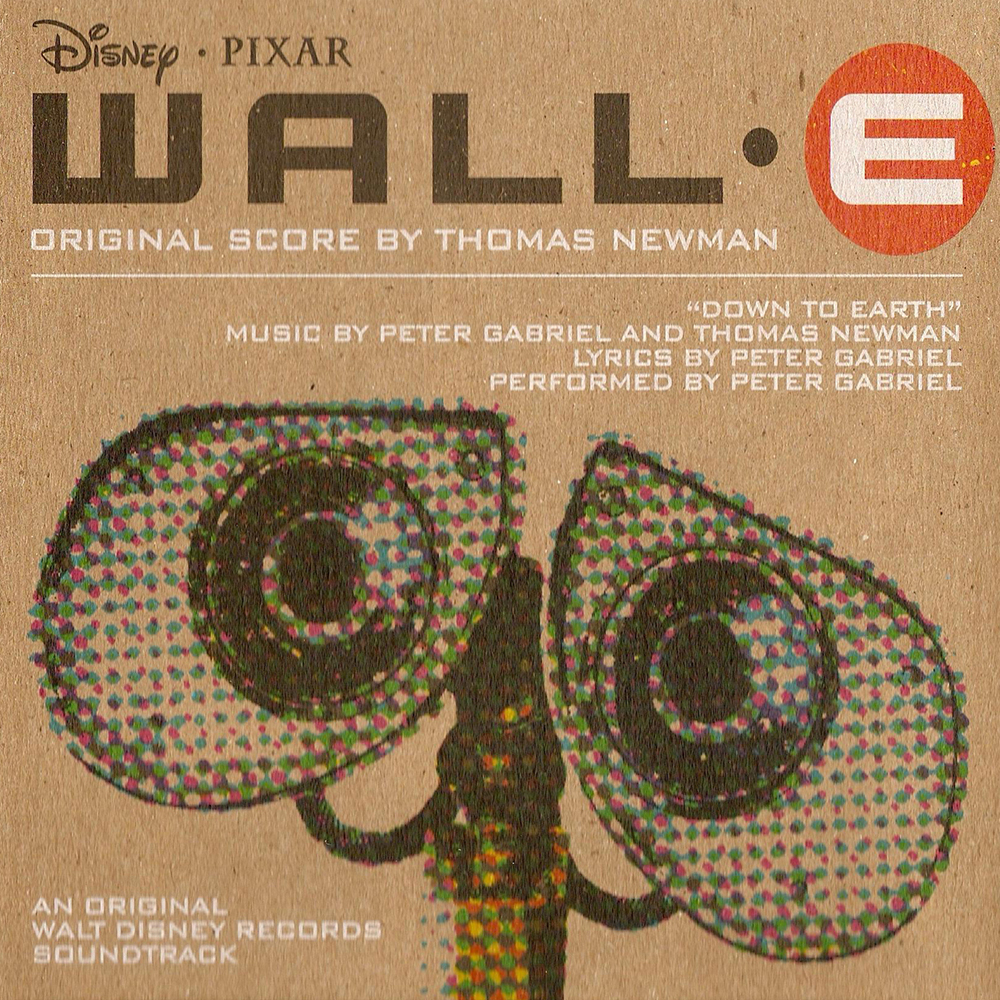
WALL-E – music by Thomas Newman
 This is the soundtrack of a movie whose composer was either in love with the assignment, or lived in fear of it. Most movie scores are tasked with the job of underlining the emotional intent of any given scene, but with most movies this job is occasionally obscured by dialogue or sound effects. WALL-E had sound effects aplenty, but instead of dialogue, virtually the first half hour of the movie is expressed in terms of “robotic” processed grunts and exclamations. There are visual cues to the emotions being expressed, but the bulk of the legwork falls to the music: a unique opportunity for any composer to shine, but also a daunting task for modern-day composers accustomed to dialing the music back to make room for dialogue.
This is the soundtrack of a movie whose composer was either in love with the assignment, or lived in fear of it. Most movie scores are tasked with the job of underlining the emotional intent of any given scene, but with most movies this job is occasionally obscured by dialogue or sound effects. WALL-E had sound effects aplenty, but instead of dialogue, virtually the first half hour of the movie is expressed in terms of “robotic” processed grunts and exclamations. There are visual cues to the emotions being expressed, but the bulk of the legwork falls to the music: a unique opportunity for any composer to shine, but also a daunting task for modern-day composers accustomed to dialing the music back to make room for dialogue.
Thomas Newman, who had already worked with Pixar on Finding Nemo, took on the task and delivered what may be one of the best film scores of the 2000s, hands down. There’s a lot of music on the CD – and there’s a heap of music in the movie as well. Occasionally there’s a little burst of sound effects and “robot dialogue” from the movie in between songs, but to its credit, it never overlaps the music – and to be honest, I’d buy a whole CD of Ben Burtt’s brilliant soundscapes because the former Star Wars sound guru topped himself here.
The three songs heard prominently in the movie are heard here – the Louis Armstrong version of “La Vie En Rose” and the two numbers from Hello Dolly! – as well as Peter Gabriel‘s hammer-the-theme-of-the-movie-home end credits song “Down To Earth” (which, to be honest, I liked better than either of the albums he’s foisted on us since being involved with this movie).
The bulk of the soundtrack is taken up with Newman’s intricate, well-thought-out score, though. In some ways, he does the same thing Jerry Goldsmith did with Logan’s Run, but in reverse order: the “exterior” scenes on Earth and treated orchestrally, but once WALL-E boards the Axiom and enters the woeful artificial environment now inhabited by the descendants of the human race, our glimpses into life aboard that ship and the scenes involving the Axiom robots are given an electronic (but still melodic and playful) sound. As the action centers more and more on the fate of the sample of a live plant from Earth, the music returns to the orchestral vein, because the Earth is what’s at stake.
Tracks such as “The Spaceship”, “Worry Wait”, “EVE Retrieve”, “Hyperjump” and “WALL-E’s Pod Adventure” are orchestral spectaculars befitting just about any big-screen science fiction epic you could name. The music here has the entire weight of carrying the implications to the audience, and does the job brilliantly. Newman treats these scenes as Serious Events without worrying about scaring the kids off with spooky or scary music – so much so that even my own son has been asking me what the music “means,” enabling me to kick open some interesting conversations about soundtrack music and music in general with him. At the age of four. Thank you, Mr. Newman, for not “talking down” to the audience.
That’s not to say that the soundtrack doesn’t have a sense of humor. “First Date,” accompanying a montage of WALL-E sheltering the inert EVE from the elements (scenes that director Andrew Stanton reportedly wanted set to the vapid tune of “Raindrops Keep Falling On My Head”), gets the kind of music you’d expect from a first date movie montage, except that most movies don’t have the girlfriend sitting comatose and unresponsive throughout the proceedings. The music is deceptively cheerful and becomes its own punch line.
Aboard the Axiom, there are some standout electronic and electronic/orchestral tracks – “Foreign Contaminant”, “Repair Ward” and “72 Degrees And Sunny” among them – which convey the robotic precision of the Axiom’s automated crew a mixture of acoustic and electronic percussion and a lot of intricate guitar progressions from George Doering (a veteran session guitarist who’s also played on numerous Star Trek soundtracks). The dreamy “Define Dancing” was rescored late in production so Newman could hint at “Down To Earth,” which he co-wrote with Peter Gabriel.
Late in the movie, as the humans have to shake off the shackles of their own mechanical support systems in order to regain some semblance of a human existence and return to Earth, tracks like “March Of The Gels”, “Tilt”, “Desperate EVE” and “Mutiny!” – the latter of which sounds in places like it could’ve been part of The Matrix, of all things – combine the two approaches.
 It’s a brilliantly cohesive collection of music for a movie that actually has meaning, and I applaud Disney for putting an entire album of orchestral score out there for the young set. The soundtrack album from WALL-E may just have the effect on my son’s generation that the soundtrack from Star Wars had on me. And that’s not a bad thing at all. This is one of the best genre soundtracks of the past decade from one of the best genre movies of the past decade.
It’s a brilliantly cohesive collection of music for a movie that actually has meaning, and I applaud Disney for putting an entire album of orchestral score out there for the young set. The soundtrack album from WALL-E may just have the effect on my son’s generation that the soundtrack from Star Wars had on me. And that’s not a bad thing at all. This is one of the best genre soundtracks of the past decade from one of the best genre movies of the past decade.
- Put On Your Sunday Clothes performed by Michael Crawford (1:17)
- 2815 A.D. (3:28)
- WALL-E (2:00)
- The Spaceship (1:42)
- EVE (1:02)
- Thrust (0:41)
- Bubble Wrap (0:50)
- La Vie En Rose performed by Louis Armstrong (3:24)
- Eye Surgery (0:40)
- Worry Wait (1:19)
- First Date (1:19)
- EVE Retrieve (2:19)
- The Axiom (2:24)
- BNL (0:20)
- Foreign Contaminant (2:06)
- Repair Ward (2:20)
- 72 Degrees and Sunny (3:12)
- Typing Bot (0:47)
- Septuacentennial (0:15)
- Gopher (0:40)
- WALL-E’s Pod Adventure (1:13)
- Define Dancing (2:23)
- No Splashing No Diving (0:47)
- All That Love’s About (0:37)
- M-O (0:47)
- Directive A-113 (2:05)
- Mutiny! (1:28)
- Fixing WALL-E (2:08)
- Rogue Robots (2:03)
- March of the Gels (0:54)
- Tilt (2:00)
- The Holo-Detector (1:07)
- Hyperjump (1:04)
- Desperate EVE (0:57)
- Static (1:43)
- It Only Takes a Moment performed by Michael Crawford (1:07)
- Down to Earth performed by Peter Gabriel (5:58)
- Horizon 12.2 (1:27)
Released by: Walt Disney Records
Release date: 2008
Total running time: 61:54
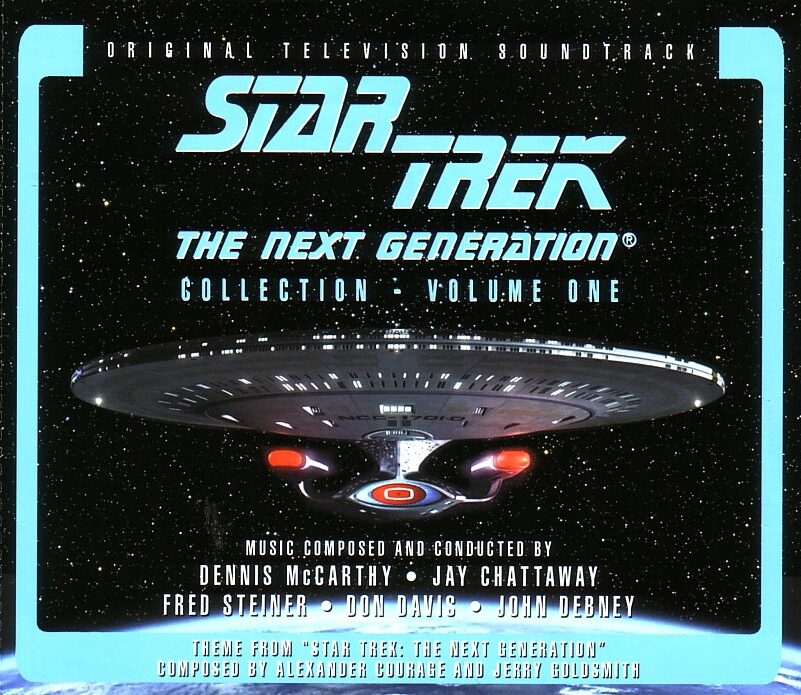
Star Trek: The Next Generation Collection Volume 1
In 2010, when Film Score Monthly took a huge financial gamble on the release of a lavish 14-disc box set chronicling all of composer Ron Jones’ contributions to Star Trek: The Next Generation, the label found itself having to fight not just protests about the price tag, but the commonly held misconception that TNG’s music, from its first season to its last, was a wall of droning synth music. (In fact, the show frequently boasted one of the biggest music budgets in TV, with at least a partial orchestra booked for most episodes.)
Weighing in at three discs, La-La Land’s Star Trek: The Next Generation Collection Volume 1 devotes one disc to a broad selection of music by Dennis McCarthy, another disc to Jay Chattway, and a third disc to composers whose stints on TNG proved to be one-offs. This is far from an indication that these musicians were never invited back, however – rather, they soon became far too busy on other projects. These one-off composers include John Debney (seaQuest DSV, Doctor Who, The Passion Of The Christ), Don Davis (the Matrix trilogy) and the late Fred Steiner (the only composer to score both original TV Star Trek and TNG).
This set puts the lie to the “wall of synths” accusation often unfairly leveled at the series’ music by fans who either have a short memory or simply don’t know any better, but one of the three discs proves the critics’ point about droning.
Dennis McCarthy remains the alpha and omega of post-original-series Star Trek music: he scored the pilot episode of TNG in 1987 and the series finale of Star Trek: Enterprise in 2005. In between, he scored computer games, theme park rides and one movie based on the series. McCarthy’s sound is expansive, with French horns frequently sounding almost heraldic chord changes and strings arranged to give the show a widescreen, cinematic sound. While Ron Jones’ music may have been more “involved,” it’s hard to argue that McCarthy’s often comes across as more sophisticated. This first disc is full of series highlights, among them my favorite early episode, Conspiracy, which seemed on the surface like it should have spun the entire rest of the show in a different direction. Other big, brassy, noteworthy McCarthy scores include Sarek, Time Squared and The Child. Some of the cues where McCarthy eschews his usual style are among the most effective in the entire three-disc set, with The Survivors and The Big Goodbye being particularly worth a listen.
With Jones vanishing halfway through the series – having irked executive producer Rick Berman one too many times – the fourth season saw the introduction of his replacement, Jay Chattaway, who had filled in for Jones on the episodes Tin Man (already released by GNP Crescendo) and Remember Me (included here). Though those two early entries were very strong, Chattaway settled into a groove – or, perhaps arguably, a rut – where he frequently reused chord progressions. Some of Chattaway’s work used interesting, almost eastern chords, while other pieces went heavy on dissonance.
The problem with Chattaway’s disc is also the problem with his scoring of the series: the reuse of material is very noticeable. Episodes like Starship Mine, Journey’s End and I, Borg, which feature scenes that should crank up the action or the menace, are lulled into a somnolent daze where the music says “nothing is happening here.” Chattaway is at his best with more contemplative, exotic episodes as Darmok and The Inner Light. Also featured on the Chattaway disc, mainly because the fans would form a lynching party if it wasn’t included, is the “Scotty on the holodeck bridge” music from Relics.
The third disc is the most eye-opening surprise. Original series composer Fred Steiner wakes up everyone who fell asleep during the second disc with Code Of Honor, a busy, boisterous score that would’ve been right at home on Kirk’s Enterprise, and sadly represents Steiner’s only voyage aboard Picard’s Enterprise. Had Steiner stayed on, creating a McCarthy-Jones-Steiner rotation, the show would’ve benefitted greatly – and Steiner likely would’ve been spaced long before Jones. Code Of Honor boasts some great music (pity about the script it accompanied, though).
Fred Steiner sadly died just before this set was released.
Don Davis’ Face Of The Enemy isn’t quite as stunning, but compared to the state of TNG’s music circa season 6 (the almost complete lack of music from that season from either McCarthy or Chattaway is both conspicuous and telling), it stands out almost as much as Code Of Honor did in season one, with bold flourishes and a big sound. Less surprising is John Debney’s The Pegasus, which almost sounds like a McCarthy score. Debney’s score is at its best when illustrating the episode’s dark moral dilemma for Commander Riker.
Rounding things off are various arrangements of the opening titles, end credits, and even the post-fade-out “bumpers” that were seen and heard at the end of each act before the commercial break (now forever consigned to the aging memories of those of us who saw the show before it was on DVD). Two oddball arrangements of the original series theme are on disc three – the liner notes reveal that these were recorded for use on the gag reels shown at the cast and crew’s private end-of-season wrap parties.
 This would be a four-star collection, except that a bizarre choice of Chattaway material makes the composer sound sleepy, when a different selection of episodes would’ve yielded much better music (Chain Of Command is very conspicuous by its absence). And again, La-La Land Records has found itself battling the age-old perception of TNG’s music as synthesized dreck – after an impressive initial burst of sales (including the set’s debut at the 2011 San Diego Comic Con), much of the inventory remained in the warehouse, casting doubt on the label’s promise to mine the Deep Space Nine and Voyager music vaults. This nicely-prepared collection didn’t deserve that fate, as a lot of it (chiefly discs 1 and 3) is better than even I remembered.
This would be a four-star collection, except that a bizarre choice of Chattaway material makes the composer sound sleepy, when a different selection of episodes would’ve yielded much better music (Chain Of Command is very conspicuous by its absence). And again, La-La Land Records has found itself battling the age-old perception of TNG’s music as synthesized dreck – after an impressive initial burst of sales (including the set’s debut at the 2011 San Diego Comic Con), much of the inventory remained in the warehouse, casting doubt on the label’s promise to mine the Deep Space Nine and Voyager music vaults. This nicely-prepared collection didn’t deserve that fate, as a lot of it (chiefly discs 1 and 3) is better than even I remembered.
Music by Dennis McCarthy
- Star Trek: The Next Generation Main Title Season 3 (1:49)
Haven
- Haven / Harpies / Gifts (2:06)
- Starship / Lost Love / Wyatt & Troi / Mom Arrives (3:26)
- In Practice / Tradition / Cuestosity (Not Used) / Mental Flame / Leper Colony (4:44)
- Petty (0:54)
- Desert Panorama / Proposal / Tractor Beam (2:51)
- Ariana / Plan to Die / Preparation / Alien Vessel / Departure / Next Adventure (7:54)
Hide and Q
- Miracle Worker / Lights Out / Time Lapse (5:24)
The Big Goodbye
- (You Came Along From) Out of Nowhere (3:24)
Conspiracy
- Worf Down / Invader / Dinner Treats / Retching Remmick / Recovery / Cliff Hanger (7:44)
The Child
- Rendezvous / Liaison (2:15)
- Aucdet IX / Containment Out / The Birth Growth Spurt (5:11)
Elementary, Dear Data
- Stardate / Holmes’s Pipe / Holmes’s Pipe 2 (0:54)
- Denouement / The Challenge (0:57)
Time Squared
- P-2 Arises / Hall Twins / P-2 Dies / Escape / No Repeat (6:08)
The Survivors
- Music Boxer (1:03)
- Telepathic / Kevin’s Waltz / Unbridged (4:36)
- Music Box (0:39)
Sarek
- Logging / Solution / Mind Meld / Angstosity / Back to Reality / Goodbyes (6:26)
Conundrum
- MacDuff Exposed / Meeting the Girls / Confused (4:40)
All Good Things…
- Saved Again (2:27)
- I Have a Gun (0:52)
- Star Trek: The Next Generation End Title: Season 3 Long Version (1:55)
Music By Jay Chattaway
- Star Trek: The Next Generation Main Title Season 2 (1:39)
Remember Me
- Old Friend / Return to Starbase (1:06)
- The Traveler / Through the Bubble (7:08)
The Host
- Sorry / Jay (3:34)
- No Pain, No Gain (2:04)
- Can’t Be Apart (2:18)
- Surprised / Last Waist Kiss (1:12)
Darmok
- Doo Doo Occurs (3:04)
- Telling a Story / Gone Forever (4:07)
- Tired of Sitting Around / What’s a Life Worth? (4:55)
Silicon Avatar
- Running for Cover / Someone’s Comin’ (3:25)
- So, We Finally Meet (3:51)
The Perfect Mate
- Hard to Resist (3:07)
- I’ve Bonded With You (1:19)
I Borg
- The Borg Pick Up Hugh (2:40)
The Inner Light
- Lullaby #1 (0:50)
- Naming Dance #1: alternate (1:15)
- The Answer to a Mystery / Lullaby #1A (4:20)
Relics
- Scotty’s Bridge (0:40)
- Captain in Rank Only / Scotty to the Rescue / Mister Good Hands (4:43)
Starship Mine
- Greedy Double Crosser / Fight to the Death (6:51)
The Chase
- Message Received (2:50)
Journey’s End
- War or Peace / Wes Goes on His Way (6:08)
Bonus Tracks from The Inner Light:
- Naming Ceremony, Alternate (Not Used)
(1:20)
- Naming Dance, Up-Tempo Version (Not Used) (1:08)
- Star Trek: The Next Generation End Title: Season 3 Short Version Alternate (0:48)
Other Composers
- Star Trek: The Next Generation Main Title Season 3 (1:49)
Code of Honor – music by Fred Steiner
- Sky and Starship / Meet Lutan / Lutan Impressed (2:43)
- Bronze Horse / To the Holodeck / Snatch Tasha (1:50)
- Waiting / Code of Honor II (1:39)
- Chez Lutan / Lutan’s Honor / The Centerpiece / Yareena Upset / Combat Ready / Hatching a Plan / Code of Honor Again (4:16)
- Code of Honor (Not Used) / Yareena’s Threat / The Glavin (2:12)
- Officer’s Log / Competition / Deadly Blow / She Lives / Poor Lutan / Mission Accomplished (6:39)
Face of the Enemy – music by Don Davis
- Troi Delirious (1:35)
- Ear Trauma / Romulans in Romuland / Troi Trouble (1:29)
- It’s Huge / Riker Ridiculous (Not Used) / Jean-Luc Benign / Romulan Dissident Mummies / N’Vek Trek (3:32)
- Clash of the British Titans / Placating Picard / Untitled / Face of the Enemy (Act Out) (3:27)
- Toreth’s Revenge / N’Vek Nervosa (5:48)
- Destructed Plan / Another Cruel Hoax / Noble N’Vek Dies for Our Sins (8:15)
The Pegasus – music by John Debney
- New Orders / Pegasus (0:22)
- On Impulse /Romulans Appear: alternate / Stand Down / Pressman Plots (2:06)
- Act In / Scanning the Belt: alternate (3:31)
- Romulans Depart / Duty Calls / Riker’s Dilemma /Relieved of Command (2:43)
- The Discovery / Trapped (5:12)
- Secret Weapon / Federation Cloak / Second Chance (6:57)
- New Orders: alternate (0:22)
- Romulans Appear: alternate (1:03)
- Stand Down: alternate (0:38)
- Scanning the Belt: alternate (3:17)
- Secret Weapon: alternate (3:53)
- Star Trek: The Next Generation Bumper Season 1 (0:06)
- Star Trek: The Next Generation Bumper Season 3 (0:08)
- Theme From Star Trek – Polka Version (0:55)
- Theme From Star Trek – Torch Song Version (1:34)
- Star Trek: The Next Generation End Title: Season 3 Short Version (0:48)
Released by: La-La Land Records
Release date: 2011
Disc one total running time: 79:06
Disc two total running time: 77:17
Disc three total running time: 79:32
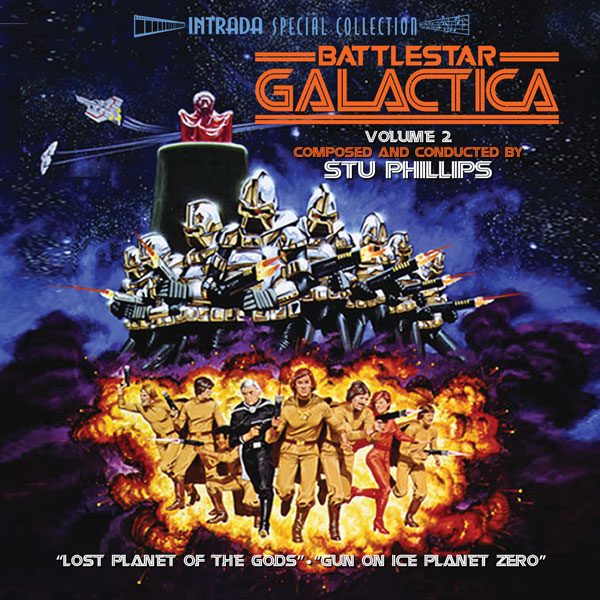
Battlestar Galactica Volume 2 – music by Stu Phillips
 When a studio and/or a network launch a new, heavily-hyped show, you almost expect the music for the pilot episode to kick butt – as with every other aspect of the new show, money is lavished on everything in the hopes that the audience will stick around for later episodes, which will inevitably go through some lean times with tighter budgets. One show that was notorious for never quite getting around to the “tighter budget” part was the notoriously expensive – and popular – original incarnation of Battlestar Galactica. With elaborate space FX sequences constructed in much the same way that similar scenes had been done for Star Wars only a year before Galactica premiered, this was a show that didn’t know the meaning of “coming in under budget.”
When a studio and/or a network launch a new, heavily-hyped show, you almost expect the music for the pilot episode to kick butt – as with every other aspect of the new show, money is lavished on everything in the hopes that the audience will stick around for later episodes, which will inevitably go through some lean times with tighter budgets. One show that was notorious for never quite getting around to the “tighter budget” part was the notoriously expensive – and popular – original incarnation of Battlestar Galactica. With elaborate space FX sequences constructed in much the same way that similar scenes had been done for Star Wars only a year before Galactica premiered, this was a show that didn’t know the meaning of “coming in under budget.”
Money was also lavished on Galactica’s lush orchestral music, and Stu Phillips clearly had fun with the wide-open canvas at his disposal. This 2-CD set, following on from Intrada’s release of the complete score from the Galactica pilot earlier this year, includes the complete score for the series’ earliest two-part extravaganzas. Portions of the music here have been included on the very-limited-run Battlestar Galactica: Stu Phillips Anthology 4-CD collection released by the now-defunct Supertracks label, but Intrada wasted no time in pointing out that this is the first time the complete scores from both of these two-parters has been released. (Truthfully, even if the scores weren’t complete, the rarity and insane secondary market prices on the Anthology set would still make this set a more attractive deal.)
Another plus is the premiere of the Galactica main titles as heard in the early weekly series episodes: following the bold main title with which everyone’s familiar through countless releases and re-recordings (and, in certain places in the new Galactica series, re-interpretations), the early episodes immediately launched into a secondary fanfare accompanying brief glimpses of that week’s guest stars. The fanfare, which wasn’t shy about proclaiming (sometimes quite rightly) that these big-name guests were a Big Deal, then slid down a few keys for a refrain of the Galactica theme, over which we’d see the credits for the writers, producers and director – and then things would come to a full stop for the beginning of the story. This piece of unapologetically bold music hasn’t been released before, and I’d forgotten how much I liked it. It’s kind of like old-school studio-system Hollywood breathing its last, and doing so loud.
Both discs feature quite a bit of musical material in common with the pilot, but each episode has its own unique themes. Lost Planet Of The Gods gets some fine mysterioso music (“The List / Critical / Phony Battle”) as well as a grand choral theme for Kobol (befitting the impressive second-unit scenes filmed in long-shot with extras costumed as Adama, Apollo and Serina, shot on location in Egypt). The choral music may seem a bit cheesy when held up to today’s sensibilities, but again there’s an old-school Hollywood aesthetic to it: this used to be the sound of epic. And it’s really not bad.
The music for The Gun On Ice Planet Zero finds its niche by exploring variations of the show’s recurring themes. Though established in the pilot, some of the themes go through some interesting permutations, including a low string version of the Cylon Basestar motif (normally blared by low brass), accompanying the Cylons’ plotting to destroy Galactica. If you’re a fan of the show’s major themes, this one’s a treat.
 Where many series scale down their expectations after the pilot, in one respect classic Galactica does follow suit: Intrada lowered this limited edition to a run of 1,500 copies (down from 3,000 copies of volume one), but this may have been a miscalculation on the label’s part. The score for the pilot, whether complete or not, has been issued in many permutations over the years (the original LP, the German CD of that LP, a from-the-ground-up re-recording on Varese for the show’s 25th anniversary, the Stu Phillips Anthology). The music from subsequent episodes is much harder to come by (the Anthology was the only game in town prior to these Intrada releases), so there’s an argument that they probably could’ve sold 3,000 copies of this. The speed with which this volume has already sold out may change the quantities of future volumes. It’s nice to finally see this show’s lush music getting as much attention as the music for its latter-day remake.
Where many series scale down their expectations after the pilot, in one respect classic Galactica does follow suit: Intrada lowered this limited edition to a run of 1,500 copies (down from 3,000 copies of volume one), but this may have been a miscalculation on the label’s part. The score for the pilot, whether complete or not, has been issued in many permutations over the years (the original LP, the German CD of that LP, a from-the-ground-up re-recording on Varese for the show’s 25th anniversary, the Stu Phillips Anthology). The music from subsequent episodes is much harder to come by (the Anthology was the only game in town prior to these Intrada releases), so there’s an argument that they probably could’ve sold 3,000 copies of this. The speed with which this volume has already sold out may change the quantities of future volumes. It’s nice to finally see this show’s lush music getting as much attention as the music for its latter-day remake.
Disc 1: The Lost Planet Of The Gods
- Main Title – Parts 1 & 2 (1:48)
- Imperious Leader & Baltar (1:28)
- Athena Vamps/Patrol Two Launch (1:36)
- Baltar – The Leader (2:04)
- The Abyss Part 1 (1:31)
- The Abyss Part 2 / Escape From The Void (2:56)
- Cylon Outpost (2:12)
- Virus 1A / Virus 1B / Virus 2 / Virus 3 (2:14)
- Virus 4 / Adama’s Medal / Top Of The Class / Ancient Writings (2:54)
- The List / Critical / Phony Battle (2:30)
- Captain’s Opinion / Launch When Ready (0:56)
- More Cylon Lair (1:53)
- Good Guys 1, Bad Guys Zero (4:25)
- We’re Going In (1:53)
- The Medallion / Starbuck In Trouble (1:43)
- Marry Me (1:05)
- The Wedding / Starbuck Captured (3:36)
- Ancient Ruins (1:28)
- Discovery Of The Tomb (2:44)
- Baltar Appears (1:24)
- Love & The Sphinx (0:43)
- To Light The Way / Blue Squad Reporting (4:28)
- Not The Last Of Baltar / Serina Dies / Boxey & Apollo (5:25)
- End Credits (0:30)
Disc 2: The Gun On Ice Planet Zero
- Main Title (1:48)
- Environment: Hostile (1:41)
- March Of The Centurions (2:32)
- Four Specialists (1:11)
- Cree Captured (1:05)
- Launch Bay Alpha (1:19)
- Blizzard (2:07)
- Death Point (3:15)
- Cold Journey (3:32)
- Bad Situation (1:37)
- Ravashol (3:35)
- Rough Ride (1:21)
- Icy Planet Lab (1:38)
- Cree To The Cold Cell (0:44)
- Cold Planet (1:58)
- Fire The Pulsar (2:58)
- Getting Closer (8:03)
- Pulsar Destroyed (1:53)
- Starbuck Loses (1:41)
- End Credits (0:30)
Released by: Intrada
Release date: 2011
Disc one total running time: 53:49
Disc two total running time: 43:41
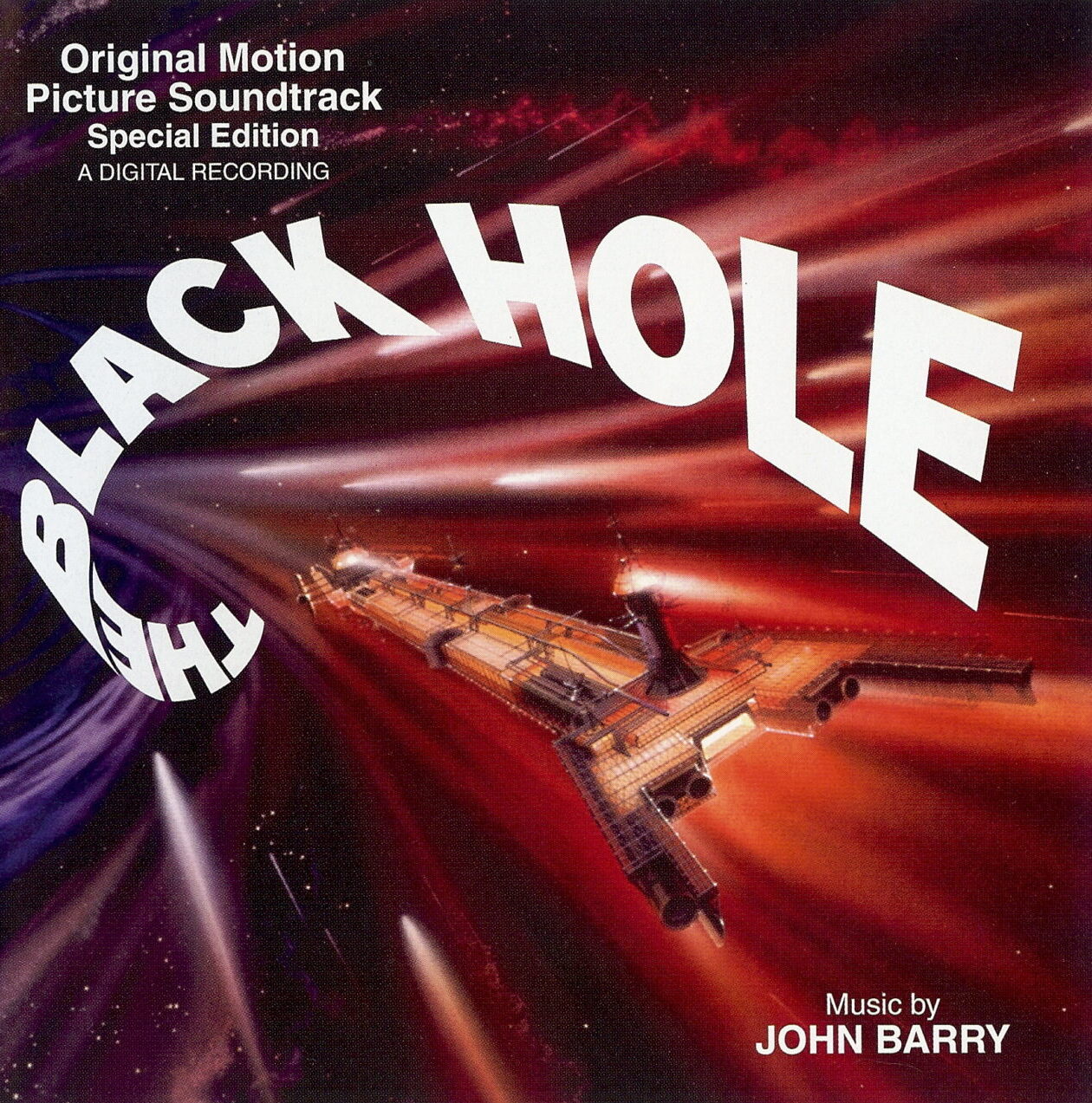
The Black Hole – music by John Barry
Many, many years ago in theLogBook.com’s Music Reviews, I reviewed the original vinyl release of John Barry’s near-legendary soundtrack from Disney’s The Black Hole, mainly because it had never hit compact disc (unless one counted bootlegs). It took over 30 years, but The Black Hole is finally on CD, now expanded to include every note of Barry’s mesmerizingly fatalistic score, and it’s time to revisit an old favorite.
The long-dormant Disneyland Records label was resurrected in 2011 by soundtrack specialty label Intrada, with its first release being the first-ever CD of Michael Giacchino’s music from Up, complete with nifty retro artwork hearkening back to the Disneyland read-along records of the 1960s and ’70s. The moment Intrada announced a soundtrack partnership with Disney, issuing both new and classic soundtracks from the Disney vaults, fans everywhere caught their breath, for surely Intrada had a pretty good idea of what classic Disney soundtrack everyone had been demanding for decades. But statements made by the producer of an iTunes release of the original LP indicated that anything more than a re-release of the LP was unlikely: despite being the first-ever all-digital soundtrack recording, The Black Hole‘s music had been recorded in a digital format which could basically only be played back on the machine that recorded it – a machine long since taken out of service in the music business. Even if the original session tapes existed, they simply couldn’t be played back without that machine.
Of course Intrada knew of the demand for The Black Hole, and the producer of the somewhat disappointing iTunes version of the soundtrack was on a mission from God to find and release the whole score. What followed was a quest to track down the original recording equipment, simply so the original tapes could be played back from it to be transferred to more modern media. Needless to say, soundtrack fans have a new hero, and his name is Randy Thornton. Intrada deserves a huge amount of credit too: unlike most boutique soundtrack label releases, The Black Hole is not limited to a couple thousand copies. Like Film Score Monthly’s re-releases of the out of print soundtracks from Star Trek II and III, The Black Hole won’t be going out of print anytime soon – and this ensures that this previously impossible-to-find title won’t wind up making more money on the secondary market (i.e. eBay) than it made for the label who released in the first place. Smart move. If it had been limited to the usual run of 3,000 copies, this one would’ve sold out within fifteen minutes of online pre-orders.
And the music itself? It’s crystal clear – the fact that the source material could be tracked down and remastered is a testament to the sheer fannish dedication that went into the project. Even though there are ten tracks who share their titles with the individual pieces on the vinyl LP, they’re not necessarily the same: rather than edits compiled for the LP, these are the original cues as used in the movie.
Released within days of Star Trek: The Motion Picture, The Black Hole also makes generous use of the creepy Blaster Beam instrument that most listeners associate with the former, and while Barry doesn’t use it as prominently as Jerry Goldsmith did, the distinct sound lurks menacingly in the background of many of the cues.
If anyone needs justification for an expanded version of this soundtrack, go straight to the cue “Hot and Heavy”, which was an incredibly prominent theme from the movie that went completely missing on the original soundtrack LP. A dandy little number with piano and pizzicato strings creating an echoing effect, it’s the major suspense theme of the movie and possibly its most distinctive piece of music. The motif returns, appropriately enough, in “Hotter and Heavier” – go figure. Another previously unreleased track worthy of attention is the brief track “BOB and VINCENT,” depicting the farewell between the movie’s two robot protagonists. For a scene between two props, it packs quite an emotional punch in a short space of time – so much so that Barry later reused and revised it in his score for the Oscar-winning Out Of  Africa, where nobody would’ve guessed it originally involved cute floating robots.
Africa, where nobody would’ve guessed it originally involved cute floating robots.
The Black Hole‘s music is much like that of the aforementioned Star Trek movie – in the end, the perception will probably always be that the music was better than the movie all along. In that context, this soundtrack is long, long overdue and worth a listen.
- Overture (2:28)
- Main Title (1:49)
- That’s It (1:43)
- Closer Look (2:02)
- Zero Gravity (5:48)
- Cygnus Floating (2:06)
- The Door Opens (4:09)
- Pretty Busy (:48)
- Six Robots (1:57)
- Can You Speak? (1:19)
- Poor Creatures (1:41)
- Ready to Embark (:44)
- Start the Countdown (3:47)
- Durant Is Dead (2:31)
- Laser (1:01)
- Kate’s OK (2:49)
- Hot and Heavy (2:43)
- Meteorites (1:31)
- Raging Inferno (:54)
- Hotter and Heavier (1:59)
- BOB and VINCENT
- (:54)
- Into the Hole (4:56)
- End Title (2:34)
- In, Through… And Beyond! (2:46)
Released by: Intrada
Release date: 2011
Total running time: 55:05
Rise Of The Planet Of The Apes – music by Patrick Doyle
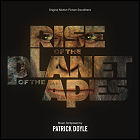 The Planet Of The Apes franchise has never been safe or predictable, and the same goes for its music. With a musical lexicon established by an unconventional score that has to count as one of Jerry Goldsmith‘s career highlights, the Apes franchise demands that later composers bring their A-game. Even the 21st century’s first attempt at reviving the franchise – though it was a non-starter that sits well outside of the accepted continuity – was scored by none other than Danny Elfman. The single season of live-action TV Apes drew heavily on a pilot score by Lalo Schifrin that acknowledged Goldsmith’s adventurous music, even if it couldn’t approach it on a TV soundtrack budget. The upshot of this is: you can’t go tame composing for Apes.
The Planet Of The Apes franchise has never been safe or predictable, and the same goes for its music. With a musical lexicon established by an unconventional score that has to count as one of Jerry Goldsmith‘s career highlights, the Apes franchise demands that later composers bring their A-game. Even the 21st century’s first attempt at reviving the franchise – though it was a non-starter that sits well outside of the accepted continuity – was scored by none other than Danny Elfman. The single season of live-action TV Apes drew heavily on a pilot score by Lalo Schifrin that acknowledged Goldsmith’s adventurous music, even if it couldn’t approach it on a TV soundtrack budget. The upshot of this is: you can’t go tame composing for Apes.
Patrick Doyle‘s score, however, does precisely that for a lot of its running time. Don’t get me wrong – fans of the Hans Zimmer-inspired school of “action music with lots of fast-moving cello ostinatos” will feel right at home here, but even Zimmer could be more adventurous than this (see also: Batman Begins, The Dark Knight, Inception). The music is pleasant enough, and Doyle proves that he’s got the chops for a “primitive” sound, but it’s well into the movie or the soundtrack before that’s apparent. Even when the primate action gets hot and heavy, rather than playing up the exotic, the score falls back on a wall of strings. The groundwork for the end of humanity is being laid in the story, but we still get a rather gentrified, string-heavy sound – more than once, I found myself wondering what Bear McCreary would’ve done with this movie.
When Doyle does do brutal/primitive, it’s a breath of fresh air, but it seems as though he falls back on the string section as quickly as possible. The music isn’t bad, just… awfully conventional.
 I wasn’t expecting, or hoping, to hear full-scale quotation of the original Goldsmith score or any of its successors, but a little stylistic callback to the original might not have hurt. Rise Of The Planet Of The Apes is a different kind of approach to the Apes franchise, and it definitely gets a musical treatment that’s different from most of what has come before. Is it more contemporary? Yes – but it’s also strangely more generic, the last sound I’d expect from a new movie in this series.
I wasn’t expecting, or hoping, to hear full-scale quotation of the original Goldsmith score or any of its successors, but a little stylistic callback to the original might not have hurt. Rise Of The Planet Of The Apes is a different kind of approach to the Apes franchise, and it definitely gets a musical treatment that’s different from most of what has come before. Is it more contemporary? Yes – but it’s also strangely more generic, the last sound I’d expect from a new movie in this series.
- The Beginning (2:48)
- Bright Eyes Escapes (3:37)
- Lofty Swing (1:36)
- Stealing The 112 (1:51)
- Muir Woods (1:20)
- Off You Go (2:17)
- Who Am I? (2:20)
- Caesar Protects Charles (3:57)
- The Primate Facility (2:44)
- Dodge Hoses Caesar (1:39)
- Rocket Attacks Caesar (1:24)
- Visiting Time (2:16)
- “Caesing” The Knife (2:04)
- Buck Is Released (1:51)
- Charles Slips Away (1:16)
- Cookies (1:15)
- Inhaling The Virus (2:45)
- Caesar’s Stand (4:23)
- Sys Freedom (4:56)
- Zoo Breakout (2:40)
- Golden Gate Bridge (5:21)
- The Apes Attack (2:09)
- Caesar And Buck (1:57)
- Caesar’s Home (2:40)
Released by: Varese Sarabande
Release date: 2011
Total running time: 61:06
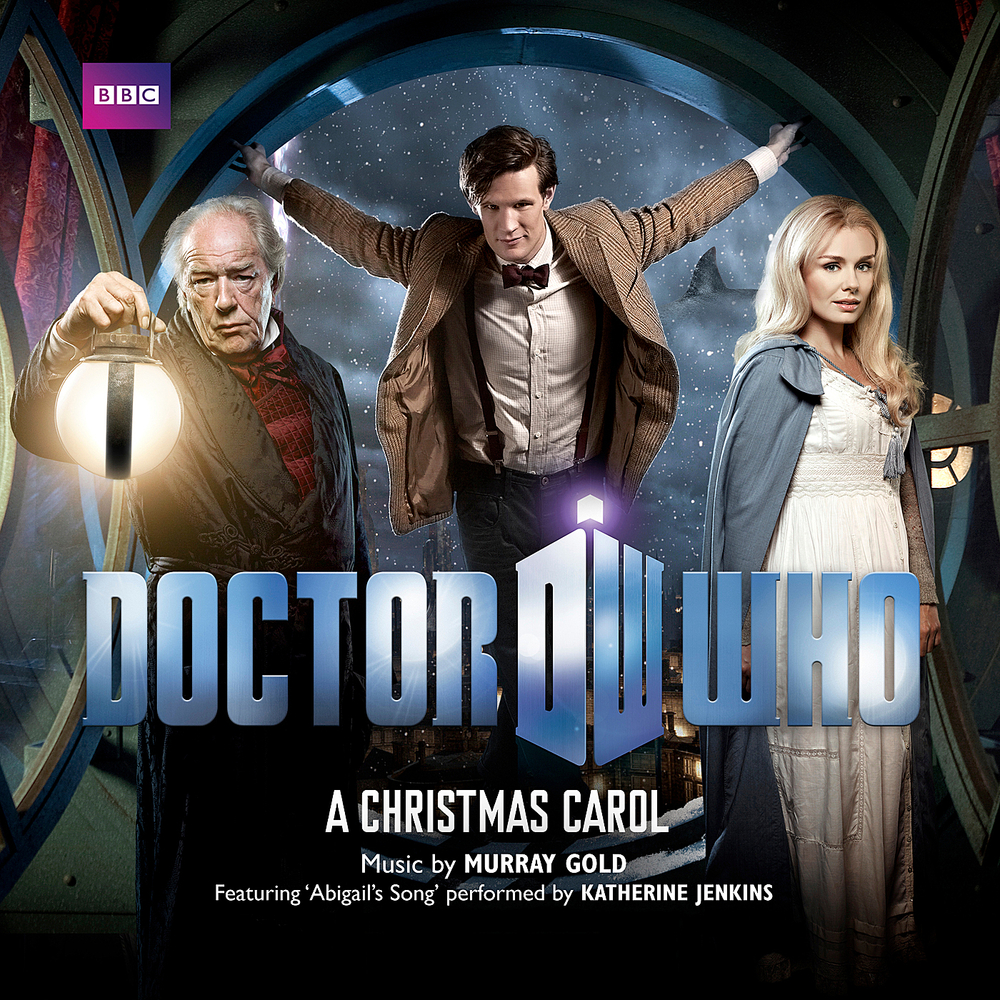
Doctor Who: A Christmas Carol – music by Murray Gold
 If the soundtrack from the fifth season of the revived Doctor Who was a marvelous change of pace for composer Murray Gold, the stand-alone soundtrack release for A Christmas Carol, the 2010 Christmas special, is a homecoming. A Christmas Carol returns to the big, unapologetically brassy sound that Gold used for much of the Russell T. Davies era of Doctor Who. About the only thing that’s missing is an orchestral action piece set to a rock drum beat.
If the soundtrack from the fifth season of the revived Doctor Who was a marvelous change of pace for composer Murray Gold, the stand-alone soundtrack release for A Christmas Carol, the 2010 Christmas special, is a homecoming. A Christmas Carol returns to the big, unapologetically brassy sound that Gold used for much of the Russell T. Davies era of Doctor Who. About the only thing that’s missing is an orchestral action piece set to a rock drum beat.
That’s not to say that this special’s music wasn’t just as firmly entrenched in the more subdued musical sensibility of the Steven Moffat era, however. After “Come Along Pond,” the all-out action intro for the show’s Star-Trek-spoofing opening teaser, many of the early tracks take on the dark tone of the Doctor’s latest destination. Once the Doctor travels back in time to Kazran Sardick’s childhood, the story’s essentially dealing with a child who’s been neglected at best and abused at worst – not really the kind of material for jubilant tunes. Once we get into scenes such as the Doctor inadvertently feeding his sonic screwdriver to a flying shark, however, Gold is off to the races in his old style.
The sharks (flying or otherwise) would be circling if the album didn’t also include the mesmerizing “Abigail’s Song (Silence Is All You Know)”, whose title – as of the middle of the 2011 season – sticks out like a sore thumb trying to disguise itself as a subtle hint. Unlike some of the songs that have accompanied past Christmas specials, this one is indeed sung by Katherine Jenkins, who played Abigail on screen, and whose operatic pedigree means she certainly doesn’t need to be dubbed. The melody of the song, however, begins creeping into the score long before the song’s appearance late in the episode.
 As always, Gold coaxes an awesome wall of sound out of the BBC National Orchestra of Wales, whose presence has occasionally become a bit sparse as the BBC becomes more budget-conscious across the board. Fully orchestral passages have become a kind of special flavoring during the regular season, and an ear-popping stocking stuffer at Christmas. I wasn’t crazy about the plot of A Christmas Carol, but the music is one of the better things about the show, and is well worth a listen.
As always, Gold coaxes an awesome wall of sound out of the BBC National Orchestra of Wales, whose presence has occasionally become a bit sparse as the BBC becomes more budget-conscious across the board. Fully orchestral passages have become a kind of special flavoring during the regular season, and an ear-popping stocking stuffer at Christmas. I wasn’t crazy about the plot of A Christmas Carol, but the music is one of the better things about the show, and is well worth a listen.
- Come Along Pond (1:51)
- Halfway Out Of The Dark (1:38)
- Pray For A Miracle (0:37)
- Geoff (3:48)
- You Didn’t Hit The Boy (1:44)
- Fish (0:50)
- Kazran Sardick 12 1/2 (1:29)
- Ghost Of Christmas Past (1:33)
- Babysitter (0:47)
- Talk About Girls (1:41)
- Sonic Fishing (1:43)
- Just A Little One (1:16)
- Big Colour (1:50)
- I Can’t Save Her (3:34)
- The Other Half’s Inside The Shark (1:08)
- Abigail (1:47)
- He Comes Every Christmas (1:09)
- Shark Ride (1:24)
- New Memories (1:00)
- Holding Hands (1:45)
- Christmas Dinner (0:38)
- Goodlucknight (1:51)
- Goodnight Abigail (2:10)
- This Planet Is Ours (2:00)
- Ghost Of Christmas Present (0:48)
- The Course Of My Life (1:35)
- Ghost Of Christmas Future (1:50)
- Abigail’s Song (Silence Is All You Know) (4:41)
performed by Katherine Jenkins- Everything Has To End Some Time (1:14)
Released by: Silva Screen
Release date: 2011
Total running time: 49:21
Escape From The Planet Of The Apes – music by Jerry Goldsmith
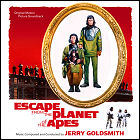 Jerry Goldsmith was among those who didn’t return for the second installment of the Planet Of The Apes film series, but he was back on board for the third, which was an attempt to reboot the series without ditching the established continuity. If anything, the third film was the most clever of the sequels, drop-kicking the story back into the present day (or something like it) for an Apes-style meditation on the spectrum of prejudice (from sublte to savage) and the fleeting and entirely disposable nature of celebrity, two topics which have helped Escape From The Planet Of The Apes retain its ironic bite over the years rather than allowing it to become increasingly dated (as with the other sequels).
Jerry Goldsmith was among those who didn’t return for the second installment of the Planet Of The Apes film series, but he was back on board for the third, which was an attempt to reboot the series without ditching the established continuity. If anything, the third film was the most clever of the sequels, drop-kicking the story back into the present day (or something like it) for an Apes-style meditation on the spectrum of prejudice (from sublte to savage) and the fleeting and entirely disposable nature of celebrity, two topics which have helped Escape From The Planet Of The Apes retain its ironic bite over the years rather than allowing it to become increasingly dated (as with the other sequels).
Goldsmith, keenly aware of what the movie needed (as always), came out swingin’. No, not swinging, but swingin’ – as in groovy, baby! His opening theme for Escape is one of my favorite pieces that Goldsmith has ever written, period. It sounds nothing like the opening to a science fiction movie. It sounds like the opening to a ’70s comedy, which is what the movie’s admittedly funny opening scene is trying to trick you into expecting. With its jazzy beat and straight-outta-the-late-sixties electric organs, guitar and sitar, Goldsmith’s opening number completely belies the story that’s about to unfold. And I love it. The whole movie is about appearances deceiving, and Goldsmith was clearly in on the joke.
The swingin’ mood carries into the next track, “The Zoo”, which is a bit more mellow – almost into Barry White backing-track territory, again completely unexpected for Goldsmith. It’s at the beginning of this track, however, that the composer begins to slip in some of the unorthodox, almost animalistic instrumentation from the Planet Of The Apes score, but subtly – you can be forgiven for not noticing (especially while watching with the movie’s dialogue and sound effects).
“Gorilla Attack” is a burst of brutality that seems out of the place with the movie’s decided gentle first reel, but it’s a preview of things to come. Goldsmith resumes the grooviness with the “Shopping Spree” montage, but things quickly become more unsettled as the movie’s plot becomes darker and more serious to a shocking degree. As suspicion mounts that the two talking apea – now revealed to be expecting parents – may well signal the end of the line for homo sapiens, the music becomes darker by several orders of magnitude. Tracks such as “Labor Pains” and “Mother And Child” distract a bit by sounding like the score from a more domestic drama, but the sheer brutality of immediately adjacent tracks like “The Breakout” and “The Hunt” leave little doubt that the story is still about the impending extinction of the apes as we know them at this point in the saga. “Final Chapter and End Credits” brings it all home, no longer the gimmicky laugh at the beginning of the movie, but closing off a tragically brutal story. The latter half of that track revisits the basic melody of Goldsmith’s jaunty opening, but in a much more somber treatment.
I can caution you that there’s barely a half-hour of music here (and on one of those pricey, limited-edition releases, no less), but this is a Goldsmith masterpiece – possibly even moreso than Planet Of The Apes itself. Escape From The Planet Of The Apes was all about getting the audience in their seats with some popcorn for some kooky, zany fish-out-of-water comedy, only to  serve up a slice of blistering social commentary that, frankly, audiences probably needed in 1971. (I’d put this movie, completely unchanged in front of an audience now, too: the 1971 timestamp would probably put them even more at ease and make it even more shocking.) Goldsmith’s music was part of the process of tricking the audience into letting its guard down, and it’s downright hummable too – a great combination.
serve up a slice of blistering social commentary that, frankly, audiences probably needed in 1971. (I’d put this movie, completely unchanged in front of an audience now, too: the 1971 timestamp would probably put them even more at ease and make it even more shocking.) Goldsmith’s music was part of the process of tricking the audience into letting its guard down, and it’s downright hummable too – a great combination.
- Main Title (2:32)
- The Zoo (1:06)
- The Gorilla Attack (0:56)
- I Like You (1:05)
- Shopping Spree (2:19)
- A Little History (1:23)
- Interrogation (3:18)
- Labor Pains (1:05)
- Breakout (0:38)
- The Labor Continues (3:55)
- The Hitchhiker (1:06)
- Mother And Child (3:52)
- The Hunt (4:06)
- Final Chapter and End Credits (1:42)
Released by: Varese Sarabande
Release date: 2009
Total running time: 29:03
Planet Of The Apes – music by Jerry Goldsmith
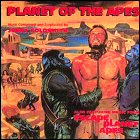 So much has been written down through the years about the influential career milestone that was Jerry Goldsmith‘s score for Planet Of The Apes that I’ve resisted reviewing it for a long time. It’s well known that it’s an unsettling, unconventional listening experience, with or without the movie. What is there to add to that?
So much has been written down through the years about the influential career milestone that was Jerry Goldsmith‘s score for Planet Of The Apes that I’ve resisted reviewing it for a long time. It’s well known that it’s an unsettling, unconventional listening experience, with or without the movie. What is there to add to that?
The funny thing, however, is in giving it a fresh listen and finding that a lot of it is actually in a familiar orchestral vein. In some ways, it’s the exact opposite of Goldsmith’s later score to 1976‘s Logan’s Run, which starts out synthetic and becomes lushly orchestral only when the characters leave their artificially constructed, computer-regulated environment. Planet Of The Apes starts out aboard a futuristic spacecraft, familiar ground for many a science fiction flick, but then both the movie and the music ditch those familiar trappings for a desperate, primitive quest for survival.
Frequently, this is accomplished with a wall of percussion that, up until this point, viewers and listeners just didn’t expect to hear next to an orchestra. But it really isn’t until “The Search Continues” that Goldsmith pushes the music into a space where it’s barely recognizable to our ears as music. Using some novel instrumental effects, he creates the disconcerting audio equivalent of chittering apes. “The Hunt” uses the call of a primitive horn to raise the tension as Taylor (Charlton Heston) tries to lead a colony of humans to freedom.
Goldsmith eschews some obvious avenues for more traditional scoring at other points too – the short cue “A New Mate” is anything but sexy; instead it’s uneasy, as the apes prod him and a primitive human woman together. “The Revelation” plays up Taylor’s horror at discovering what’s happened to his surviving shipmate.
“The Trial” again uses existing instrumentation in unconventional ways to play out the parody of the Scopes monkey trial in which Taylor is railroaded and fast-tracked for execution simply because of what he represents. After that, the score is surprisingly low-key, seeming to rumble toward what seems like either an inevitable grim fate or a daring escape… only to culminate, like the movie, in both at the same time.
Rounding things off is a 16-minute suite of music from Goldsmith’s only follow-up in the Apes film series, Escape From The Planet Of The Apes, which presents a nice “highlight reel” of that movie’s music, which was all the more surprising for not following in the footsteps of what Goldsmith created for the first movie. (Varese would later release the entire Escape score on its own as a limited edition in 2009.)
Jerry Goldsmith did accomplish some amazing sounds with Planet Of The Apes, but perhaps even more significantly, he laid the groundwork for the use of unconventional percussion in film scoring to signify the otherworldly and the uninviting.  The percussion lexicon he all but created here led to such things as the Sand People music in Star Wars, Bear McCreary‘s wall of eastern percussion throughout the TV remake of Battlestar Galactica, and many, many others. The shadow cast by the music of Planet Of The Apes looms large over many familiar future scores in the same genre. Jerry Goldsmith just happened to get there first.
The percussion lexicon he all but created here led to such things as the Sand People music in Star Wars, Bear McCreary‘s wall of eastern percussion throughout the TV remake of Battlestar Galactica, and many, many others. The shadow cast by the music of Planet Of The Apes looms large over many familiar future scores in the same genre. Jerry Goldsmith just happened to get there first.
- 20th Century Fox Fanfare (0:15)
- Main Title (2:12)
- Crash Landing (6:39)
- The Searchers (2:26)
- The Search Continues (4:57)
- The Clothes Snatchers (3:09)
- The Hunt (5:10)
- A New Mate (1:05)
- The Revelation (3:22)
- No Escape (5:40)
- The Trial (1:45)
- New Identity (2:26)
- A Bid For Freedom (2:38)
- The Forbidden Zone (3:23)
- The Intruders (1:10)
- The Cave (1:20)
- The Revelation (Part II) (3:25)
- Suite: Escape From The Planet Of The Apes (16:27)
Released by: Varese Sarabande / 20th Century Fox Film Scores
Release date: 1997
Total running time: 67:29
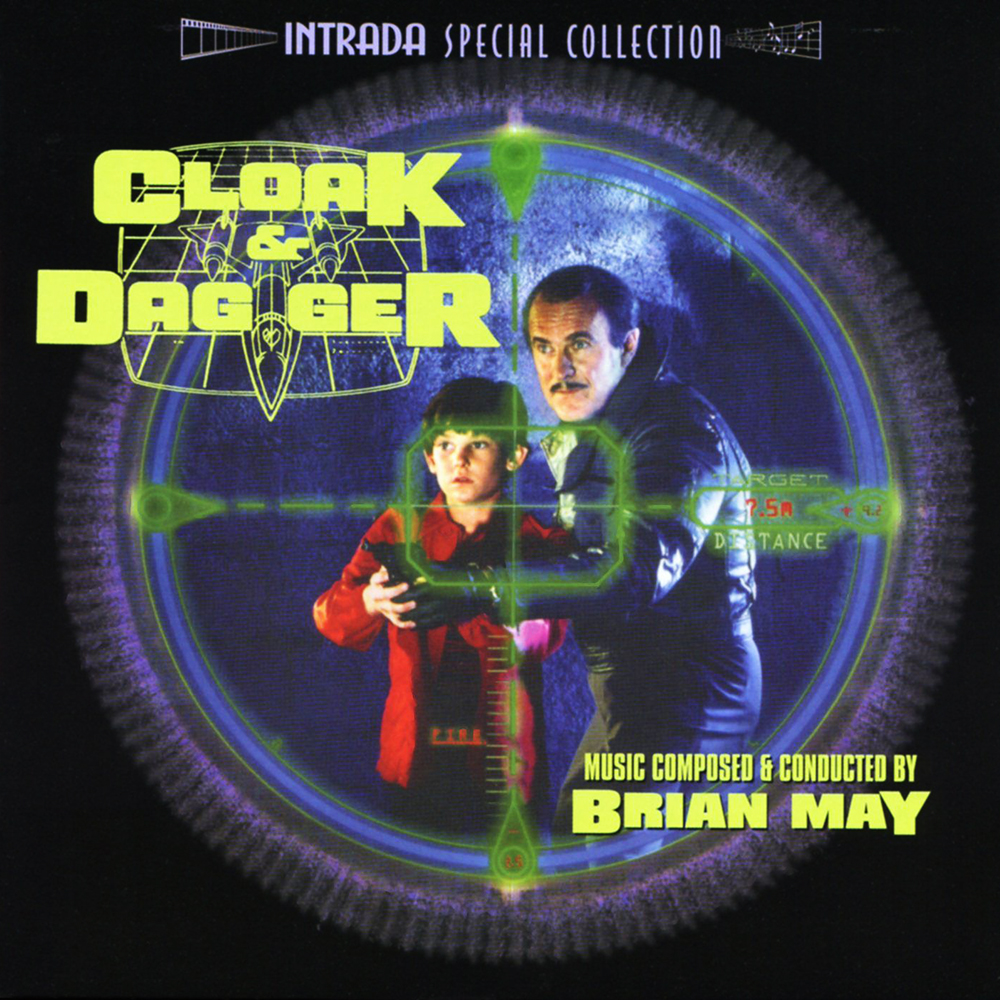
Cloak & Dagger – music by Brian May
The early ’80s saw a spate of video-game-oriented films, trying to cash in on the public’s seemingly unstoppable infatuation with that new entertainment medium. Cloak & Dagger, starring Henry Thomas (still a fixture in the public eye thanks to his then-recent appearance in E.T.) and Dabney Coleman (the king of early ’80s video game / computer flicks, having already appeared in WarGames, was easily the most kid-oriented of the first wave of video game movies.
For some reason, my memory had cheated a little bit in recalling this movie’s music. I hadn’t actually seen Cloak & Dagger since just a few years after its release, and for some reason I had it in my head that the soundtrack was somewhat similar to the music from WarGames, which was constantly on-edge and, thanks to some synth work, hip to the audience’s expectations from a movie featuring computers as a key plot point. In fact, Cloak & Dagger – getting its first soundtrack release thanks to Intrada – is nothing like that. For a supposedly tech-oriented movie, it’s startling just how old-school the soundtrack is.
Scored by the late Australian composer Brian May (not Queen’s lead guitarist, who’s still alive and dividing his time between astronomy and being the world’s best axe man), Cloak & Dagger‘s old-fashioned, strictly-orchestral scoring is almost out of place: it skews a lot older than the rest of the movie. Even the way the music was arranged, and the way the recording sessions were miked and mixed, makes the music sound older than the 1980s – in a strange way, it sounds like a recording from the ’60s or early ’70s, and not like the music from a kiddie techno-thriller at all. It’s nice music, but just seems strangely unhip next to the images it accompanies.
The action sequences fare better than the more contemplative moments. Coleman’s swaggering hero Jack Flack gets a nice signature theme, which gets turned around into a nice reveal toward the end of the movie when Thomas’ character realizes that it’s not military superhero/action figure Jack Flack, but his father (also played by Coleman), who has come to his rescue.
Cloak & Dagger could probably have done with a punchier, “younger” soundtrack, and it’s a great example of how misremembered a piece of movie history can be. As always, Intrada packs the accompanying CD booklet with a wealth of information about the movie (including something I’d missed: the plot of Cloak & Dagger is so close to Hitchcock’s Rear Window that the writer of the short story upon which Rear Window was based actually gets a story credit for Cloak &  Dagger). Aside from a mostly-forgotten arcade game by Atari (whose attempt at a movie product placement for an upcoming Atari 5200 Cloak & Dagger game – represented here by footage of the arcade game – turned out to be a product placement for vaporware), this may be the only other merchandise Cloak & Dagger has ever inspired. It’s a decent soundtrack… for the wrong movie.
Dagger). Aside from a mostly-forgotten arcade game by Atari (whose attempt at a movie product placement for an upcoming Atari 5200 Cloak & Dagger game – represented here by footage of the arcade game – turned out to be a product placement for vaporware), this may be the only other merchandise Cloak & Dagger has ever inspired. It’s a decent soundtrack… for the wrong movie.
- Jack Flack Arrives (0:59)
- The Tower Of Life (3:33)
- Help, Police!… Murder (4:13)
- Return From The Mission (5:32)
- I Guess We’re On Our Own (1:38)
- Davey Gets Away (1:20)
- Run, Davey, Run (3:34)
- Nightmare Drive (5:05)
- Parking Lot Chase (3:56)
- We Gotta Save Kim! (1:06)
- Back To The River (2:01)
- Run Like The Wind (1:55)
- The Cross Fire Gambit (4:42)
- I Don’t Wanna Play (1:10)
- The End Of Childhood (2:21)
- Airport Prelude (1:28)
- Davey A Hostage! (1:22)
- Captain Jack Flack (6:49)
- Cloak & Dagger (End Credits) (3:49)
Released by: Intrada
Release date: 2010
Total running time: 57:13
SpaceCamp – music by John Williams
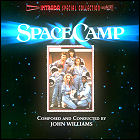 SpaceCamp is one of those movies that had a serious handicap going into the theater. And its handicap wasn’t even the inherent (but earnest) goofiness of its plotline – a bunch of kids attending the U.S. Space Camp actually winding up in space because of a shuttle malfunction caused by a robot befriended by one of the “crew” – but by the worst kind of bad timing imaginable. There was no way that the makers of SpaceCamp could’ve known that somewhere between wrapping final photography and getting the movie into theaters, the space shuttle Challenger and her crew would die a fiery death in front of millions. Furthermore, some of the actual space shuttle footage filmed for the movie included Challenger’s previous mission. The release date was continually bumped further and further into 1986, until the film was finally unleashed on a public that had been treated to endless replays of Challenger exploding for the better part of a year.
SpaceCamp is one of those movies that had a serious handicap going into the theater. And its handicap wasn’t even the inherent (but earnest) goofiness of its plotline – a bunch of kids attending the U.S. Space Camp actually winding up in space because of a shuttle malfunction caused by a robot befriended by one of the “crew” – but by the worst kind of bad timing imaginable. There was no way that the makers of SpaceCamp could’ve known that somewhere between wrapping final photography and getting the movie into theaters, the space shuttle Challenger and her crew would die a fiery death in front of millions. Furthermore, some of the actual space shuttle footage filmed for the movie included Challenger’s previous mission. The release date was continually bumped further and further into 1986, until the film was finally unleashed on a public that had been treated to endless replays of Challenger exploding for the better part of a year.
It shocked absolutely no one that the movie didn’t do very well, but film music fans were mesmerized by John Williams‘ latest score. In the years following the end of the original Star Wars trilogy (and the years between Indiana Jones’ second and third cinematic adventures), Williams seemed to be staying out of orbit and being more choosy with his assignments. For fans of Williams’ classic adventure scores, SpaceCamp was a return to form. An LP pressing of the soundtrack from SpaceCamp was in print for what seemed like the blink of an eye, and aside from a Japanese-market-only CD pressing that went for prices that would’ve paid for another space shuttle, that was it.
Intrada’s long-awaited re-release – which, again, sold out in a heartbeat – is essentially a new pressing of the Japanese CD, this time with Intrada’s trademark extensive liner notes booklet (in English, thankfully) detailing the film’s production, its rough theatrical landing, and of course the history of its elusive soundtrack. For those who had never been able to afford a copy before, Intrada’s SpaceCamp soundtrack was a gift from the heavens… at least while it was available.
The music itself is classic Williams, especially once events in the movie move into space. A more contemporary sound is evident in earthbound scenes such as “Training Montage”, but still bearing the heroic touch that Williams was no doubt tapped to add to the film’s sound. There’s even an almost-obligatory nod to the composer’s existing body of work, if a slightly predictable one (the youngest of the film’s stars, scared out of his wits, has to be stirred into action by one of the other kids urging him to “use the Force” over the radio – surely you don’t need to think too hard to imagine what music Williams quotes there).
 As goofy and ill-timed as the film itself was, however, SpaceCamp got the kind of full-blooded adventure movie music that seems to be in short supply these days, as more modern composers lean more heavily toward the exotic. The reason Williams’ fans loved this score is that it brought back the kind of unapologetically straightforward sound he was best known for. Whatever the movie itself failed to achieve, the SpaceCamp soundtrack delivers in spades.
As goofy and ill-timed as the film itself was, however, SpaceCamp got the kind of full-blooded adventure movie music that seems to be in short supply these days, as more modern composers lean more heavily toward the exotic. The reason Williams’ fans loved this score is that it brought back the kind of unapologetically straightforward sound he was best known for. Whatever the movie itself failed to achieve, the SpaceCamp soundtrack delivers in spades.
- Main Title (3:12)
- Training Montage (2:03)
- The Shuttle (5:06)
- The Computer Room (1:58)
- Friends Forever (2:24)
- In Orbit (3:16)
- White Sands (6:56)
- SpaceCamp (4:11)
- Viewing Daedalus (2:48)
- Max Breaks Loose (2:25)
- Andie Is Stranded (4:12)
- Max Finds Courage (2:23)
- Re-Entry (3:59)
- Home Again (3:30)
Released by: Intrada
Release date: 2010
Total running time: 48:23
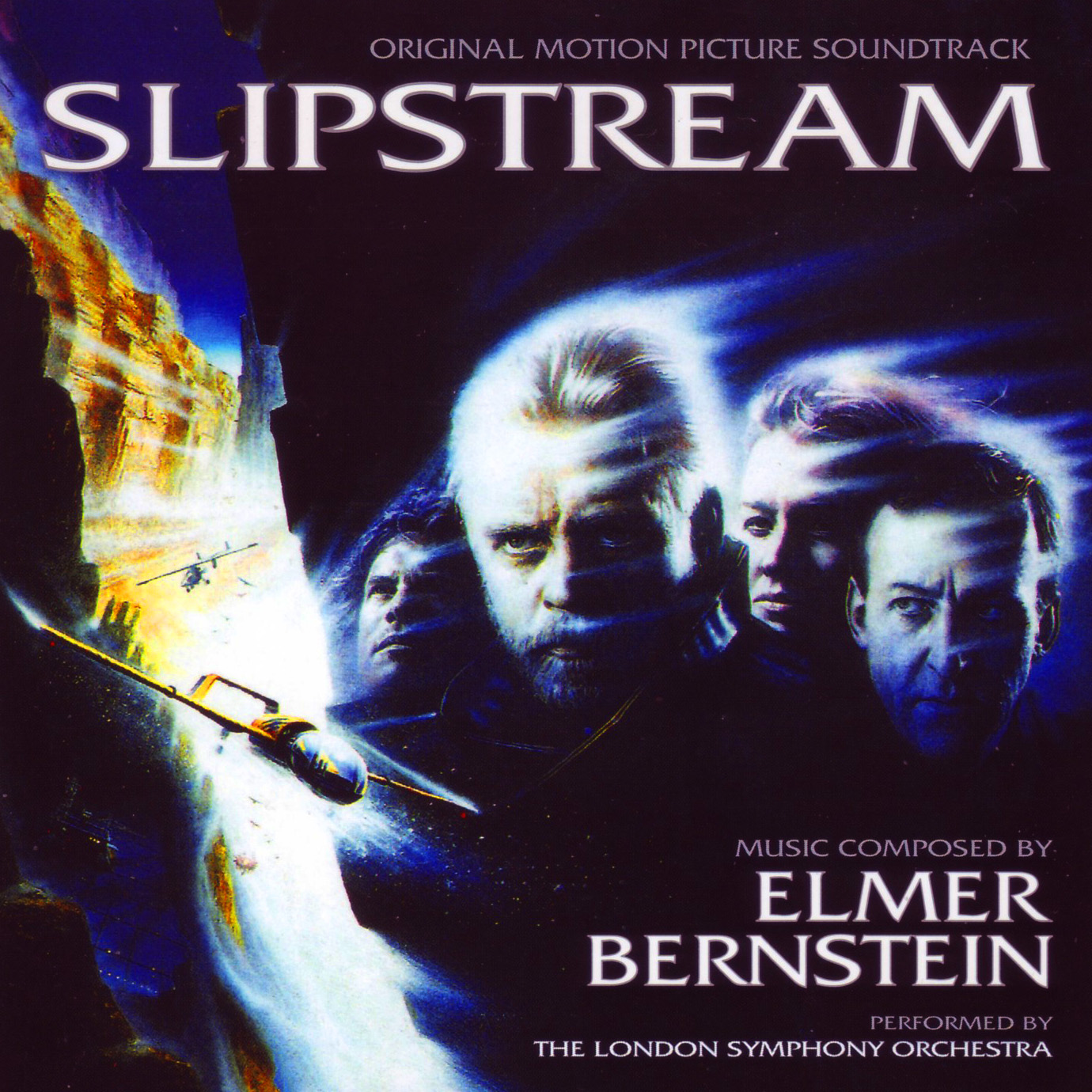
Slipstream – music by Elmer Bernstein
Long coveted by soundtrack collectors, Elmer Bernstein’s Slipstream accompanies a movie that flew under nearly everyone’s radar in 1989. In retrospect, it’s hard to imagine that a movie starring Mark Hamiill and Bill Paxton, and directed by Steven “creator of Tron” Lisberger, could’ve escaped the collective geek consciousness, especially when it’s a post-apocalyptic sci-fi western (more Mad Max than Firefly), but admit it: you don’t remember hearing about this movie either, much less seeing it.
Obviously, however, someone recalls hearing it: the Slipstream soundtrack has been one of the most-requested (and therefore, perversely, elusive) Elmer Bernstein scores from the late composer’s catalog. Bernstein himself had even gone through the trouble of selecting and sequencing tracks for a soundtrack album, but the movie’s failure to fly at the box office nixed those plans. After the composer’s death in 2004, the Slipstream master tapes, like the rest of his work, became part of a collection donated to the University of Southern California. When Perseverance Records set out to meet the demand for a Slipstream CD, they discovered that Bernstein had done much of the work for them.
Musically, Slipstream sounds like a spiritual cousin to Bernstein’s music from Ghostbusters. Both movies’ scores lean heavily on the theremin-like sound of the Ondes Martenot, an instrument whose unusual sound Bernstein championed as something of a personal crusade. Two of the best tracks highlighting this unique sound are “Dreams” and “Lost Android”. The movie’s 
post-apocalyptic world shows humans rediscovering flight, and these scenes get big, soaring musical accompaniment.
I’d heard enough rave reviews of this music over the years that picking it up without having seen the movie itself was a no-brainer; fans of Bernstein’s contributions to Ghostbusters and Heavy Metal will like this one.
- Prologue and Pursuit (3:13)
- Escape (3:01)
- Dreams (4:07)
- Lost Android (3:02)
- Slipstream People (2:49)
- Avatar (4:53)
- Travel To Dance (5:56)
- Sacrifice (3:11)
- Museum Society (3:54)
- Android Love (2:54)
- Revenge and Resolution (12:21)
Released by: Perseverance Records
Release date: 2011
Total running time: 49:20
The Social Network – music by Trent Reznor & Atticus Ross
 The surprise Oscar winner for best score, this is the soundtrack of the ripped-from-the-headlines-and-then-Sorkinized film about the birth of Facebook, and the tumultuous tug-of-war over the ownership of the ideas and code behind it. With geek DNA permeating the entire story, it’s virtually a no-brainer that the movie would get an electronic score, and with that in mind, director David Fincher turned to Nine Inch Nails’ Trent Reznor and his frequent collaborator Atticus Ross for the music.
The surprise Oscar winner for best score, this is the soundtrack of the ripped-from-the-headlines-and-then-Sorkinized film about the birth of Facebook, and the tumultuous tug-of-war over the ownership of the ideas and code behind it. With geek DNA permeating the entire story, it’s virtually a no-brainer that the movie would get an electronic score, and with that in mind, director David Fincher turned to Nine Inch Nails’ Trent Reznor and his frequent collaborator Atticus Ross for the music.
Where this combination of talent really kicks in is on track 2, “In Motion”, which is a percolating electronic tour de force, piling on more and more layers of complexity and harmony as the tune progresses. It starts to edge into chiptune territory at times. It’s bright and jittery and punchy, and even the multiple false endings don’t become annoying, as it quickly resumes with even more layers of complexity. “Intriguing Possibilities” is another highlight, combining a similarly complex electronic sound with guitar licks that remind me a bit more firmly of Nine Inch Nails.
Other tracks lean a bit more in a retro direction, with the “Pieces Form The Whole” and “Carbon Prevails” combining more recent electronics with retro keyboard sounds. There’s also an ever-present piano in most of the tracks preventing things from sounding too otherworldly. A version of Grieg’s “In The Hall Of The Mountain King” is gleefully noisy and nigh-on-epic.
One question I kept coming back to was “Was this an electronic score more worthy of an Oscar nomination, let alone a win, than Tron Legacy?” That’s a tough one. There’s precious little here that’s sonically new if you’ve spent much time listening to Nine Inch Nails at all – in fact, a few of the pieces are  even adapted directly from some of NIN’s more recent output – but for most members of the Academy, the Tron sequel’s music sounds more like what one expects from film music, whereas Reznor and Atticus’ opus doesn’t. Some folks may still be shaking their heads at Reznor winning an Oscar for best film score, but let’s face it: The Social Network sounds like nothing else in recent memory. That the music managed to cut through the sheer density of Aaron Sorkin’s wall-to-wall dialogue in places is almost a wonder. It’s worth a listen at the very least, and probably the trophy too.
even adapted directly from some of NIN’s more recent output – but for most members of the Academy, the Tron sequel’s music sounds more like what one expects from film music, whereas Reznor and Atticus’ opus doesn’t. Some folks may still be shaking their heads at Reznor winning an Oscar for best film score, but let’s face it: The Social Network sounds like nothing else in recent memory. That the music managed to cut through the sheer density of Aaron Sorkin’s wall-to-wall dialogue in places is almost a wonder. It’s worth a listen at the very least, and probably the trophy too.
- Hand Covers Bruise (4:18)
- In Motion (4:56)
- A Familiar Taste (3:35)
- It Catches Up With You (1:39)
- Intriguing Possibilities (4:24)
- Painted Sun In Abstract (3:29)
- 3:14 Every Night (4:03)
- Pieces Form The Whole (4:16)
- Carbon Prevails (3:53)
- Eventually We Find Our Way (4:17)
- Penetration (1:14)
- In The Hall Of The Mountain King (2:21)
- On We March (4:14)
- Magnetic (2:10)
- Almost Home (3:33)
- Hand Covers Bruise, Reprise (1:52)
- Complication With Optimistic Outcome (3:19)
- The Gentle Hum Of Anxiety (3:53)
- Soft Trees Break The Fall (4:44)
Released by: Null Records
Release date: 2010
Total running time: 66:10
